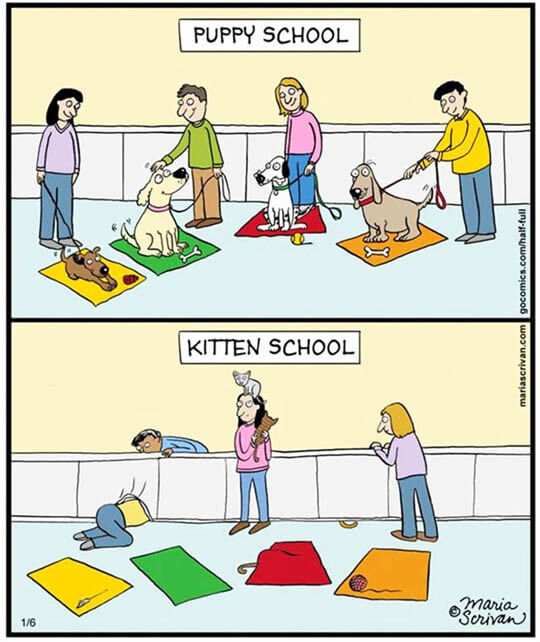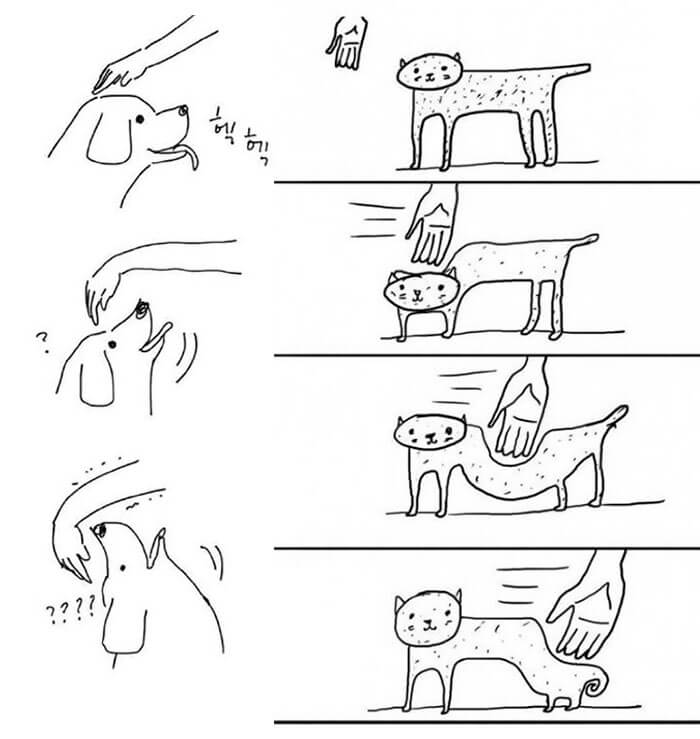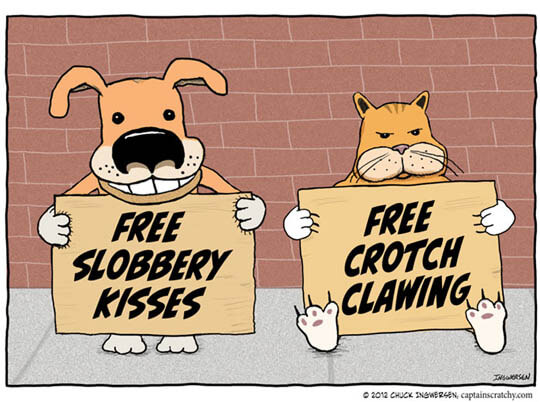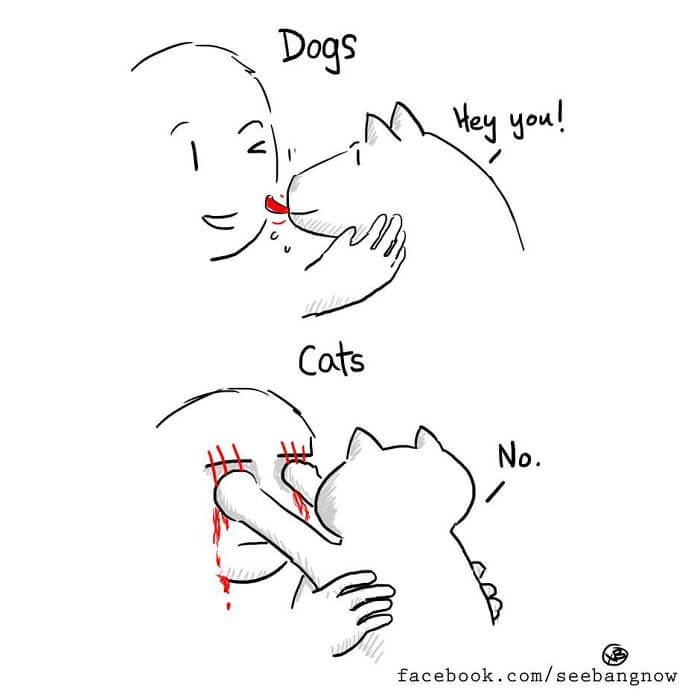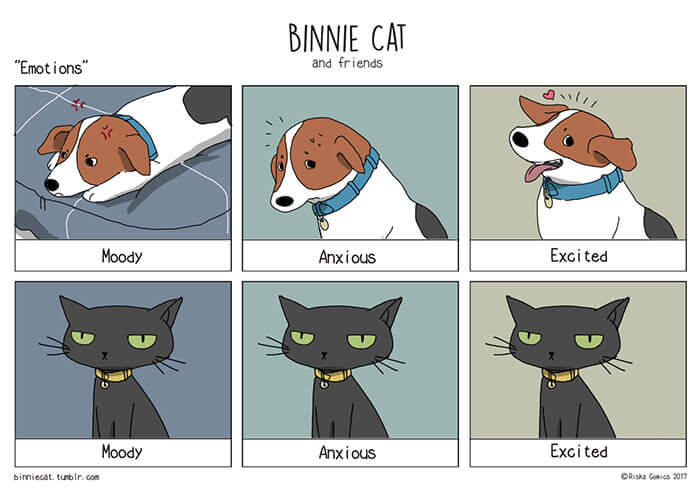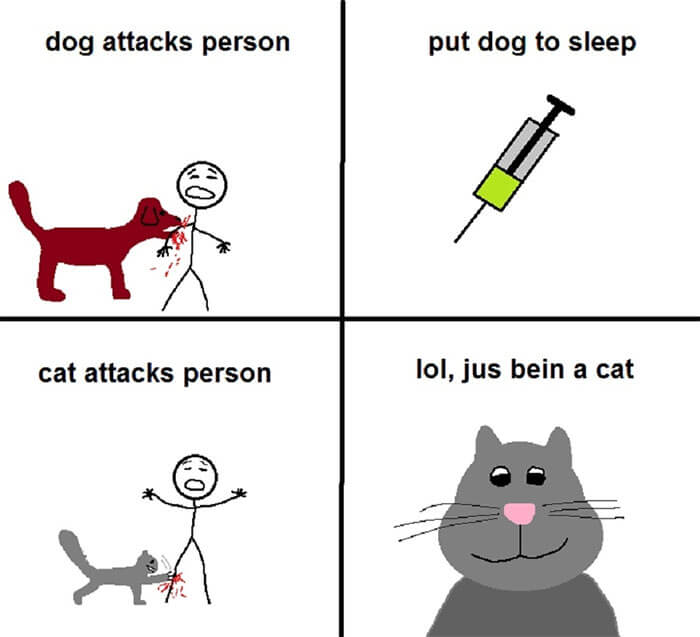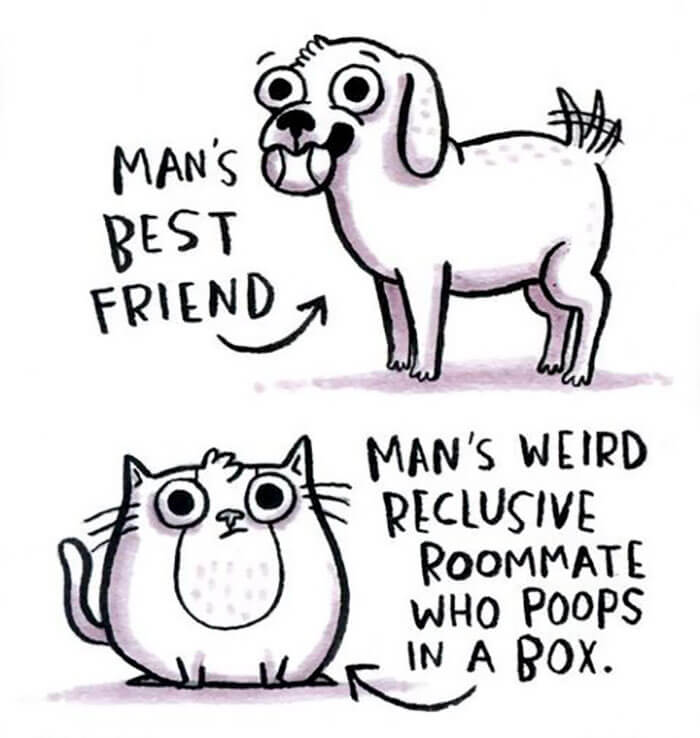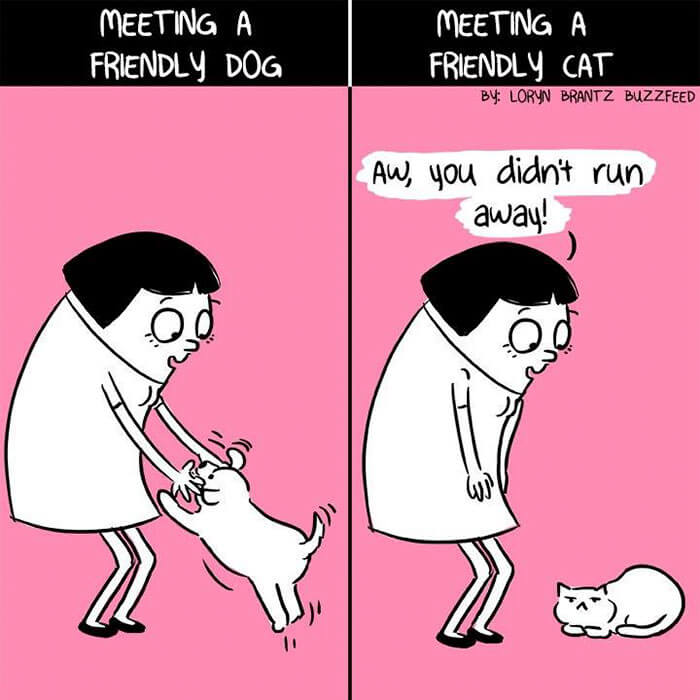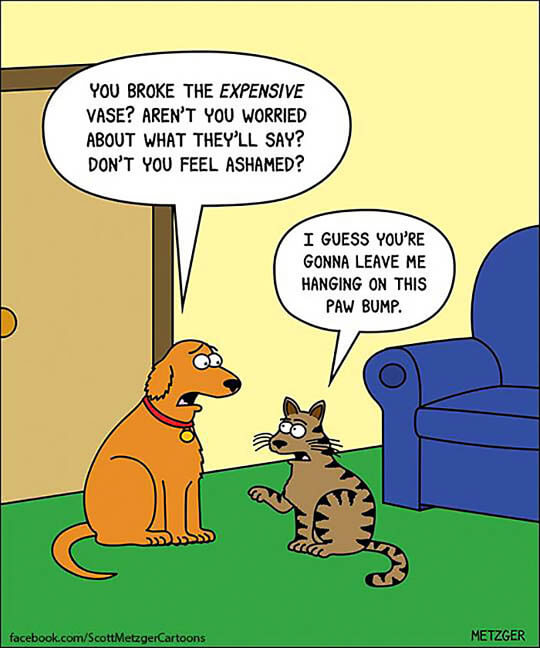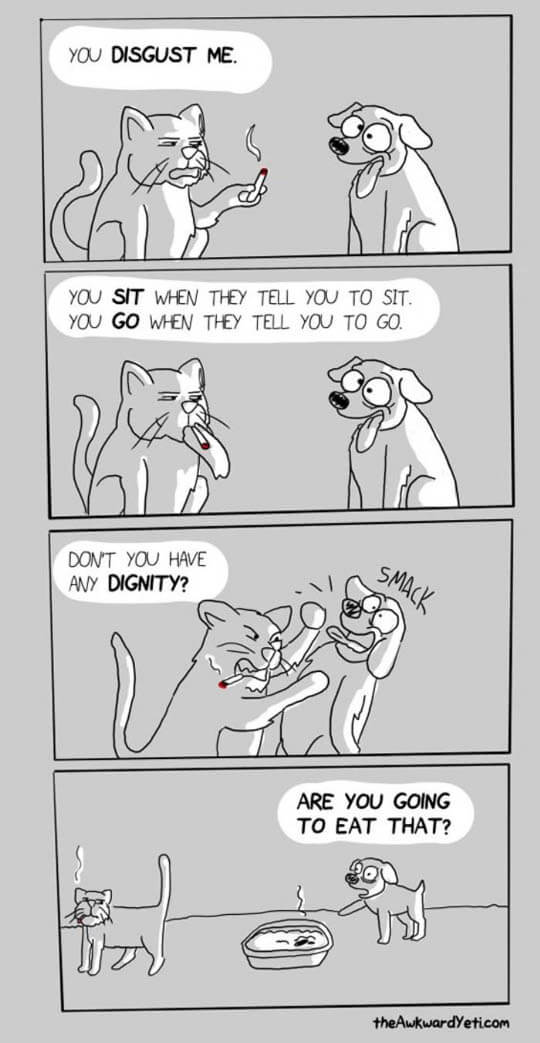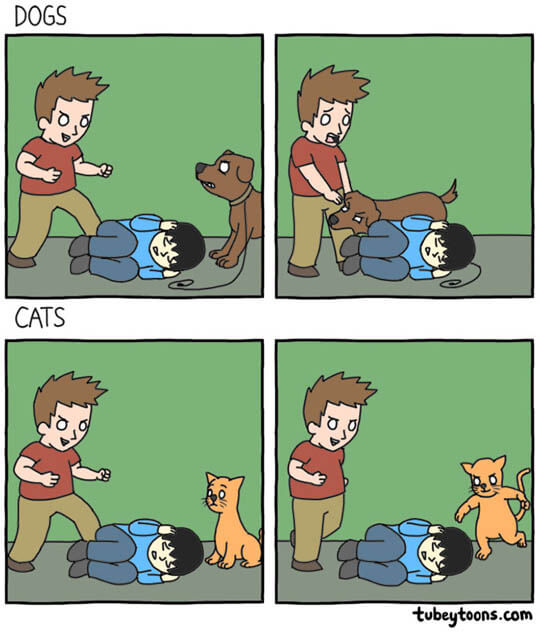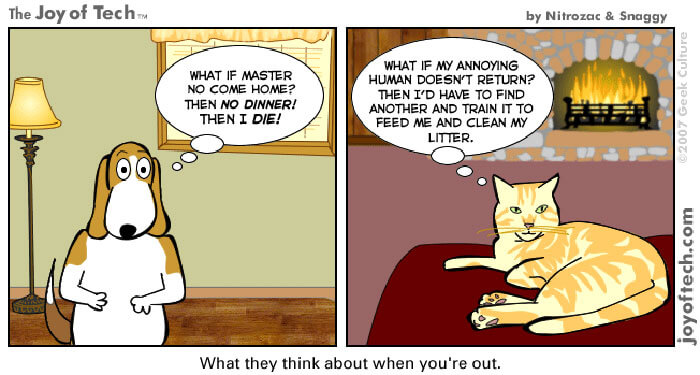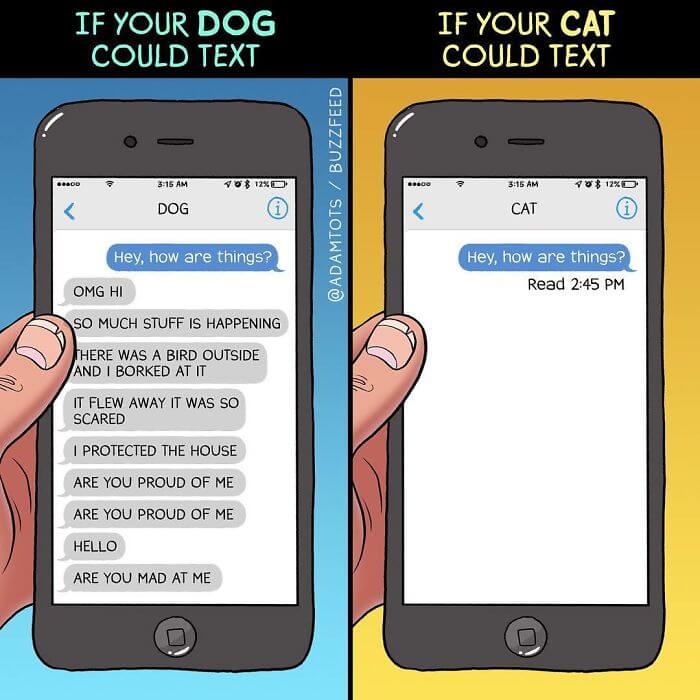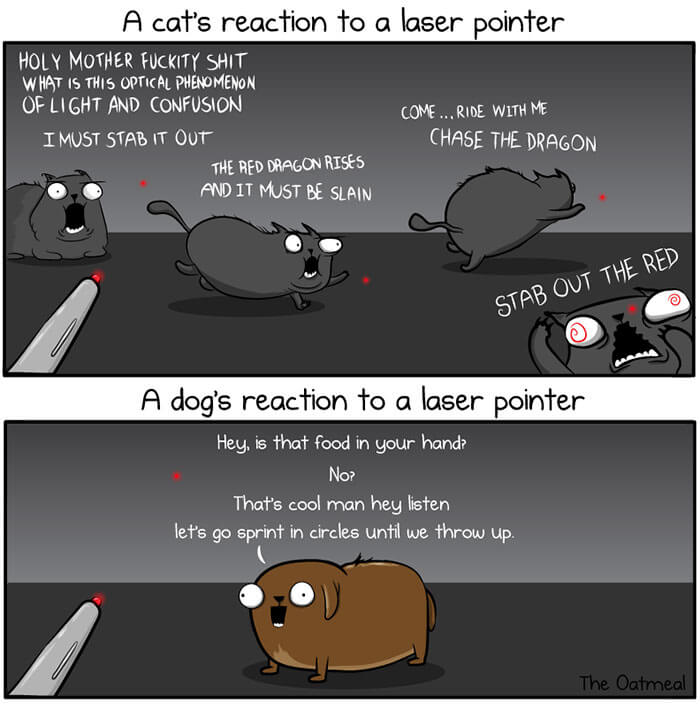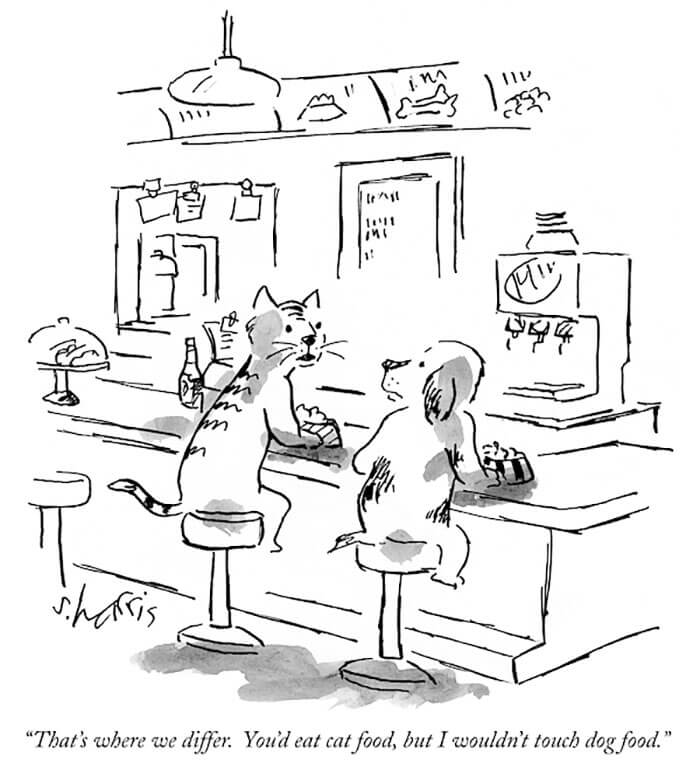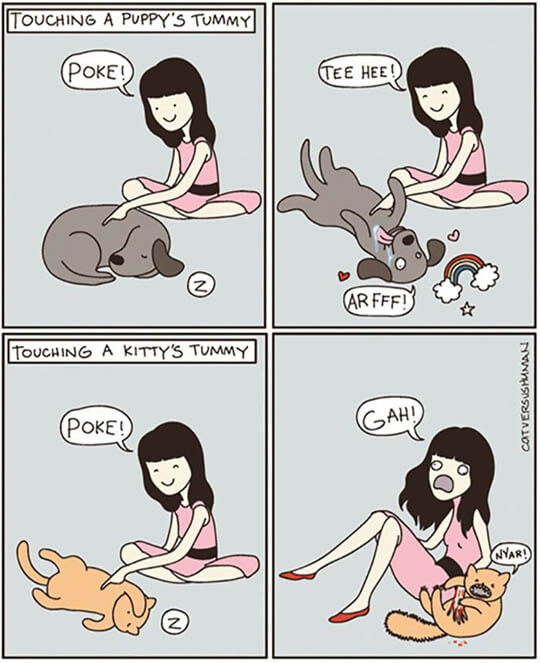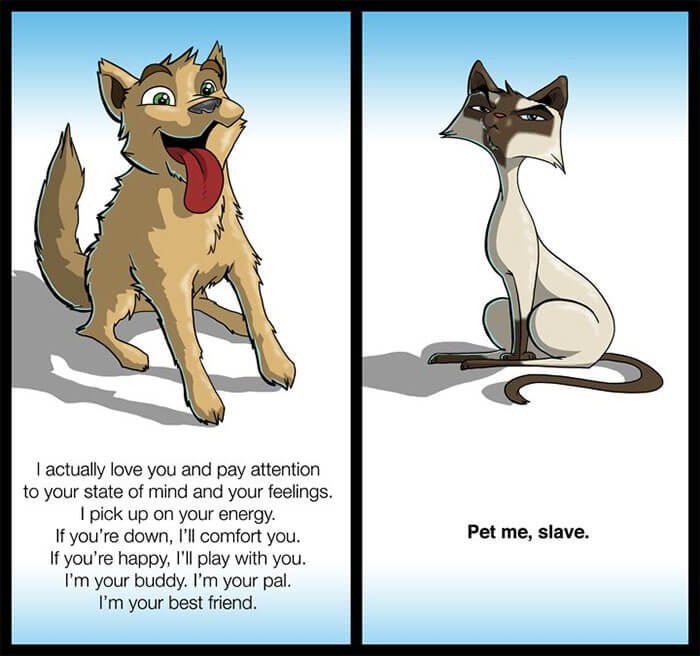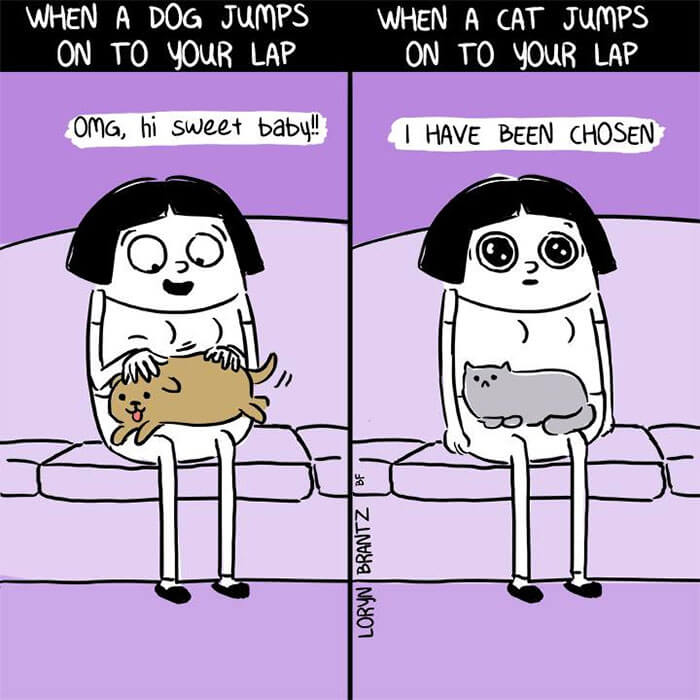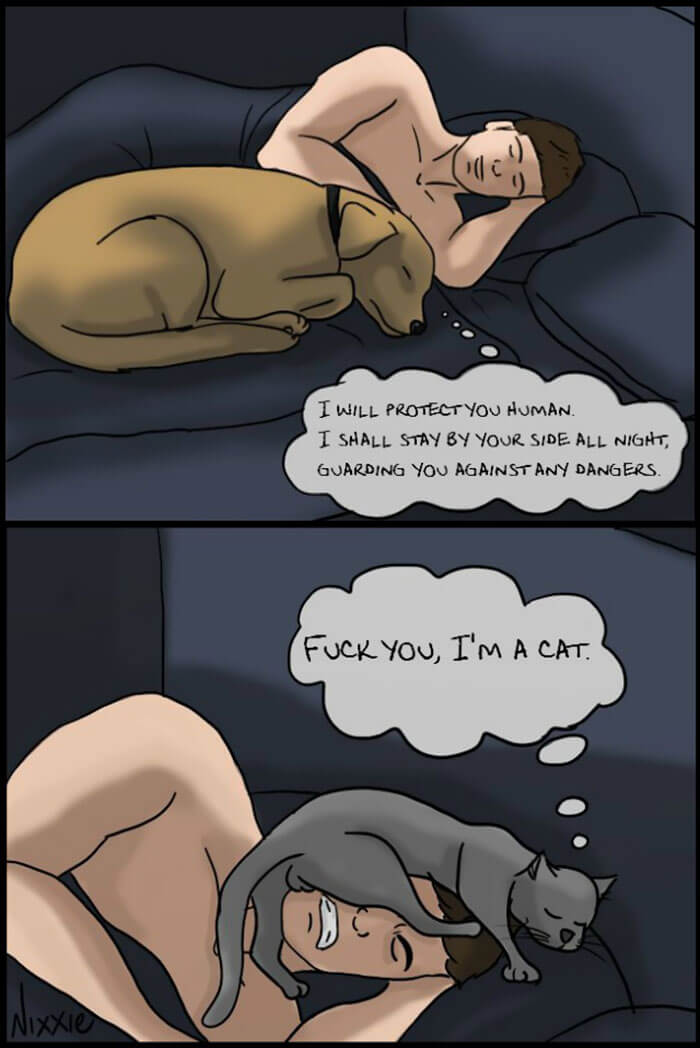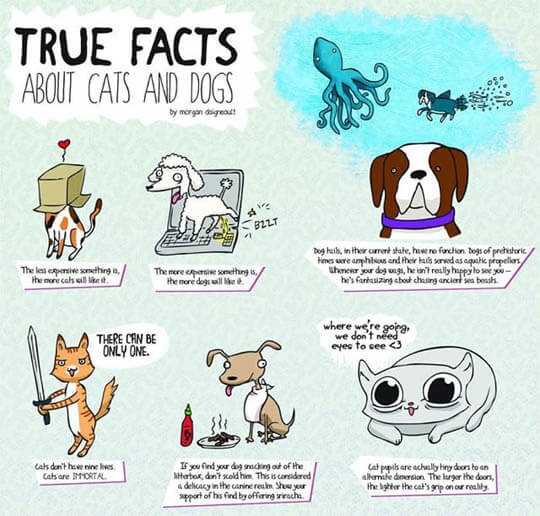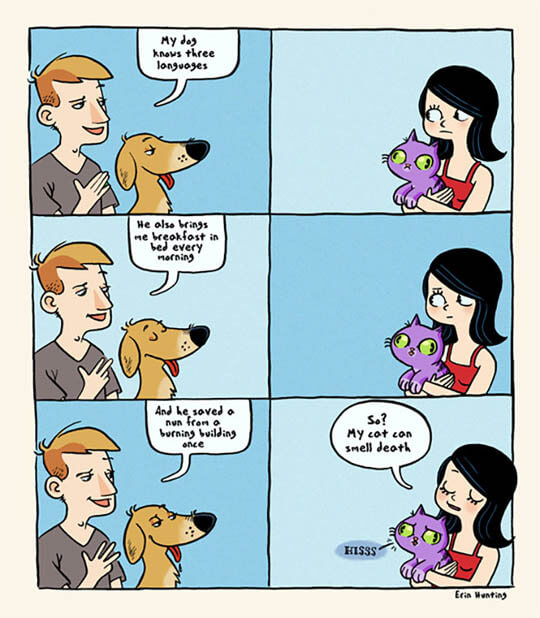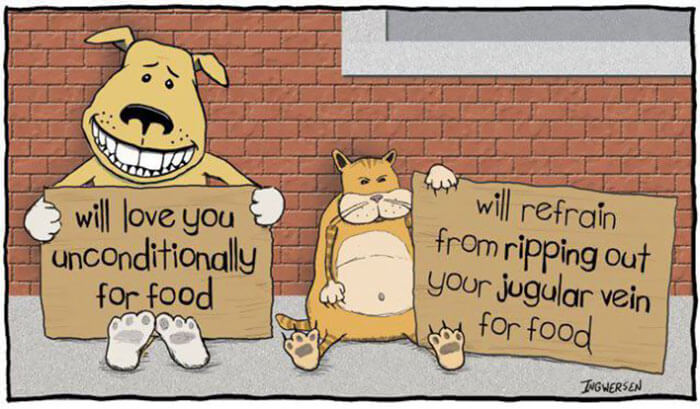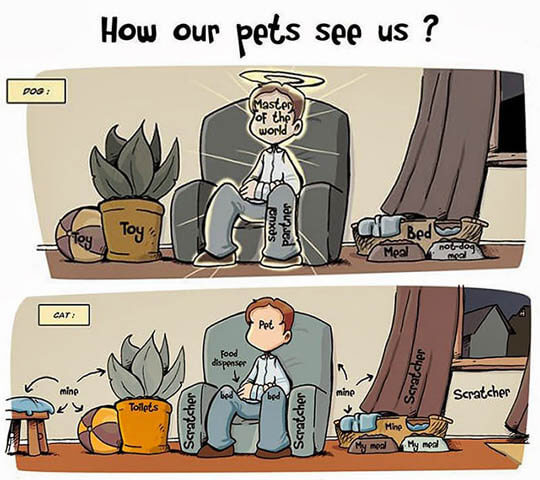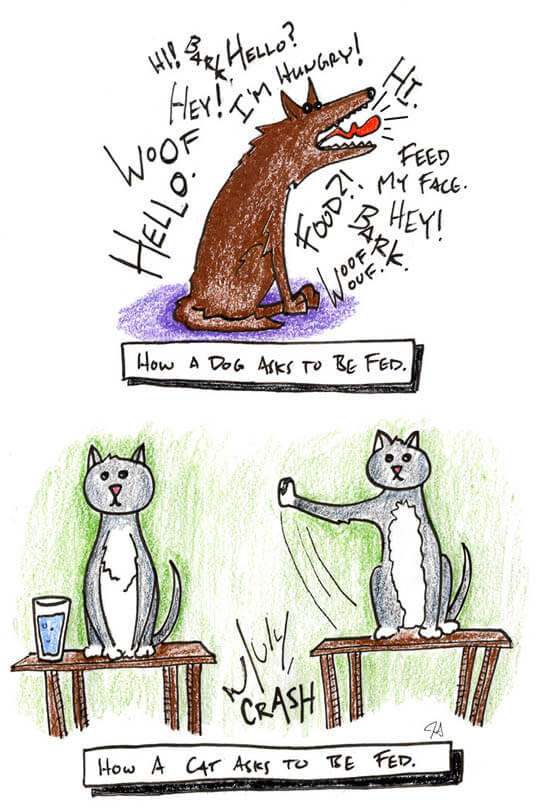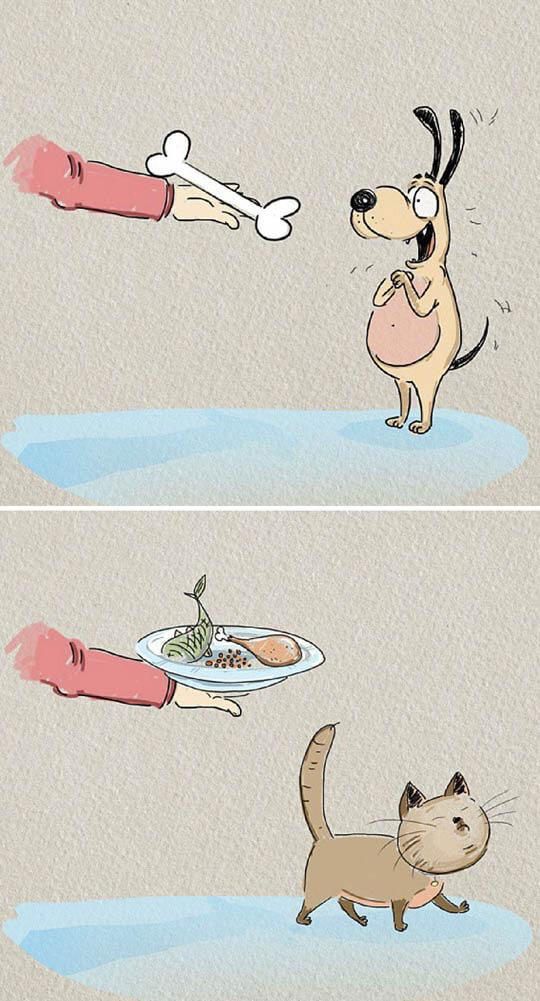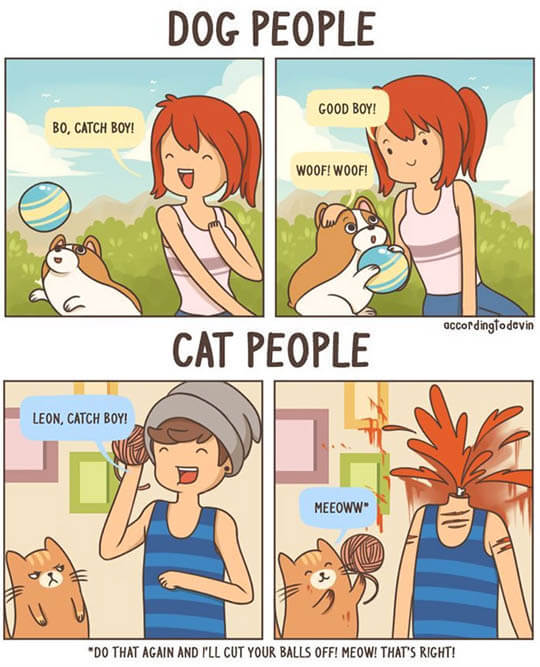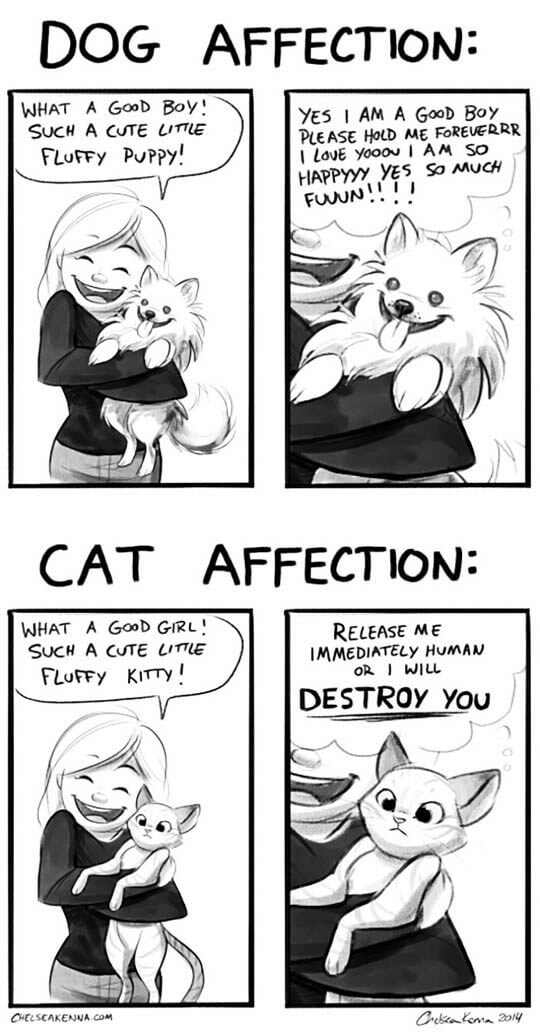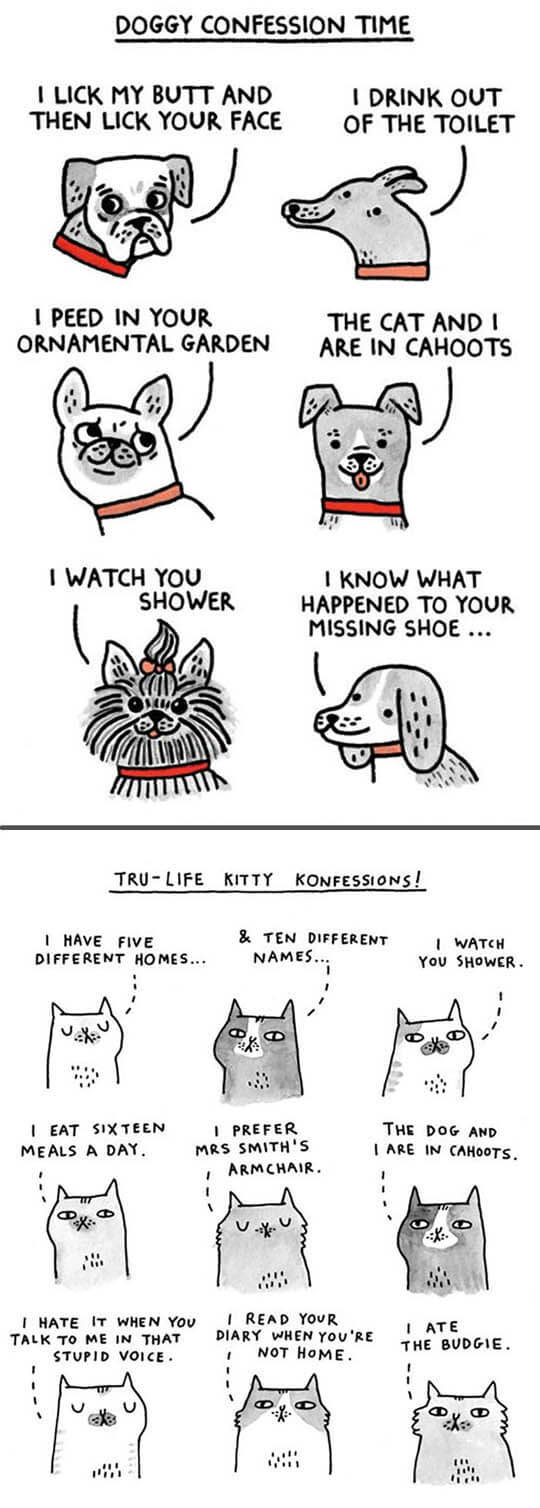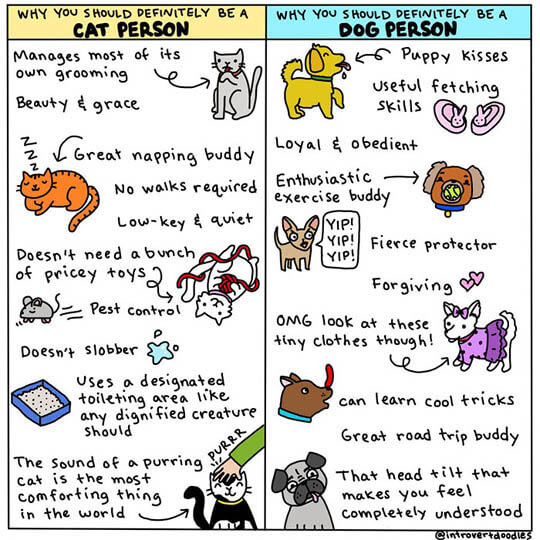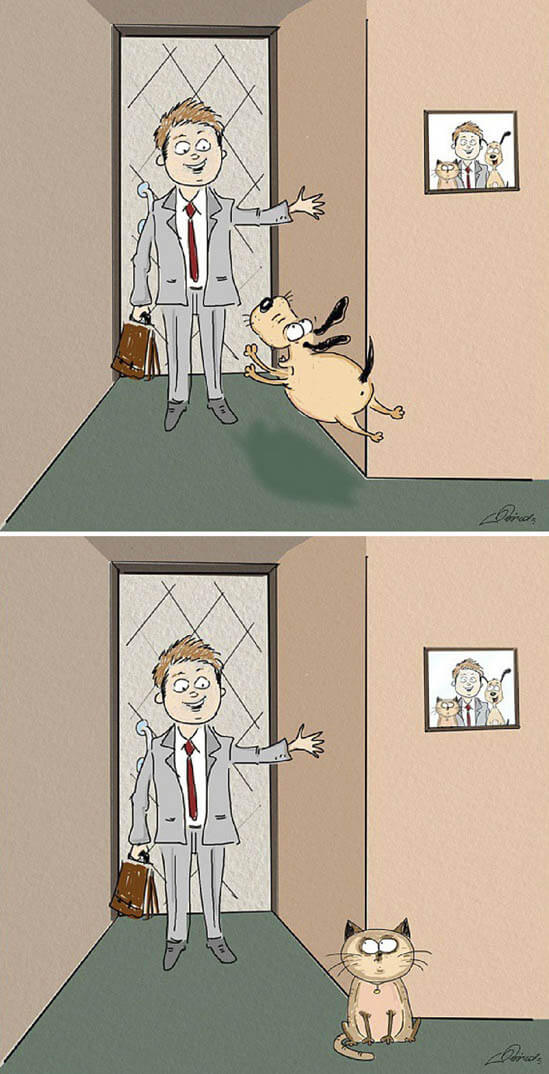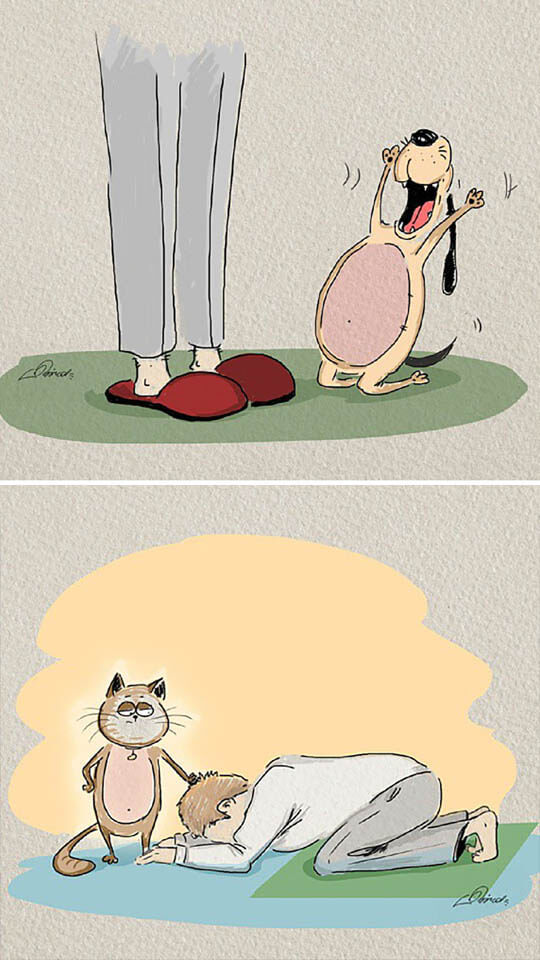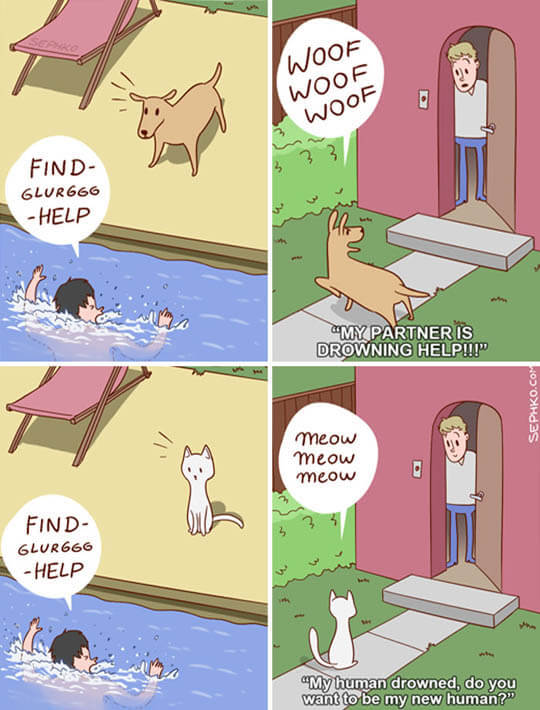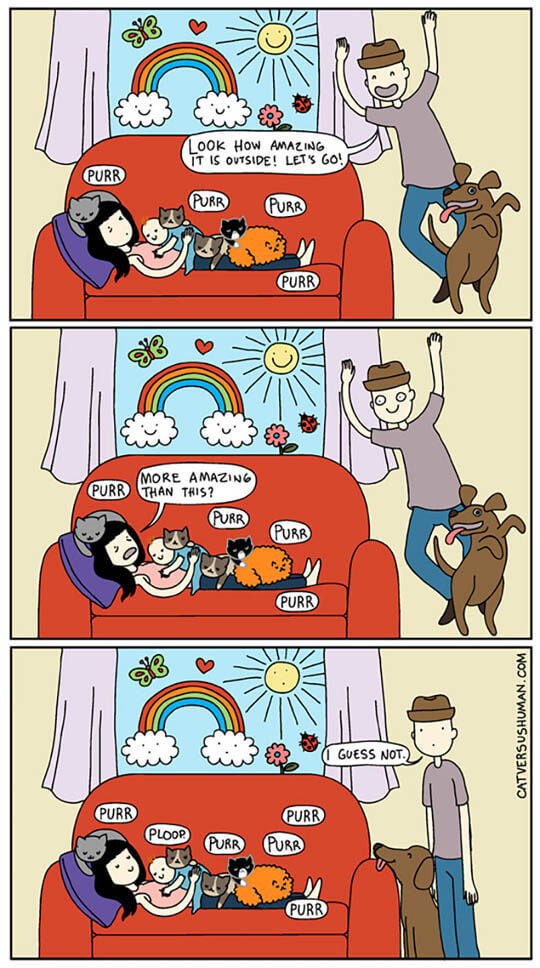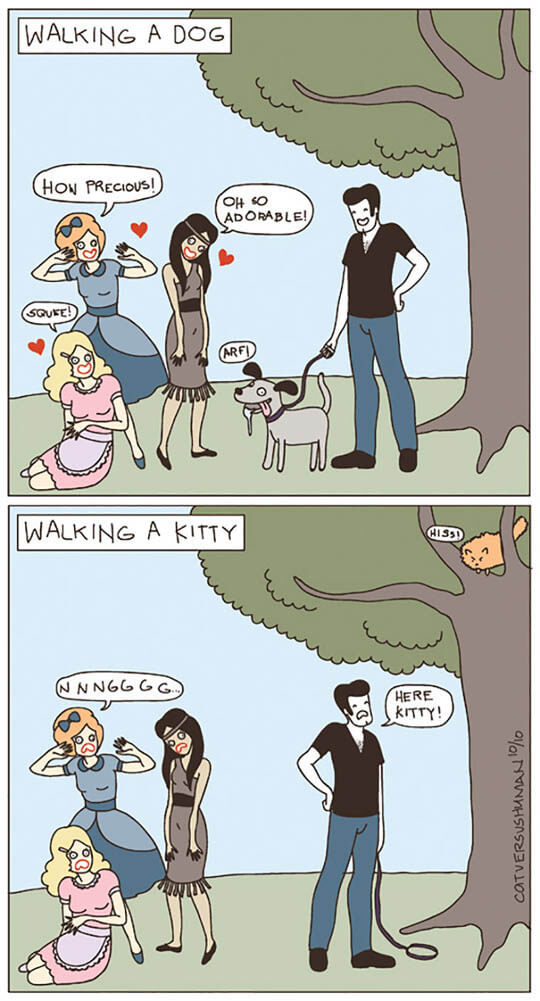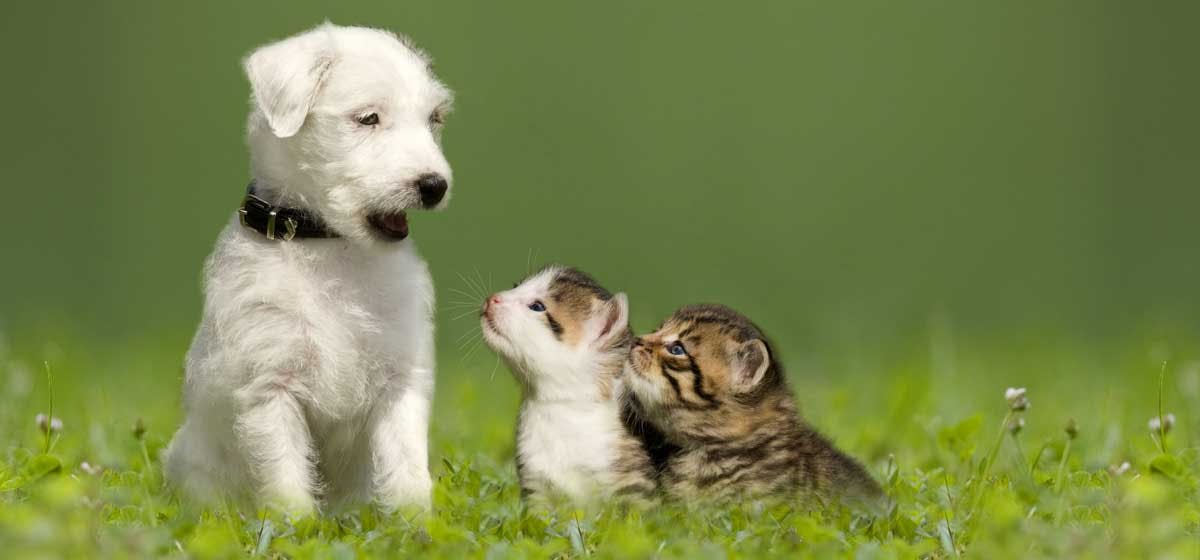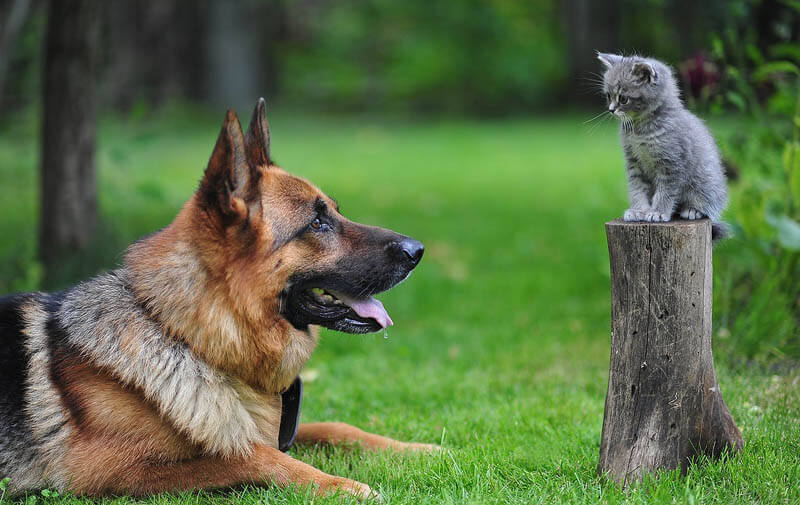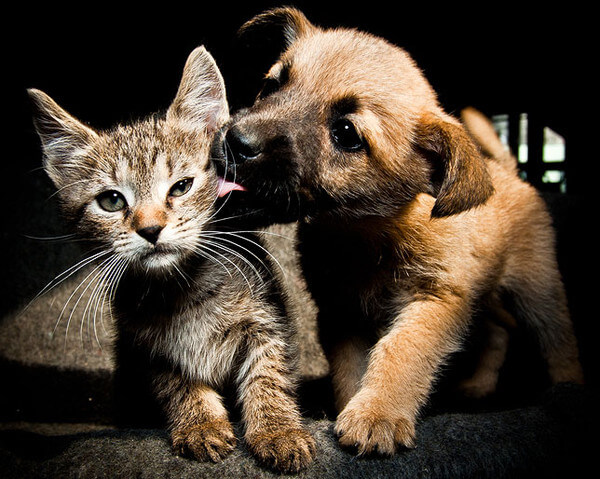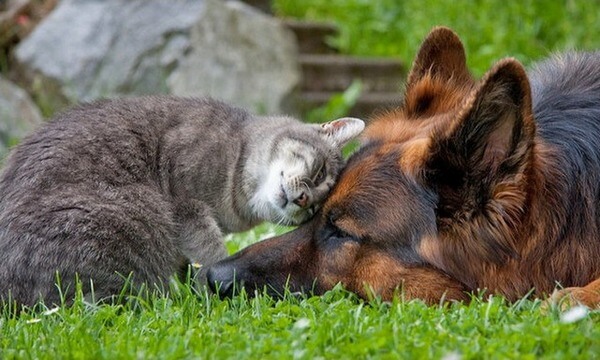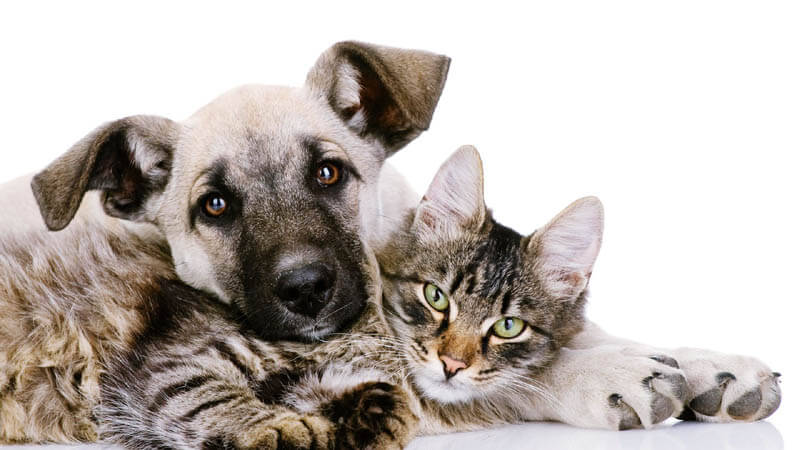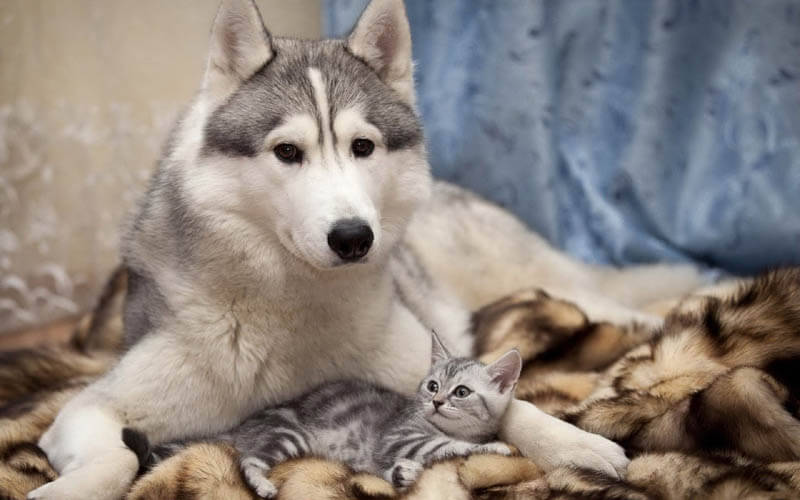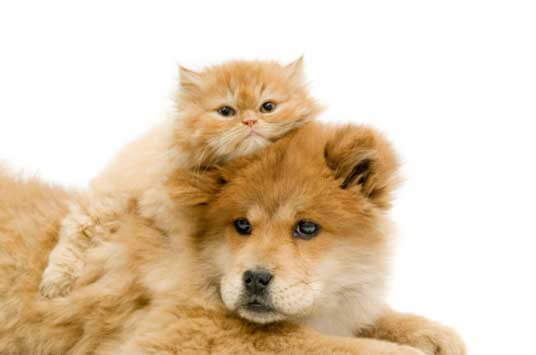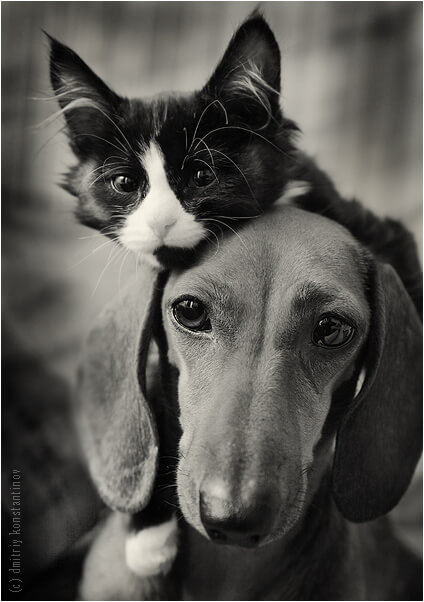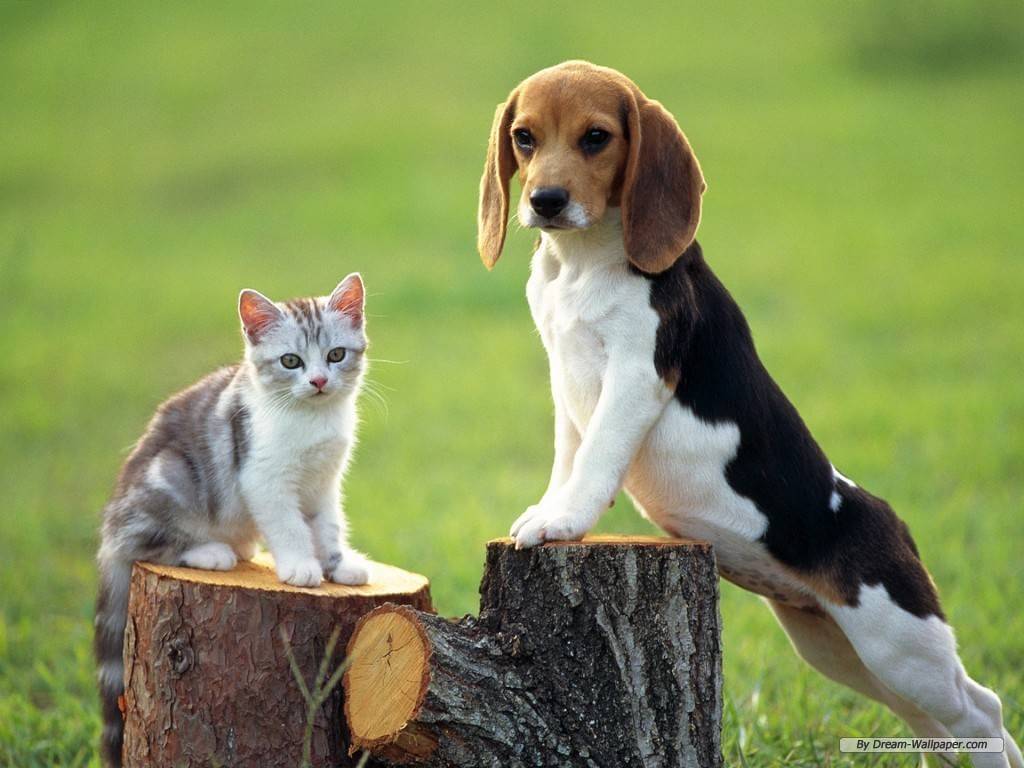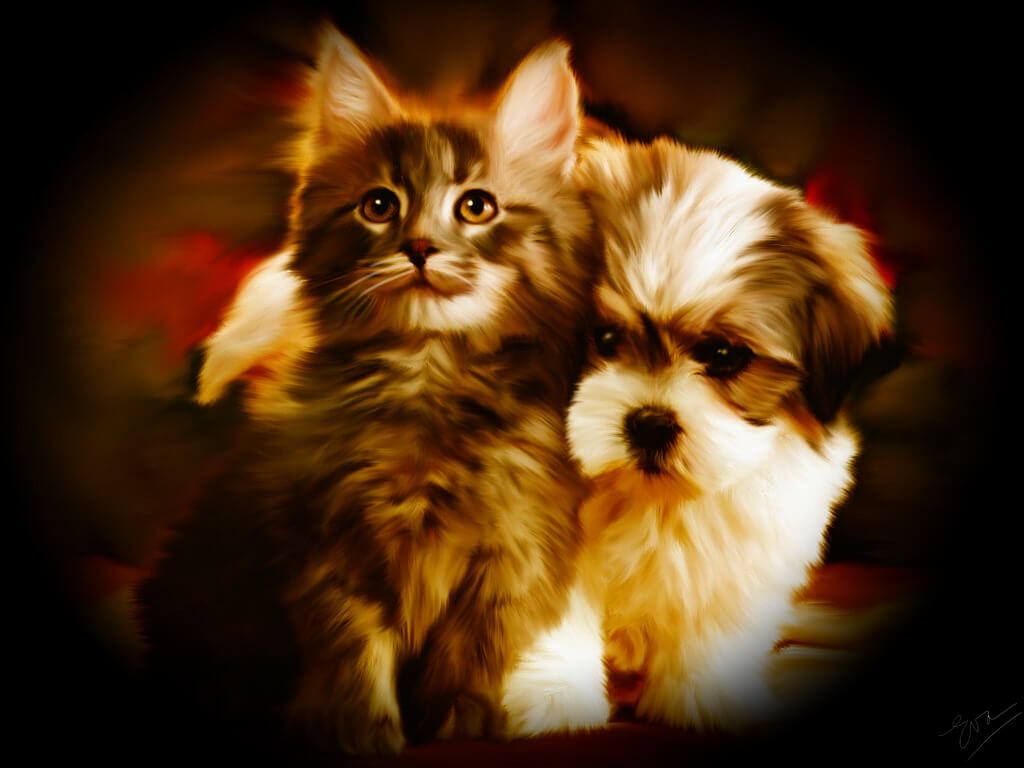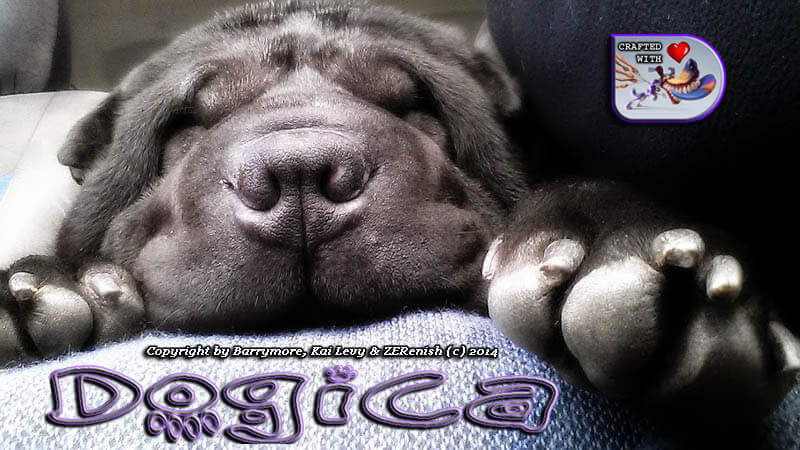


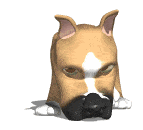

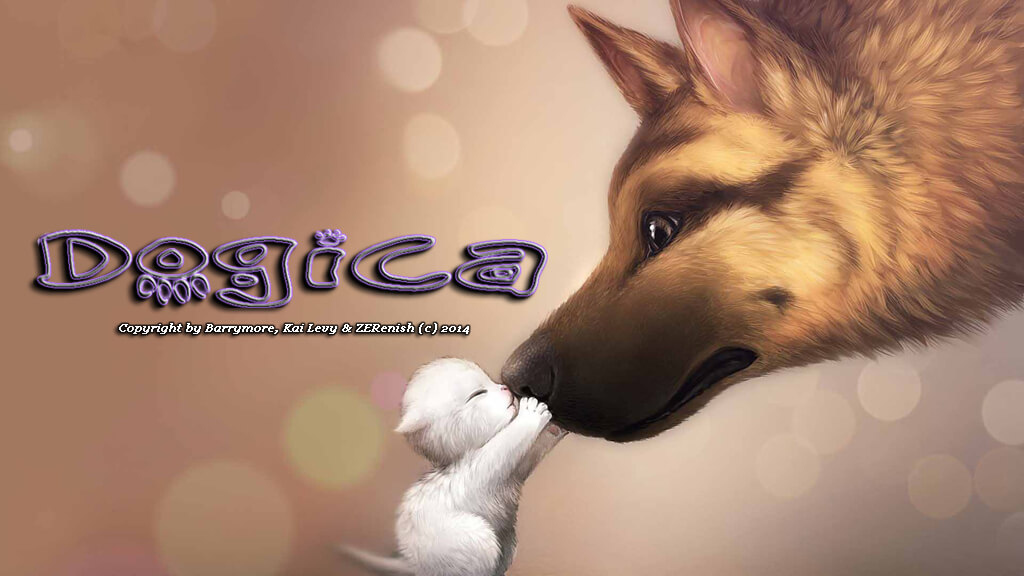
43 Comic & Hillarious Differences between Cat & Dog
|
| Kingdom | Animalia | Animalia |
| Family | Felidae | Canidae (Canis lupus familiaris) |
| Phylum | Chordata | Chordata |
| Class | Mammalia | Mammalia |
| Order | Carnivora | Carnivora |
| Genus | Felis | Canis |
| Species | F. catus | C. lupus familiaris |
| Hunting ability | Cats still have their hunting ability. | Due to their domestication, dogs have a weaker instinct to hunt. most breeds of dog's teeth are too small to rip open a deer's throat, indicating an adaptation to a different diet. |
| Life Expectancy | 12-25 years | 7-20 years |
| Grooming | Less frequent - no baths | Less frequent if short-haired, very frequent if longer-haired to avoid matting |
| Loneliness | Can be left alone during the day | Can be left alone during the day if necessary, but usually require attention throughout the day. Varies widely between breeds. |
| Space | Can live in small apartments | Depends on breed |
| Annual cost | $450 | $660 (varies depending on the breed) |
| Affection | Very affectionate towards owners sometimes, but are more independent | Affectionate if taken care of |
| Protection | Do not guard owners | Some are protective of their owner. |
| Medical Costs | Approx. $160 per year | Approx. $290 per year |
| Good with children | Can be; depends on the cat | If socialized. Some small dogs are OK with children but are fragile if handled roughly. Wait until children are 8 years old before getting a dog. Ironically, some small breeds are the most agressive. |
| House training | Easily trained to use a litter box | One to two weeks, if trained properly as puppies |
| Energy | Generally lazy; can sleep for 16 hours a day | depends on age and breed |
| Walks | Some cats like walks | Dogs need exercise; a daily walk. |
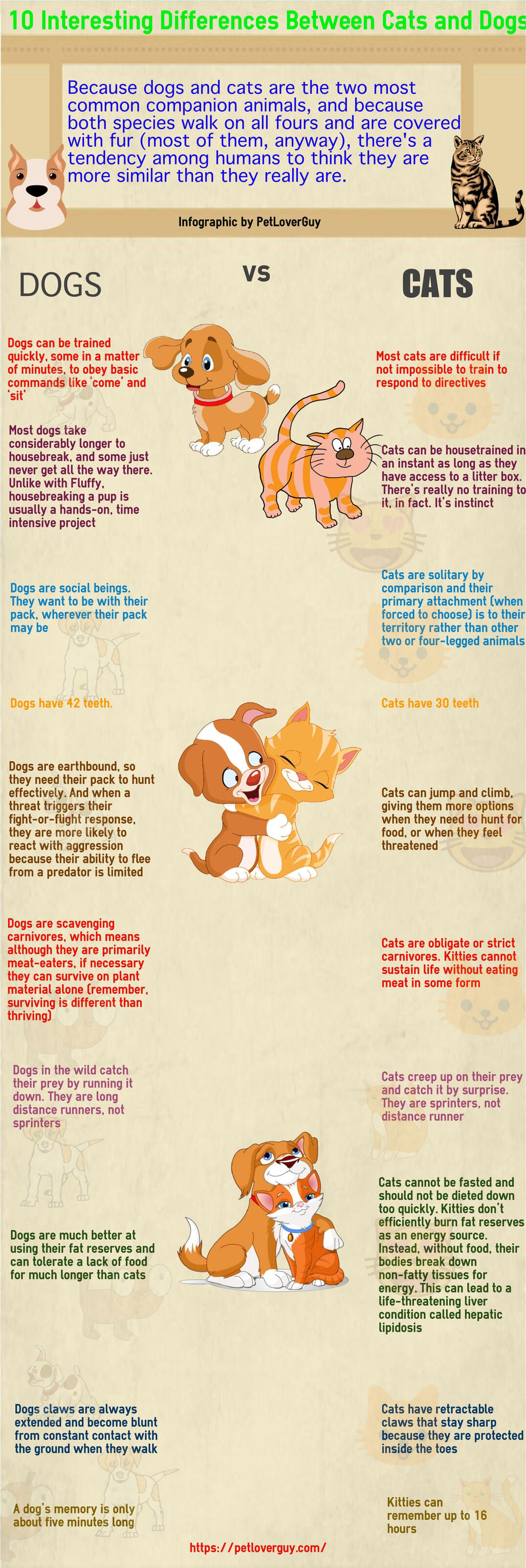



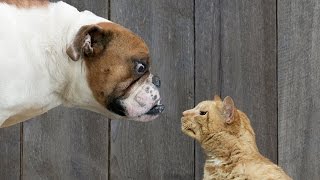

The five senses – scent, taste, sight, touch and hearing – are important tools for survival for humans and animals alike. We know our pets' senses are superior to ours in many ways, but how do the senses of dogs and cats compare to each other – are they the same? Let's take a look!
DOG SMELL
vs CAT SMELL
Our canine friends have an amazing sense of smell, and we use their scenting ability in many ways. However, cats have an even better sense of smell and can identify differences between a larger variety of scents. Mammals have three types of scent receptor proteins in the nose. One of these proteins, V1R, is thought to be responsible for giving mammals the ability to distinguish one scent from another. We have two forms of this protein - dogs have nine and cat have a whooping 30.
Most dog breeds have around 150 million scent receptors in their nose; some breeds, including the Beagle, Basset Hound, Belgian Malinois and German Shepherd, have about 225 million. The Bloodhound takes first prize with around 300 million. The average feline has around 200 million scent receptors. For cats, their nose makes up for a lack of taste buds. They smell their favorite meal rather than tasting it. Because cats can distinguish scents so well, they can be sensitive to some fragrances you use around the home.
DOG TASTE
vs CAT TASTE
Taste buds have an important role in survival by helping mammals detect the difference between safe and unsafe food. We have around 10,000 taste buds, dogs have about 1,700 and our feline friends have around 470. When it comes to taste, humans and dogs can detect five – sweet, sour, bitter, salty and savory/meaty. The ability to taste bitter and sour allows meat eating animals to tell if a food source is rancid or safe to consume. Dogs are considered omnivores, and scientists believe the digestive system of humans and canines evolved together to process carbohydrates. Because cats are obligate carnivores, they must eat meat to survive and can taste energy producing molecules found in meat. Felines can also taste sour, bitter, salty and savory / meaty, but they lost their ability to taste sweet a long time ago during evolution because sweetness was not a taste needed to survive. Both dogs and cats have specialized taste buds at the tip of the tongue that detect water.
DOG VISION
vs CAT VISION
Dogs and cats are crepuscular rather than nocturnal animals. Their eyesight is designed to pick up on the slightest movement in the low light of the twilight hours of dusk and dawn. They can also see ultraviolet light which is invisible to us. Dogs can see blue and red colors, but get confused with the difference between green and red. They can see a hand signal given from a mile away, but it's harder for them to focus on objects right under their nose. When looking straight ahead, canines have a visual field of view of 240 degrees while a cat's is 200 degrees. Binocular vision (when the field of view of each eye overlaps) is important for depth perception. Compared to cats who have around 140 degrees binocular vision, most dogs only have about 30 to 60 degrees. Both species can see motion from the corners of their eyes, but dogs are better than cats at catching subtle movements in their peripheral vision.
Cats have better night vision than dogs and can see things in detail as far as 200 feet away. Felines are a little better than dogs at focusing in on objects up close, but not by much. Cats can tell the difference between blue, yellow and some hues of green colors, as well as blue-/violet, but are more interested in the pattern and brightness of things. Hues of pink and red are harder for them to differentiate. Touch The sense of touch in dogs and cats is comparable. Both have super sensitive whiskers that help them detect the slightest change in air currents and pressure to navigate in their environment as well as to detect prey, predators and obstructions in the dark. Sensitive paw pads are used to communicate, sense the environment, function like shock absorbers and help regulate body temperature.
DOG HEARING
vs CAT HEARING
Dogs and cats use their ears to express emotions, and both have remarkable hearing. Even in the wee hours of the night the world is a noisy place for our pets. Dogs have 18 muscles in their ears allowing them to move each ear independently to better detect where a sound is coming from. They can hear frequencies up to around 45,000 hertz. Cats have an even greater range of movement with 32 muscles that allow them to rotate their ears 180 degrees, and they can hear at higher frequencies than dogs – up to 100,000 hertz. Bottom line – both dogs and cats have amazing senses!
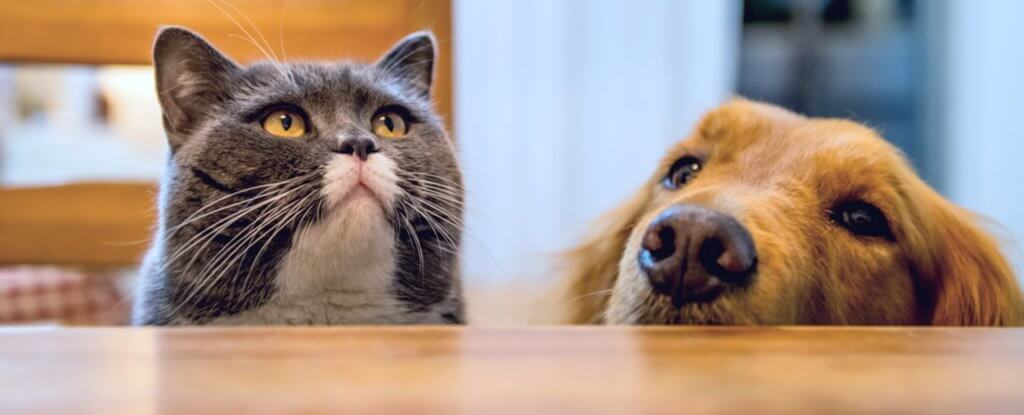
Cats and dogs living together is not necessarily a sign of the end of times. These two species can actually get along quite well despite their significant differences. But how might those differences impact your relationship with your pet or your decision to adopt a companion if you can choose only one?
Dogs Are Pack Animals
In the wild, dogs form packs in which each member cooperates to find food and provide protection. The pack usually has an "alpha dog" that the other dogs look to for leadership. Domestic pups are hardwired with this pack instinct that generally makes them social, friendly, and all too happy to belong to a family or even a single person who can provide him with food and leadership. Dogs instinctively go wherever their pack goes, which makes them more readily accepting of experiences, such as travel or moving. This pack mentality also makes it really hard on dogs to be left alone, especially for long periods of time. Dogs crave closeness and attention. Having a dog may be comparable to having a young child.
Cats Are Lone Hunters
By contrast, with the exception of lions, most cats in the wild are solitary nocturnal hunters. Unlike dogs, cats are able to jump and climb, which aids them in hunting and makes it easier to flee from danger. Their sharp, retractable claws provide a distinct advantage when it comes to catching prey and defending themselves from bigger predators. Because of this, cats have no need to work together to care for themselves. It also makes them territorial. For domestic cats, these instincts make them much more independent than dogs. This independence may make them seem aloof. They often sleep during the day and like to roam the house at night. Cats not only like their space, but they might be prone to marking their territory by spraying outside their litter box, especially prior to getting spayed or neutered.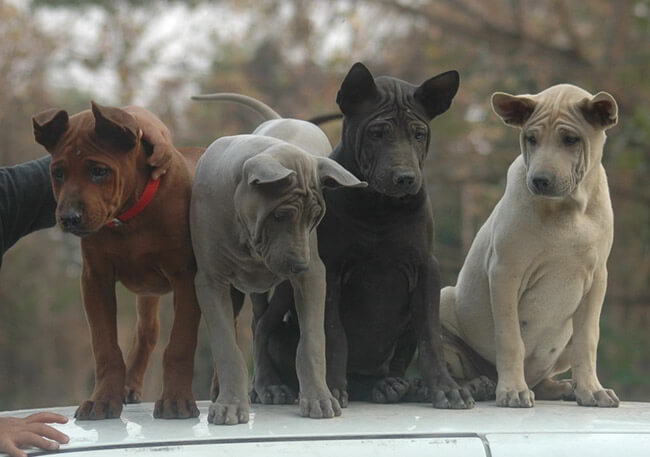
This territoriality makes big changes like moving or simply rearranging the furniture a source of stress. While a cat's independent nature generally helps them deal better than dogs with being left alone, it's important to remember that all cats are different. Some breeds are more sociable than others. Cats are capable of developing extremely strong bonds with their people. When a cat's favorite person disappears, she may develop separation anxiety, especially if she is passed from owner to owner. Cats are also highly intelligent creatures, and while they have a hunter's mentality encoded in their DNA they also know who feeds them and provides them with play. While cats might not be as affectionate as dogs at first, overtime cats can develop quite the liking to their human parent fully equipped with a snuggling purr machine movie night. Cats also tend to live longer than dogs, which is sometimes a consideration when searching for a lifelong furry companion.
Training: Cat vs. Dog
When it comes to cat vs. dog training, dogs are generally the easier of the two to train. A dog's pack mentality makes him ready to follow a leader and makes him generally more obedient by nature. Typically, dog training is a process of teaching and reinforcing commands that help you communicate your desires to your dog. Dogs are so eager to please that they're happy to meet those desires. However every dog is different, and some breeds have temperaments and learning aptitudes that take more readily to training than others. Cats can be trained, but not as thoroughly as dogs. It requires a lot of patience and consistent practice to get past their willful nature. With cats, it's best to focus training on establishing boundaries.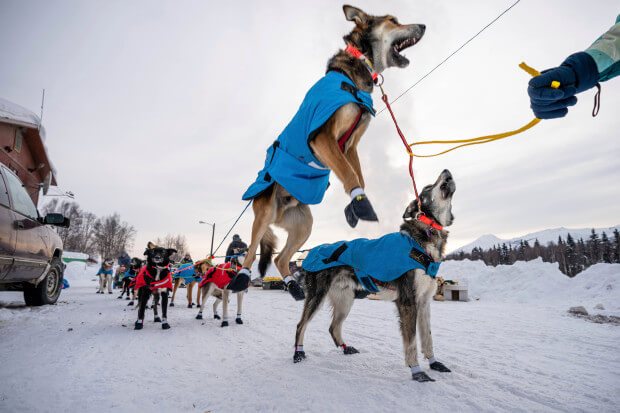
When it comes to house training, cats have the advantage over dogs. Cats use the litter box instinctively. It may only take showing them where the box is one time. If a cat is slow to catch on to using the litter box or appears to forget later on, this is often a sign of an underlying health issue, and you should consult your veterinarian. Dogs, on the other hand, can be a lot tougher to potty train, especially puppies. Teaching them where it is and is not acceptable to go usually takes a lot of repetition and positive reinforcement.
Space Considerations
While dogs can be perfectly happy living in a small apartment, they still need their outdoor exercise. If you lead an active lifestyle and can take your dog on walks or let him out in the backyard to run around and play a dog can be a great fit. However, if you live in a small apartment a cat can be an excellent companion. Cats generally get their exercise through play: an excellent bonding opportunity between you and your cat and through their general hunting nature where they will stalk prey - toys in this case and leap up high in trees - cat trees that is! Because of this, cats don't usually need as much area to roam around. In fact, in a large house you might lose your cat for a while as they can be excellent hide & seek players.
The Costs
It is true that cost should be considered when choosing to adopt a pet. Dogs often tend to be more expensive to care for than a cat between food, toys, training classes, daycare, and vet bills. Because cats are independent by nature they have learned to care for themselves and generally only rely on their human for food. Even play stimulation can be as simple and cost effective as a flashlight or a feather tied to a stick.
So.. Which Is the Best Pet for Me?
Cats and dogs are not the only ones with different temperament and personality traits. According to Psychology Today, cat parents and dog parents also differ significantly in these areas. The majority of people who keep cats exclusively tend to be more introverted, less sociable, and more self-contained, whereas dog parents are more social, interactive, and open to new experiences.
Whether your personality more closely aligns with that of the typical dog person or the typical cat person, the main thing to keep in mind is that a dog will likely require quite a bit more of your time and attention than a cat. If you are looking for a companion that will sit by your side, then a dog might be your best bet. Cats can be quite affectionate and attentive, but only up to a point. They tend to become bored or overstimulated much more easily than dogs, and at that point they want to escape for a while. So, if you prefer a pet to keep you company but is not especially needy, consider a cat.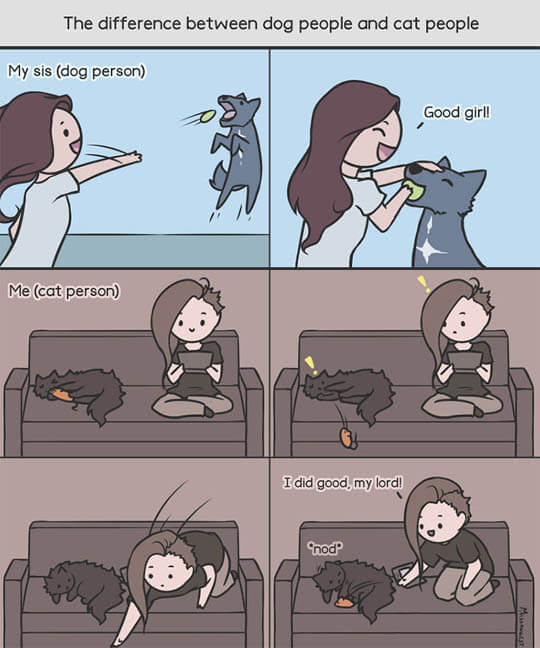
Again, these are all generalities. Remember that cats and dogs are not only different species, but they are individuals within each of their species and some of these generalities might not apply to individual pets. Factors such as genetics, breed, breed temperament, and the animal's history all play a part as to how friendly, sociable, and teachable he will be. Wherever you side on the cat vs. dog debate, it is important to research your choice of pet before welcoming him to his forever home. Consider dog or cat sitting for a friend or family member to see if you prefer the companionship of one over the other. Then, make sure to go spend some time at your local animal shelter before you make the ultimate decision to adopt. You might find out that it is not the species that helps you make up your mind, but rather the bond you form with one of the animals. No matter which species you choose to adopt, with enough love and affection, you will surely find a forever friend.

1. Basset Hound
This breed is known for its laid-back and easygoing nature, which is naturally helpful with skittish cats. The dogs’ low energy levels make them less likely to chase or insist on playing if your cat is not so inclined. Basset Hounds also tend to respect space and boundaries, which is important for successful integration with cats. Though bred for hunting, Basset Hounds tend to be calm and non-aggressive on their own.
2. Beagle
Beagles are friendly dogs that typically enjoy the company of both humans and other pets. With proper socialization, Beagles can develop great friendships with cats and can learn to live harmoniously, especially when raised together from a young age. Beagles have historically been used as hunting dogs, however, so it is important to establish appropriate behavior early on in your household. Introducing Beagles to cats while they are still puppies (and smaller than the cat) is a good idea. That said, it's worth noting that they typically only display hunting / aggressive behavior when in packs, so solo Beagles are likely to do just fine with cats.
3. Bernese Mountain Dog
These large, fluffy dogs tend to be friendly and confident, which can be a perfect match for an assertive cat. Initially, your cat may be wary of a Bernese Mountain Dog due to their larger size, so cautious introductions are key. However, they do not have a strong prey drive, so it’s certainly easier to train them to live with cats than other big dog breeds.
4. Bichon Frise
The Bichon Frise is known for their cheerful disposition and love for social interaction. Their friendly nature and gentle temperament allow them to bond with cat siblings, enjoying companionship and cuddle sessions together (cat permitting!).
5. Bulldog
The lazy nature of this stout breed make them great housemates for cats. A smaller type of Mastiff, the Bulldog is known for its sweet, affectionate, and non-aggressive nature — a great match for the nervous cat who isn’t sold on the idea of a new sibling.
6. Cavalier King Charles Spaniel
Despite their overwhelmingly regal name, Cavalier King Charles Spaniels are non-fussy pups who can adapt to a variety of environments and situations. Accordingly, they typically get along well with cats when properly introduced. With their gentle temperament, Cavaliers often form strong bonds with their feline friends, enjoying companionship and playtime together.
7. Golden Retriever
Known for their friendly and gentle personality, Golden Retrievers are often a great match for cats. With proper socialization, Golden Retrievers can live very well together with cats, enjoying their company without exhibiting predatory behavior.
8. Labrador Retriever
Labs are the quintessential pet, full of love to give and great around humans and other pets. They are known for being very trainable and are often able to understand the boundaries often set by their kitty companions.
9. Maltese
Maltese dogs are gentle and affectionate and often get along well with cats. Their small size and non-threatening demeanor put cats at ease, fostering positive relationships between the two. And with their playful and outgoing nature, Maltese enjoy engaging in interactive play with their feline housemates.
10. Miniature Poodle
Mini poodles are intelligent and adaptable dogs that generally cohabitate well with cats. Their non-aggressive nature makes them quite suitable companions. Training and socialization will create the best opportunity for mini poodles to reside with their cat siblings.
11. Newfoundland
Newfies are sweet and full of fluff and would love nothing more than to be the center of attention, getting all the pets and scratches. Their patient and calm demeanor pairs purr-fectly with the personality quirks of cats.
12. Pekingese
With the charming and borderline-royal appearance of the Pekingese, you'd think they would be picky with cats, but that's not usually the case with this dog breed. They are known to be both loyal and independent, while also extremely laid-back — which complements living with the more reserved cat counterparts very nicely.
13. Pug
Pugs are undoubtedly full of love, and cats can make for their perfect, unlikely friend that matches their size. Pugs are usually calm and easy to please, but able to stand their ground firmly against their bossy cat friends. Being such social dog breeds, pugs can get along well with most any pets.
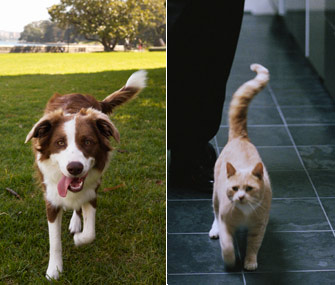
Can cats and dogs ever be friends? Some can, while others will fight like — well, like cats and dogs. Why the inconsistency? The problem may be that the two species don't always speak the same language. Cats and dogs communicate with us and with each other, through body language. When using body language to interpret what our pets are saying, it is important to consider both the context and the pet's individual personality. While certain physical cues commonly appear in both cats and dogs, those cues don't always mean the same things, and it's important to know the differences in order to better understand your cat or dog.
DIFFERENCES OF
BODY LANGUAGE & SIGNS
Here are a few examples of behaviors that may communicate dramatically different things for each species:
Tail Held High:
When a cat holds her tail high, it can signal that she is friendly and relaxed. The higher the cat's tail, the more confident she may be. However, if her tail is raised high with the fur erect and puffed out, it usually indicates alarm or potential aggression. As she becomes more unsure or fearful, her tail is more likely to slink lower.
When a dog holds his tail high, on the other hand, it often signals high arousal and the possibility of aggressive behavior. A dog that is agitated and about to aggress may also flick his tail back and forth vigorously. A dog is more likely to carry his tail in a neutral position, extended out behind him, when he is relaxed.
Wagging Tail:
Friendly dogs wag their tail loosely back and forth at medium height. When a cat's tail begins to wag back and forth, an unfriendly encounter or predatory attack is likely to occur.
Closed Mouth:
Relaxed Cats have closed mouths, Relaxed Dogs may have a closed or partially open mouth. The more tense a dog is, the more tightly closed his mouth becomes, although a very stressed dog may pant heavily or yawn.
Ears Up for Greeting:
A cat who is confident greeting people will normally hold her ears forward and alert. If her ears move backward or twitch, it may indicate uncertainty or that the encounter is not going well. By contrast, one sign of a friendly dog is that his ears move back just slightly. A submissive dog will move his ears back even further as an appeasement gesture. Dogs with erectly pricked ears may be ready to stand their ground against another animal if necessary. but this behavior is specific to the individual dog.
Turning to The Side:
Both dogs and cats turn their bodies to the side when attempting to shut off a potential threat. A dog may do this in order to show that he means no harm, while a cat may be trying to appear larger and more threatening to her opponent.
Lying Belly Ip:
A dog is likely to lie on his back as a submissive greeting behavior or as a way to get his belly rubbed by someone he's close to. A cat, on the other hand, will lie on her back in self-defense; this position allows her to have all four paws, with claws drawn, ready to react to any threat. A cat will sometimes lie on her back for people she's close to, but very few cats actually enjoy having their belly rubbed and may respond aggressively.
SIMILARITIES OF
BODY LANGUAGE & SIGNS
Sometimes Your Cat and Dog Are Speaking the Same Language. Your cat and dog may not always be on the same page, but they do share some behaviors. Here are a few that they have in common.
Ears Upright:
Cats and dogs both communicate through their ears. When they are relaxed, their ears usually point forward. When they are really excited or interested in something, their ears are likely to move all the way forward and upright. When the ears move backward and are flattened against the head, there's often underlying fear or submission.
Raised Hackles:
When cats and dogs are feeling frightened or overstimulated, the hair on their back and tails fluffs out and stands on end. In both dogs and cats, hair standing on end indicates an animal ready to react.
Pupil Dilation and Blinking:
A cat's pupils dilate when she is afraid or is getting ready to attack. Similarly, a dog's pupils will dilate when he is fearful or aggressive. Dilated pupils can also indicate high arousal in both species. Eye blinks in dogs and cats indicate the desire for a peaceful greeting, while direct eye contact, without blinking or looking away, can signal a challenge in both dogs and cats.
Compacted Body:
When a dog or cat is afraid of something, he will make his body appear as small as possible, usually with the head held low. Similarly, both dogs and cats curl their tails underneath their bodies to indicate extreme fear.
Whiskers Stiffened:
Dogs and cats both have a normal height and structure to their whiskers. When they are stimulated by something and are about to react, their whiskers are more likely to stiffen and extend outward.
Panting:
Panting can indicate various things in dogs, but in both species it can mean that the animal is highly stressed or frightened. Panting in a cat that is not interacting with another animal or in a fearful situation may indicate a serious health condition, and a veterinarian should be contacted immediately.
Yawning:
While yawning in dogs can indicate stress, both dogs and cats may yawn as a calming behavior in conflict situations.
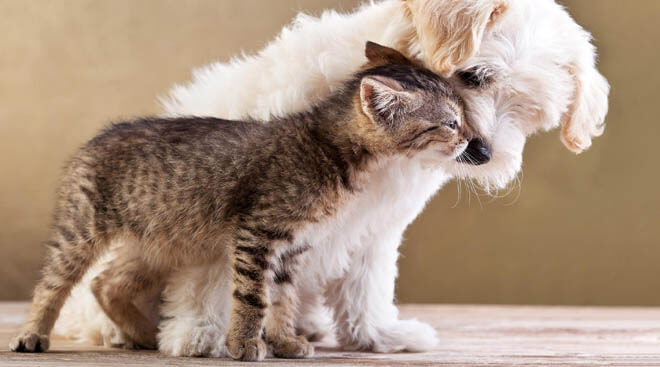
You want your dog to be peaceful with cats! You want your dog to get along with your own cat and leave other cats alone. By teaching your dog to respect cats, you are keeping him safe. A cat's claws carry lots of bacteria, which means cat scratches can become seriously infected. Also, dogs who become obsessive cat chasers will dash through open doors, leap from car windows, climb over fences, and rush heedlessly into the street when a cat suddenly appears from the shadows. Finally, your cat-owning friends will be very unhappy if you show up for a visit with a cat-intolerant dog. Cats can react very sensible and either anxious or aggressive to new situations especially if another animal enters the home. That is why their first introduction must be calm and pleasant for everyone to ensure a peaceful life together. Yes, socialization with cats is imperative if you want a truly well-behaved dog!
WATCH VIDEO
If you have cats in your household, careful introductions may be needed. Baby gates can be a helpful management tool. Your cats should always have an escape route, and they should never be forced to interact. Sometimes introductions between cats and excitable puppies have to be built up over several days or weeks. If you have a particularly territorial or nervous cat, it may even be best to keep them in entirely separate rooms initially. You can pop an item, like a toy or blanket, belonging to the puppy in the cat's room and vice versa, so that they get used to each other scents. Doing initial controlled introductions with the pup on the leash can also be useful.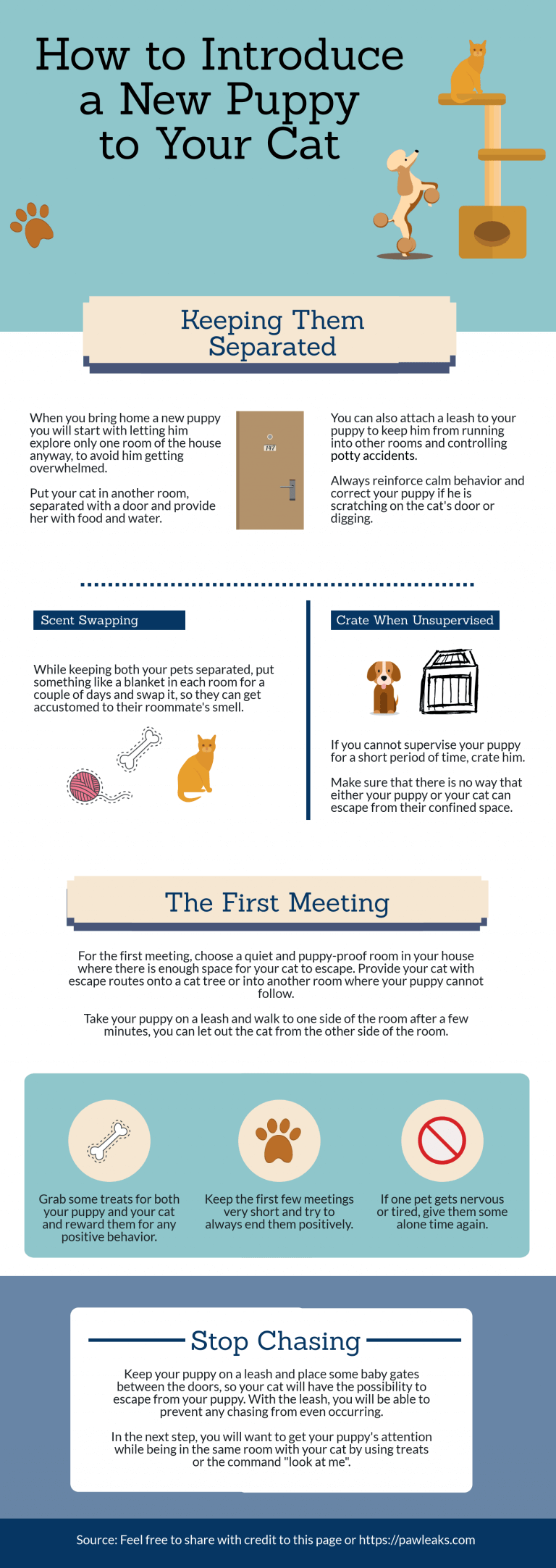
Cats and Dogs
Living Together
Cats and dogs can definitely get along and live together. Despite their different behavior patterns, they could become very close friends. Cats are more reserved and do not like to be thrown into new situations. They will most likely seek some quiet spots in the home to observe the situation first. Puppies, on the other hand, are very energetic and curious. A puppy loves to be around other animals and people and will probably enjoy the presence of the cat way more than vice versa. The key to peacefully living in a multi-species household is a controlled and slow introduction which won't start with them meeting. If not controlled, your puppy will probably lunge at the cat for an attempt to play which will lead her into defending herself.
Prior Experience
Before you bring your new puppy home, think about some prior experiences that your cat had with other dogs. Is she afraid of them and quickly hides somewhere or does she even react aggressively at their sight? You won't see a scared cat for a few days once the puppy arrived home. Anxious cats will avoid eye contact at all costs and will probably refuse to enter the house. But cats can also react quite aggressively towards dogs. Especially if you have a larger breed, she will quickly feel intimidated and can cuff if unsupervised. If you have a toy or small breed your cat could see it as prey and start chasing it. So you have to be very cautious at their initial meeting. When buying a puppy, choose a responsible breeder that has a cat and already desensitized the puppies to it. This will give you a head start and your puppy will react more appropriately to the cat. It is not guaranteed but we also chose a breeder with cats although we do not have any ourselves just because she has already learned to live peacefully with other animals which is great for socialization.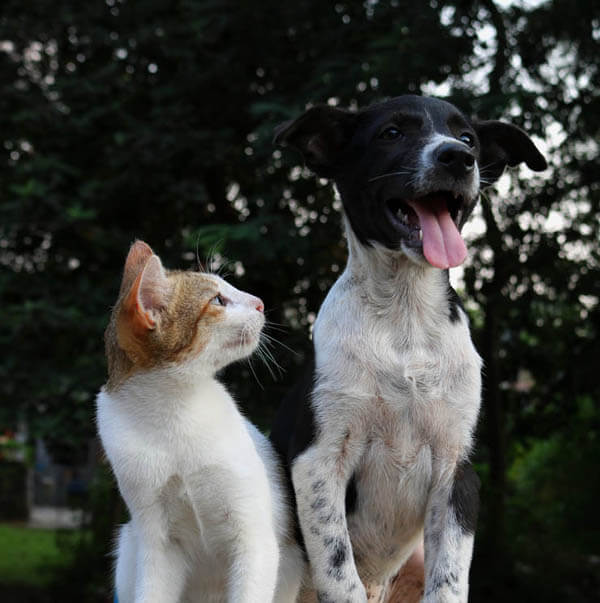
What to Do Before
Your cat will probably try to seek some privacy when a new puppy arrives. Always provide your cat with a chance to escape from uncomfortable situations. This will make her calmer and more confident overall. Provide her with a den or condo where she can hide and give her something like a cat tree so she will be out of the puppy's reach. Get both animals checked by the vet, so you can be assured that there are no underlying illnesses that could make the introduction harder. Remove anything toxic from your home and always supervise.
Keeping Them Separated
It is very important to keep both animals separated prior to their initial meeting. This will give them the opportunity to get used to the presence of one another without meeting. When you bring home a new puppy you will start by letting him explore only one room of the house to avoid him getting overwhelmed. Put your cat in another room, separated with a door, and provide her with food and water. Supervising them won't be a problem at this point as you will have to keep an eye on your puppy 24 / 7 anyways. You can also attach a leash to your puppy to keep him from running into other rooms and controlling potty accidents. Always reinforce calm behavior and correct your puppy if he is scratching on the cat's door or digging.
Crate When Being Left Alone
If you cannot supervise your puppy for a short period of time, crate him. You will find any information on crate training here and how you can properly introduce the crate. Yes, everything needs to have a great introduction! Leave your cat roaming outside if she is accustom to it. Make sure that there is no way that either your puppy or your cat can escape from their confined space and get to one another. Tire your puppy out before crating him and provide him with chew toys to keep him occupied. Take some time out of the day and concentrate on bonding with your cat and your puppy individually. This will ensure a positive and calm environment and relieves stress. It will also prevent your cat from thinking that she will be replaced now.
Scent Swapping
Both cats and dogs strongly experience their environment through scent. They can remember the scent of their home and can associate it with positive experience. While keeping both your pets separated, put something like a blanket in each room for a couple of days and swap it, so they can get accustomed to their roommates smell. For stronger association, place the blanket or pillow near the feeding area where endorphins are released while eating, so the scent of the other animal will be associated with something good. After they became familiar with the scent, you can then swap their rooms for a much stronger experience. Repeat the process a couple of times until both have settled in the home with all the new smells.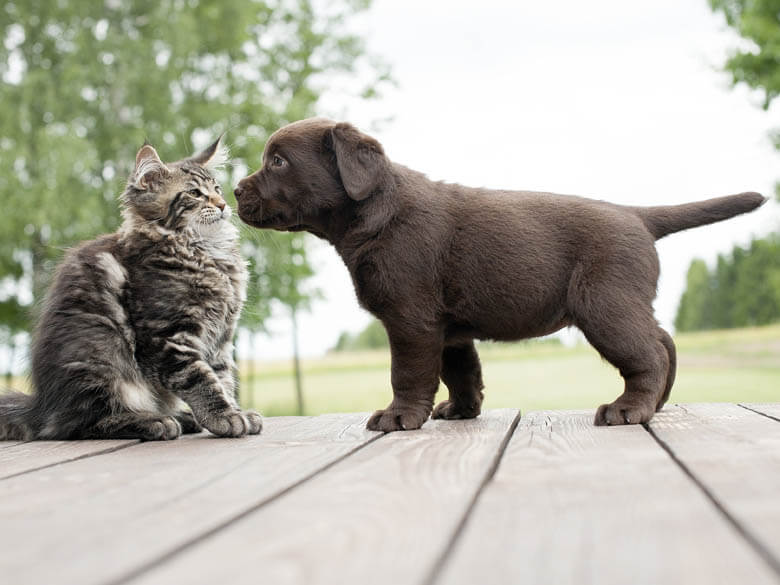
THE FIRST MEETING
For the first meeting, choose a quiet, puppy-proof room in your house with enough space for your cat to escape. Provide your cat with escape routes onto a cat tree or into another room where your puppy cannot follow. Tire out your puppy beforehand with a nice walk or a play session. Keep your puppy on a leash to prevent him from running up to the cat and startling it. Under no circumstances let him off-leash during the first meeting even when they seem to like each other. Take your puppy on a leash and walk to one side of the room after a few minutes, you can let out the cat from the other side of the room. If they immediately start to growl and hiss at each other, stop the meeting and go back to the steps mentioned above.
Let them explore at their own pace. Your puppy will probably try to get to the cat as soon as she enters the room but your cat will be more reserved. She will need more time to evaluate the situation, so do not try to lure her closer, she will come if she wants to. Do not force any of the pets to get closer to each other. It will only make it uncomfortable for everyone. Prevent your puppy from chasing or barking at the cat. This is the time where you will need to discipline him. Chasing cats is a real problem in dogs and you won't want to reinforce this behavior in any way.
Reinforcing Good Behaviour
Grab some treats for both your puppy and your cat and reward them for any positive behavior. If your puppy keeps barking at your cat, do not simply tell him "no", show him what to do instead. Engage in some play with him to get him distracted or give him a basic command like sit. Always treat any second where your puppy ignores the cat or reacts to it in a calm manner. You will want to keep him from starring at the cat as it will intimidate her quickly. It is a sign of aggression if your puppy won't look away from her, so you would need to stop the meeting.
Keep It Short and Positive!
Keep the first few meetings very short and try to always end them positively. If one pet gets nervous or tired, give them some alone time again. They will remember the positive experience and will slowly get accustomed to one another. Your goal will be to make it so comfortable for them that your cat will eat in the same room with your puppy mostly ignoring her. Any calm and positive meeting will build up their bond so they will be able to live together peacefully in the future. Over time you can make the meetings longer while giving your puppy more freedom - still on a long leash. Let them explore at their own pace and do not rush the process for the sake of saving time. Your pets do not have to become best friends but it would be perfect if they could live harmoniously together.
WATCH VIDEO
HOW TO STOP A DOG
TO CHASE THE CAT
As this will be a key point in their meeting, I want to explain it a bit further. Chasing is a predatorial and self-rewarding instinct which means that the more your puppy chases other animals, the more he will like doing it. So you will have to initially prevent any chasing behavior from your puppy by keeping him confined. Keep your puppy on a leash and place some baby gates between the doors, so your cat will have the possibility to escape from your puppy. With the leash you will be able to prevent any chasing from even occurring. In the next step, you will want to get your puppy's attention while being in the same room with your cat. You can achieve this by teaching some basic commands like "sit" or "look at me" and plenty of high value treats like cooked chicken. The more your puppy focusses on you the more he will ignore the cat.
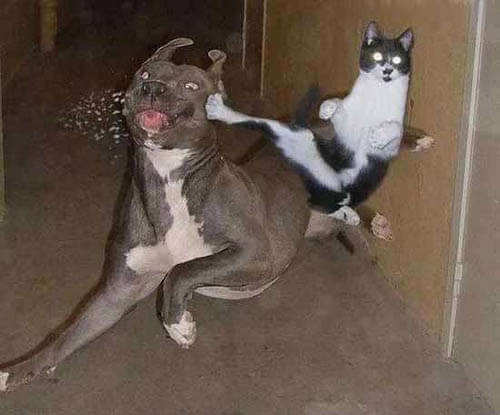
Ancient Romans believed the warmth of dogs could cure stomachaches. In Medieval Britain, cats were burned and tortured because they were associated with witches and the devil. Different civilizations have had altering opinions on whether or not they wanted to worship dogs for their guardianship and cats for their sacredness. Today, myths, beliefs and stereotypes still exist. In recent years, dogs have been known to help their owners by scaring away thieves while cats pay their dues by killing pests. Because cats and dogs have differing personalities, these selectively bred pets can bring an array of annoyance, delight, humor and fright to those who they come in contact with. Cats and dogs are portrayed as natural enemies in the media, but he has found cats and dogs get along quite well with each other. But in reality - you could say that some are even friends! A lot of the animals' behavior depends on how they are raised and trained.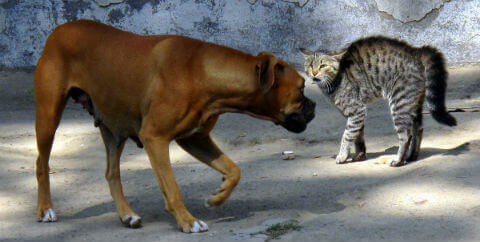
If a cat and a dog grow up together in the same house, then for the most part they won't fight unless it is to play around. It is when you get cats and dogs that aren't usually around each other that they will fight, the dog almost always starting it. Dogs are generally portrayed in the media as being man's best friend and Cats are more portrayed as royalty and we as humans are their servants. Cats are stereotypically lazy in movies, while dogs are more energetic. Cats are typically not seen as adventurous as dogs, such as Fat Louie on "Princess Diaries," while dogs are loyal sidekicks that will do anything for their masters, take Dug on "Up" for instance. Cats are more fun to watch on YouTube. It's usually funny to see what people do to cats, like scare them or something. Dogs just act the same no matter what. In the movie, "Cats and Dogs," dogs are the good guys, cats are the bad guys, In "Homeward Bound" the dogs are better, and the cat is a sassy mean thing. You have the wise dog, the fun dog and the mean, sassy cat. Usually, people have favorite breeds of dogs - ever heard of multiple breeds of cats? In the Philippines, cats do come to you if you call them - They listen.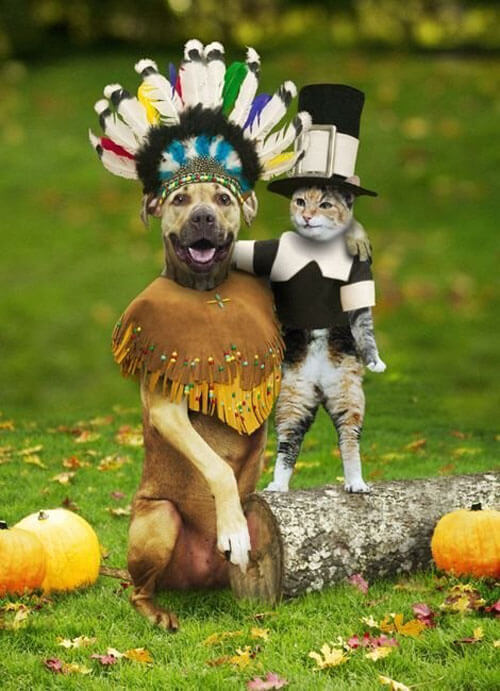
It's almost backwards in the Philippines. Dogs are disgusting, their hair is falling off... they looked like they were charred. Although cats and dogs have many differences, there is a divine reason for their creation. Both species can be extremely loyal, which makes them such great pets to people. The dog and cat were intentionally created with these attributes so that they could be our animal companions through life. Just think of how dreary the world would be if people didn't have dogs and cats! Ohh.. and for the final, here's one of the biggest dog & cat myth: Dogs and cats are colour-blind! - Noway! Both dogs and cats can see in blue and green, and they also have more rods: the light-sensing cells in the eye, than humans do, so they can see better in low-light situations. Reds and pinks may appear more green to cats, while purple may look like another shade of blue. Dogs, meanwhile, have fewer cones: the colour-sensing cells in the eye, so scientists estimated that their colour vision is only about 1/7th as vibrant as ours.

Cats and dogs use their paws for more than just walking. Both dogs and cats have four paws that get them around, cushion their body weight and allow them to manipulate objects. While Fluffy's and Fido's paws might appear similar at first glance, a closer inspection reveals quite a few differences between the two. When spotting tracks in the sand or snow, you may be wondering what type of track it is and whether it is a canine or feline paw print. Besides walking, cat and dog paws also serve other functions. Dogs sweat from their paws, can maneuver objects, dig holes or impress your friends with a friendly shake. Kitties probably won't shake paws with your guests, but they can climb with their paws, use them as weapons and shred food or perhaps, on occasion, things in your home best left un-shredded. There are some easy ways to differentiate between the two. Knowing the anatomy and shape of canine and feline paws will help determine whether you are following a dog or a cat. The most commonly found tracks can sometimes be confusing. How do you tell the difference between the tracks of dogs and cats? Was that track you found on the trail left by a mountain lion or a big dog?
Feline Paw Anatomy
Feline front paws have a total of seven pads. There are five digital pads, one large plantar pad (heel pad) and one small wrist pad. Feline back paws have a total of five pads. There are four digital pads and one large plantar pad (heel pad). Typically felines have five nails on the front paws, one each to the digital pad. Due to a genetic disorder, some felines may have up to seven nails. Felines have four nails on the back paws, one to each digital pad.
Canine Paw Anatomy
Canine front paws have a total of six pads. There are four digital pads, one large metacarpal pad (heel pad) and one carpal pad. Canine back paws have five pads. There are four digital pads and one large metacarpal pad (heel pad). Canines have five nails on the front paws, one each to the digital pad. Canines have four nails on the back paws, one each to the digital pad. Sometimes canines have a fifth nail higher up on the paw called the dew claw and in many instances this is removed when young.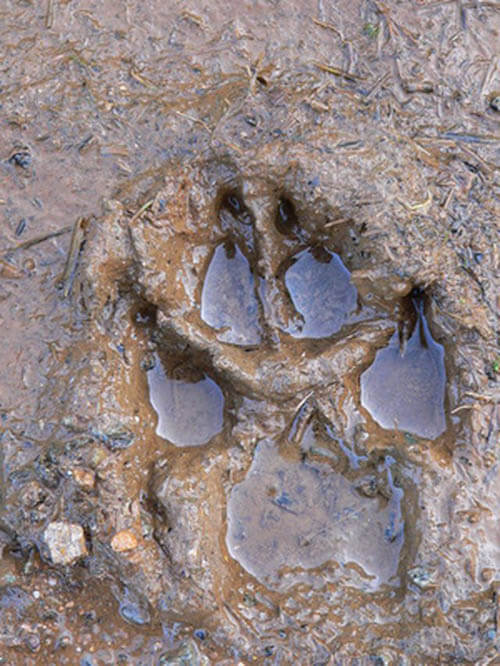
Feline Paw Shape
The shape of a paw is identified by the shape of the pads as well as the placement of the pads. The overall feline paw is a circular shape and the digital pads are teardrop shaped. The feline plantar pad has three lobes on the hind end that are aligned with one another and two lobes on the front end. The most notable difference is the placement of the front two toes (or pads). In felines they are not close together - one pad print is higher than the other.
Canine Paw Shape
The canine paw is more oval and the canine digital pads are triangular. The canine metacarpal pad has two lobes on the hind end with one lobe on the front end. With regard to the placement of the front two toes, the canine's toes are aligned and close together.
Pads
Cats and dogs have pads on the bottom of their feet that act as a cushion. Your cat's front paw has seven pads. Five are digital - sort of like a person's toes. There's also a large pad on the heel, called the plantar pad and a small one on the wrist or carpal area. In contrast, your dog has a total of six pads - four are digital, one on the heel and one on the carpal area. Your dog also has a dewclaw, sometimes referred to as a dog's thumb, on the inside of each front leg. The dewclaws never make contact with the ground.
Nails and Claws
Cats have retractable claws, meaning they can extend them or sheathe them. When a cat is relaxed, walking or playing gently, the claws are sheathed. If your kitty needs a tool or a weapon to bring down that mouse, however, the claws will be extended. In contrast, your canine has nails that are always extended, similar to a person's fingernails.
Paw Prints
While both the feline and canine have four toes on both the front and back feet, the main difference is shown by the inclusion and exclusion of claws in the prints. A canine paw print will always have claw marks whereas the feline paw print will not show any signs of claws because of the ability to retract them. If the cat is running, then the claws may be visible. Front tracks are larger than hind tracks in both felines and canines. Since feline paws have a toe (pad) that is ahead of the other, this enables you to determine whether it is the front left or front right paw. If the toe that is furthest ahead is on the right, this is the left paw. If the toe that is furthest ahead is on the left, this is the right paw. Canine prints do not have this distinction due to the front two toes being aligned.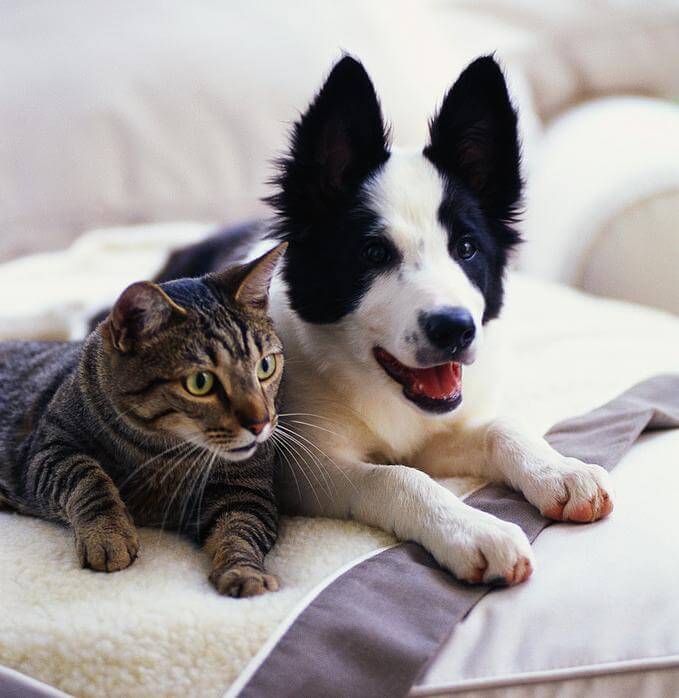
There are some clues that will help you tell the difference between dog and cat tracks. Dogs include such species as red and gray foxes, coyotes, wolves and domestic dogs. Cats include mountain lions, bobcats, lynx, and domestic cats. Lynx tracks have some unique features of their own, so are not treated here. What is said here should apply to bobcats, mountain lions and domestic cats. If you look closely, you can sometimes even tell the difference between right and left tracks, as well as front and hind tracks.
Front tracks are usually larger than hind tracks. This is true for both dogs and cats. The tracks of these two species are frequently confused because dogs are one of the only animals that make tracks of the same approximate size and shape as those of the cougar/mountain lion.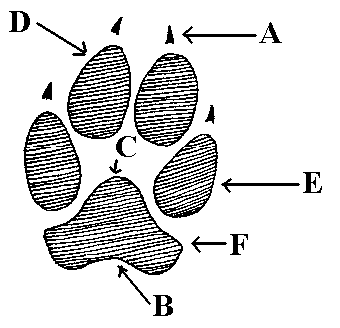
What makes Dog track
A: The claw marks. Dogs usually show claw marks in their tracks. However, it is possible to see claw marks in cat tracks, but this is usually when the animal is running or pouncing.
B: The lack of a third lobe on the hind edge of the heel pad. See cat tracks below for the difference. Although it is visible in some dog tracks, the third lobe is located higher, not aligned with the other two as it is in cats.
C: The shape of the leading edge of the heel pad is a single lobe. See cat tracks for difference.
D: The alignment of the front two toes. They are side-by-side, or very close to it, in dogs tracks. There are exceptions, such as when the animal is making a turn or walking on a slope.
E: The almost triangular shape of the pads of the outer two toes. Take a look at the photo to see this more clearly as my drawing is not the best for indicating this feature.
F: Dogs have a little point where the heel pad turns. Cats share this feature.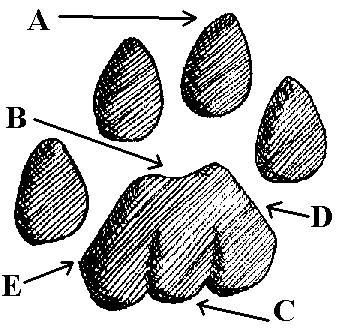
What makes Cat track
A: Note that the front two toes are not lined up side-by-side as the dog prints were. The toe that is further forward is analogous to a human middle finger - your longest finger. The alignment of this toe will tell you whether you have a left or right track. This toe is the inner toe of the leading pair.
B: The leading edge of the heel pad has two parts, or lobes.
C: The hind edge of the heel pad has three parts, or lobes. They are aligned with each other.
D: This is the front track. One clue that tells you this is that the edge of the heel pad is relatively straight. See hind track for difference.
E: Cats have a little point where the heel pad turns. Dogs share this feature.
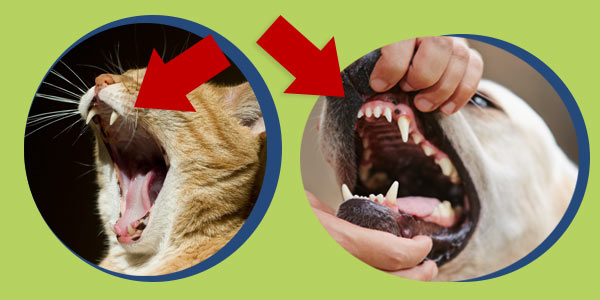
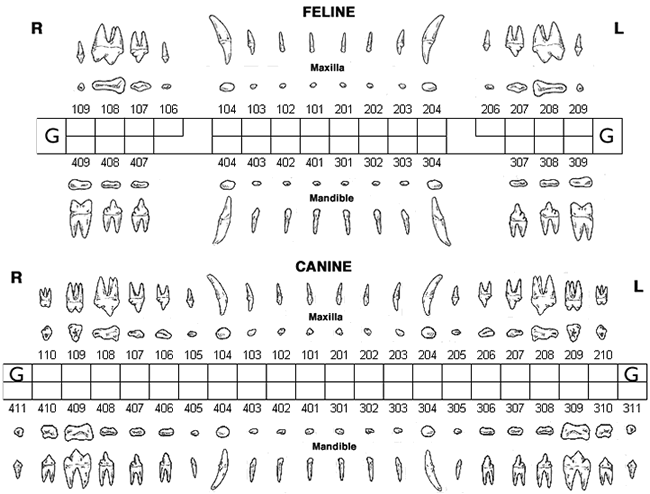
Dental Growth
Like people, dogs and cats have two sets of teeth. The initial smaller set, called deciduous teeth, includes incisors, canines, and premolars. As the puppy or kitten grows, the permanent teeth push their way out. The "baby" teeth roots absorb, causing the teeth to fall out. To fill in the void in the back of the now larger adolescent jaws, an additional set of teeth, the molars, emerge. In dogs, this entire transition is usually complete by 5-7 months of age, with a total of 42 adult teeth. Cats generally grow in their 30 adult teeth by 5-6 months.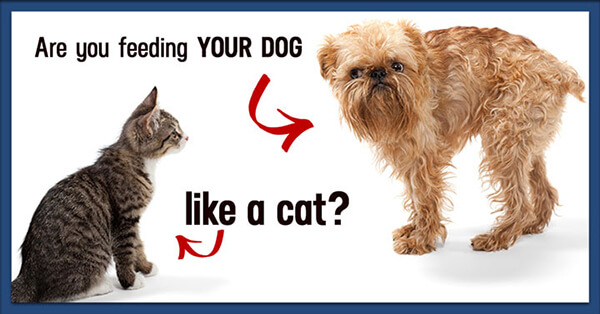
Dog vs Cat Raw Food
Raw Feeders: Why Are You Feeding Your Dogs Like Cats? Take a look at the following pictures of the skulls of two different animals: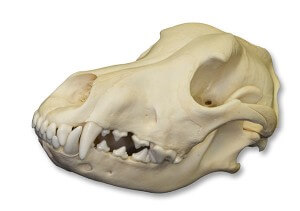
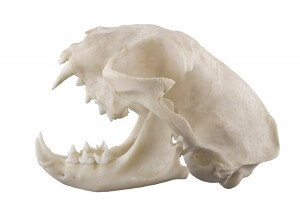
Look at the difference in the shape of the shape and number of teeth. Do you think these animals should be eating the same foods? Clearly, these are different animals with different needs. In fact, they are about as different as cats and dogs! What The Mouth Tells Us About Diet?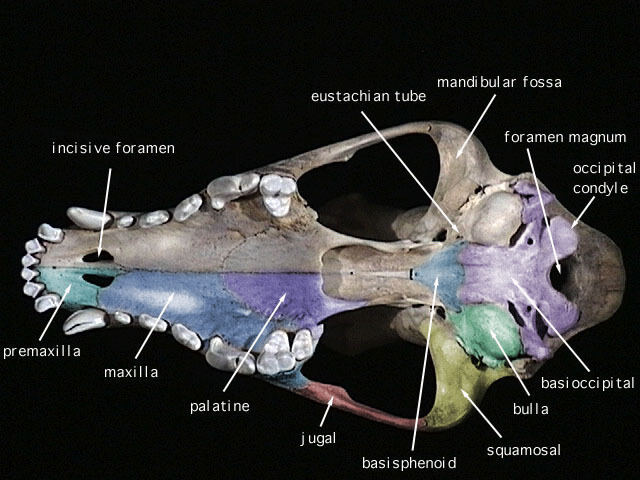
See those pointy teeth that both dogs and cats have? They are called canine teeth and they are meant to tear and rip flesh. In fact all of the teeth of the dog and the cat are pointy, so that, in addition to the pronounced canine teeth, gives us a good idea that they are both meant to eat meat. They are both carnivores. Let's compare that to our own omnivorous teeth!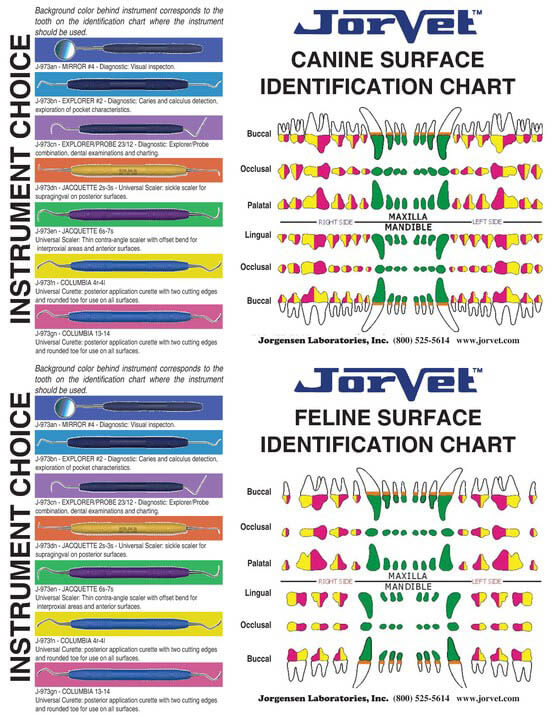
Now let's look again at the teeth of the dog. You can see they also have molars at the back of their mouth. They are pointier but they have them. They also have a sharp, interdigitation but they are clearly there and they look capable of grinding. Compare that to the cat, where the molars are very sharp and elongated and much, much less capable of grinding.
So the dog's mouth is somewhere between the human mouth and the cat's mouth. You might also have noticed that dogs and humans have a lot more teeth than cats too.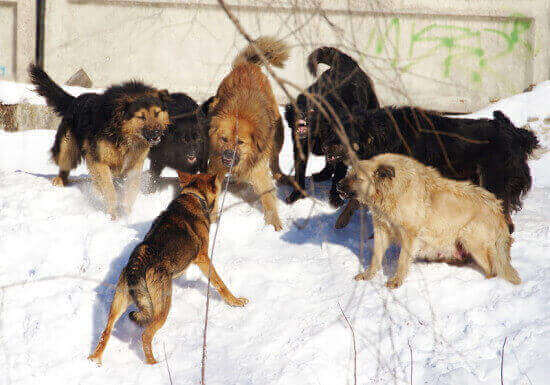
Dogs have four times more pancreatic amylase than cats and the activity of the enzyme rises much more in dogs with the amount of starch content in the diet. This means dogs can digest over 99% of processed starches and about 90% of many raw starches. The cat's ability to digest starch is more limited.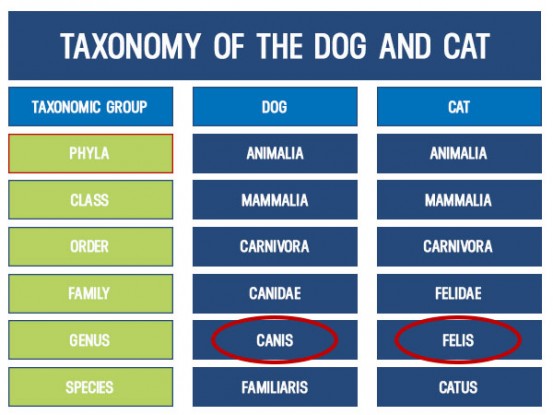
DIGESTIVE TRACT
Differences between Dog and Cat:
Dogs have More teeth
Flatter molars
Dogs have More pancreatic amylase (four times as much)
Dogs experience More amylase activity
Dogs own Longer digestive tract (nearly twice as long)
Can convert some plant based ALA to DHA and EPA (cats can't)
Can manufacture taurine (cats can't)
If we move down the digestive tract, you will see more fundamental differences between the dog and cat. The average length of the dog's digestive tract is 2 feet. The average cat's digestive tract is 13 inches. Here are a few more differences between the digestive systems of dogs and cats:
Dogs can convert approximately 5 to 15% of plant based ALA (Alpha-linolenic acid), which is a type of omega-3 fatty acid found in plants. Cats completely lack the enzymes necessary for this conversion.
And finally, dogs can manufacture taurine (an amino acid from animal protein), whereas cats can't. Clearly cats must eat a predominately meat-based diet, but dogs are a little fuzzier in that definition.
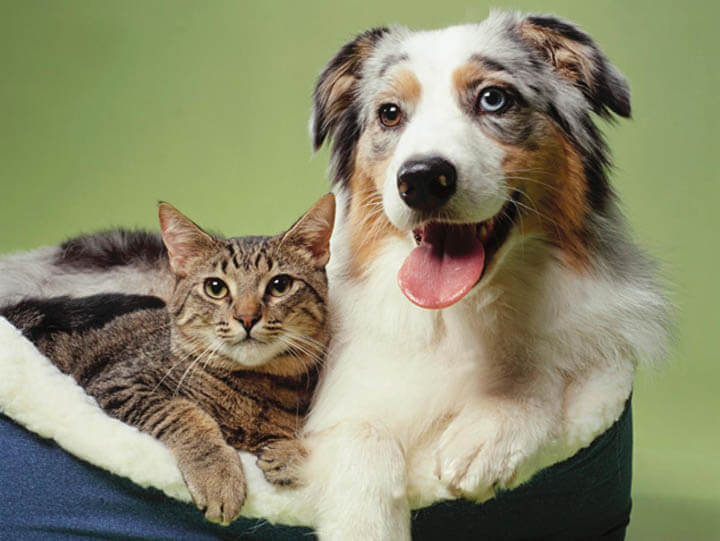
Cats are not as excitable as dogs. They have to maintain their "coolness" after all. Felines do associate sights, sounds and smells, though. If they didn't, the electric can opener would never be successful at training a cat to come running when "it" calls out. A cat's brain functioning has been compared to that of a two to three year old child and, when compared to a dog, a cat's memory is almost 200 times more retentive. Without repeated and reinforced training, a dog's memory span is about 5 minutes. But as any cat owner knows, felines are more selective, and remember what they think is useful to them.
Short term memory for a dog is about 2 minutes, cats remember much longer, up to 16 hours. Long term memory is harder to determine. We know dogs have a long term memory because they can remember hand signals and words for their lifetime. Cats have an excellent memory when it comes to remembering people they have a strong bond with. On the other hand, if a cat has been mistreated by a human, she will remember. If you have an adopted shelter cat who avoids men, young boys wearing hats, or women who wear a lot of makeup, it's likely your cat has a memory that triggered a response to avoid those people as a threat. That's why it can be difficult to earn an abused or neglected cat's trust.
When it comes to long term memory, what is amazing to me are the many stories of dogs and cats that became lost or were relocated, and walked thousands of miles to find their way back home. Sometimes it was not a person they had bonded with and missed, but another pet and for some, it was getting back to an area they were familiar with. Was it their memory of the person or place they loved that kept them going? Researchers think they understand a dog or cat's memory, but their science isn't exact and more studies need to be done. Of course, you know your dog remembers a whole lot of stuff longer than two minutes. Those memories, claims the study, are associative memories - a cat associating the cat carrier with the danger going to the vet, for example.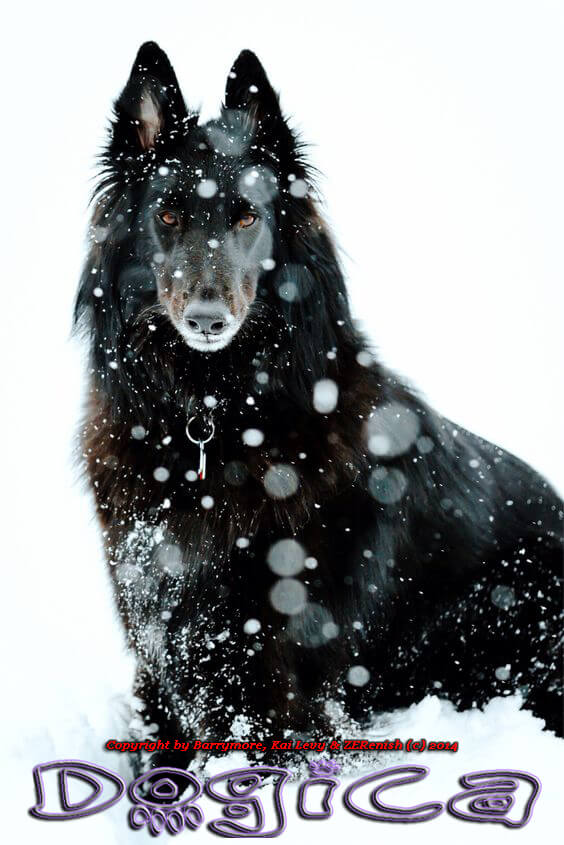
A cat's cerebral cortex contains about twice as many neurons as that of dogs. Cats have 300 million neurons, whereas dogs have about 160 million. In fact, cats have more nerve cells in the visual areas of their brain, a part of cerebral cortex, than humans and most other mammals.
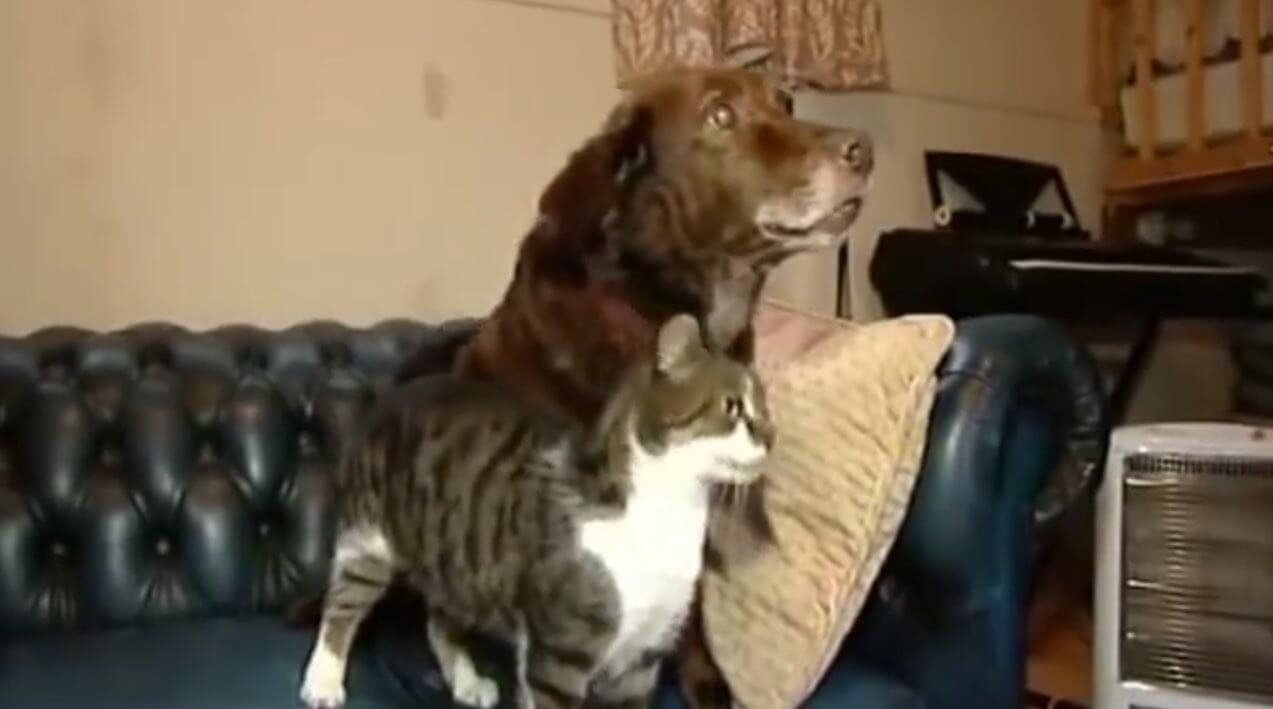
SEEING EYE CAT
FOR BLIND DOG
Eight-year-old Labrador Retriever Terfel was diagnosed with cataracts, a common eye condition that caused the lenses in his eyes to cloud over and become opaque. As his cataracts continued to worsen, Terfel became hesitant, reserved, choosing to spend most of his time curled up in his doggie basket rather than venture out into a once-friendly world that had suddenly become so unfamiliar and frightening.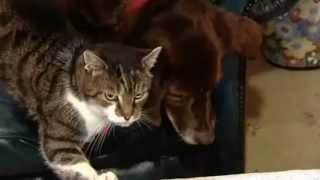
WATCH VIDEO
Terfel's outlook on life changed drastically the day that his owner, Judy Godfrey-Brown of Holyhead, North Wales, took in a small stray cat. Godfrey-Brown could hardly believe her eyes as she watched the little cat gently lead Terfel around the garden. It was as if the cat sensed Terfel's condition and knew instinctively that the blind pup needed a friend.
READ ONLINE
BLIND DOG vs BLIND CAT
F.A.Q by
BESTFRIENDS.ORG
BLIND DOGS vs CATS:
DIFFERENCE
& SIMILARITIES
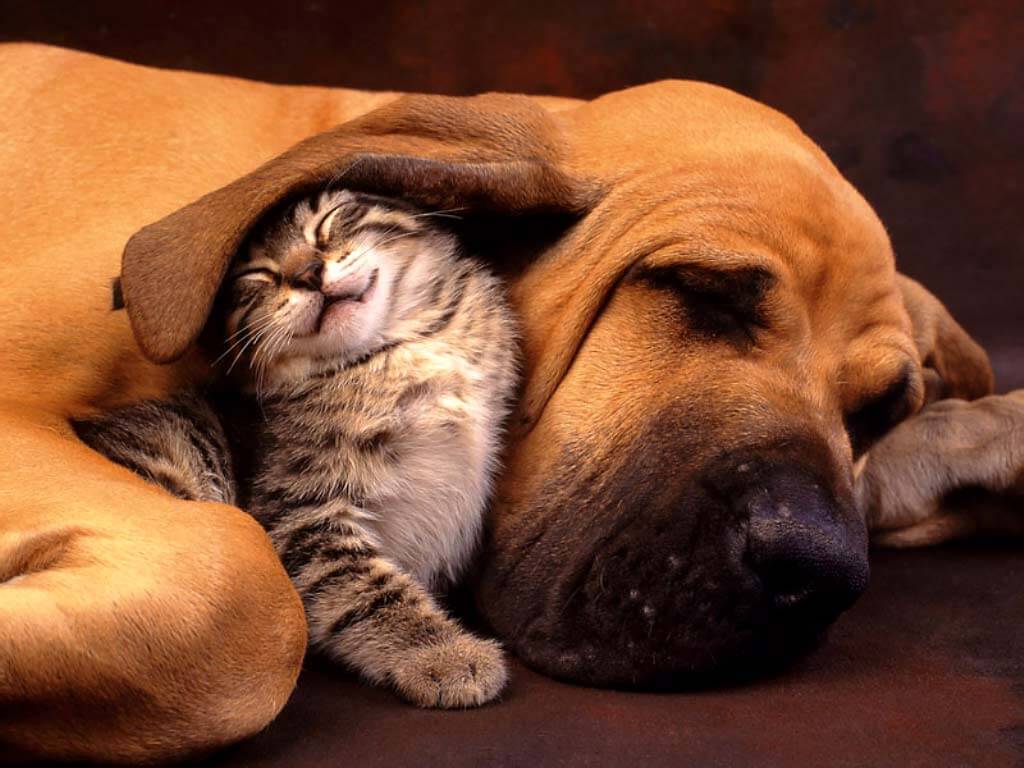
Care, Equipment
Cats require a food and water bowl, a litter box, a few toys and scratching posts, and a brush for grooming.
Dogs require a food and water bowl, a leash and collar, a dog bed, toys and chews and treats.
Feeding
The amount a cat needs to eat varies depending on its size, but is less than a dog. Cat food comes in dry or canned wet form. Adult cats require between 250 and 300 calories per day.
The amount a dog eats depends on its size. Commercial dog food comes in both dry and wet forms, and most dogs need between 25 and 30 calories per pound per day
Grooming
Bathing
Cats do not need bathing, but they should be brushed regularly if they have long hair.
Dogs especially those with long hair - need grooming and bathing frequently.
Health
The average life expectancy of cats is around 12 to 14 years, but they can live into their 20s or even their 30s. Medical costs for cats are around $160 per year.
The life expectancy of dogs varies depending on the breed. They range from 7 years to 14 years. The oldest dog was 26 years old. Medical costs for dogs vary depending on size, but are estimated between $210 and $260 per year.
House Training
Cats can easily be trained to use their litterbox. This requires cleaning once a day.
Dogs need to be trained, socialized and housebroken.
Cats usually already know how to use a litterbox.
Dogs will need to be trained for about 2 months to be fully trained.
Protection
Dogs can function as watchdogs or guard dogs, protecting their owner and the house.
Cats only watchers. They do really nothing, even not screaming, while thief or weirdo comes into your house
Space
Cats can live in smaller areas, while dogs generally need more space to run around. Cats can be kept indoors, but dogs need to be taken for regular walks – at least twice a day.
Tricks
Although some cats will learn to do tricks, they do them to please themselves, not their owners, and so are more difficult to train.
Most dogs can be trained to do some tricks with patience.
Your Work
As dogs need more personal attention than cats, they are less well suited to people who travel a lot or work long hours. Dogs should preferably not be left home alone all day, while cats will cope.
Cost
According to the ASPCA, a typical cat costs $670 per year, including food, litter and medical costs.
A small dog cost approximately $580, while a medium sized dog costs $695 and a large dog costs $875.
Popular breeds
The most popular cat breeds in the US are the Persian, the Maine Coon, the Exotic and the Siamese.
The most popular breeds of dog in the US are Labrador Retriever (with over 123,000 registered individuals), Yorkshire Terrier (48,346), German Shepherd (43,629) and Golden Retriever (42,962).
There are approximately 78.2 million pet dogs in the US. 39% of US households own at least one dog. On average, dog owners have one dog.
According to US census data, there are around 86.4 million pet cats in the US. 33% of households in the US own at least one cat. On average, cat owners have two cats.
Common Games
Cats enjoy simple games that allow them to stalk and pounce. Popular games include bouncing a ping-pong ball on the floor for the cat to jump after, rolling a crumbled ball of paper along the floor, dragging ribbon along the floor, or playing hide and seek.
Dogs enjoy games that allow them to run and chase. As well as playing "fetch," dogs enjoy playing tug-of-war, hide and seek, find the treat, and running races.


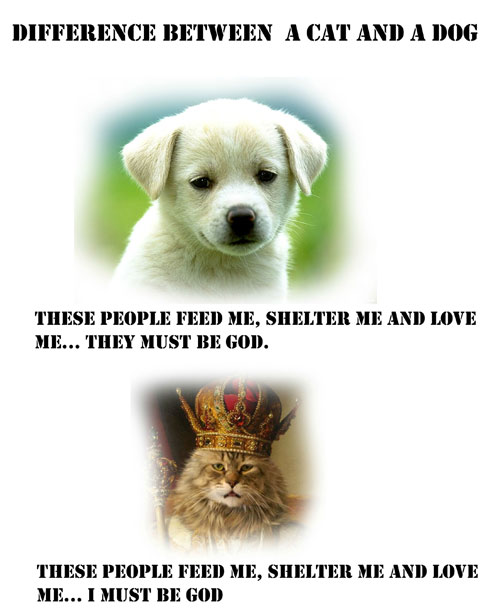
How to choose
When choosing between a cat or a dog, you should consider how much time you can dedicate to the pet (dogs require more time than cats, and don't like to be left home alone), how much you can afford to spend (dogs are more expensive than cats), and what temperament of pet you would before (dogs are more needy and affectionate than independent cats).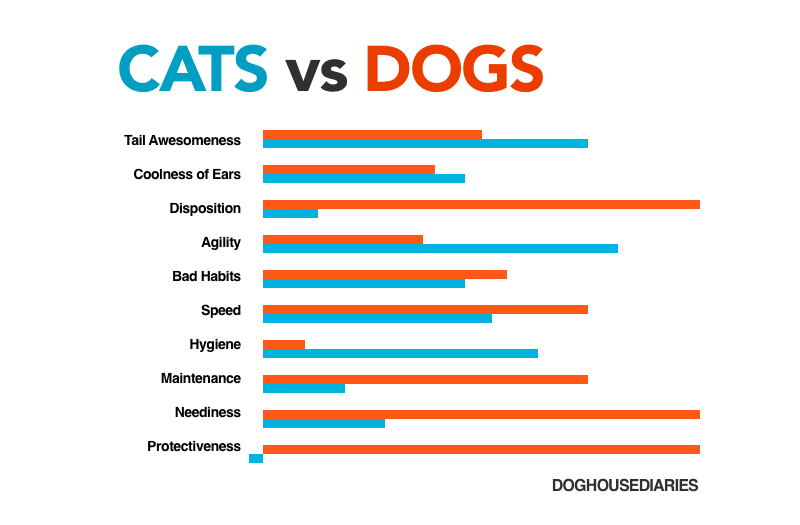
When choosing a cat, consider whether you want to get a purebred cat from a breeder, or rescue a cat from an animal shelter. If you are not getting a kitten, consider whether you want an indoor or an outdoor cat and choose accordingly, as certain cats will be trained for different situations. Different breeds have different temperaments, but they vary less than dogs. For example, Siamese cats are intelligent and playful, but can be very noisy, while long-haired cats are laid back and short haired cats are usually affectionate and even-tempered. Individual cats also have different personalities, so interact with them before taking them home. Consider the hair length you can handle, as longer fur, such as the fur of a Maine Coon, Persian or Ragdoll, will require daily brushing.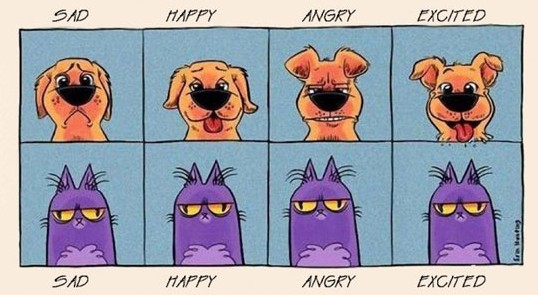
When choosing a dog, consider its size. Larger dogs, such as a German Shepherd or a Labrador, need more space and cost more to feed and care for. Some breeds, such as Labradors, Corgis and Spaniels, are also easier to train than others, and have more friendly temperaments. Take into account the length of the dog's fur, as those with longer coats will need more regular grooming. Although purebreds are popular, they can suffer from greater temperament and health problems. Mixed breed dogs usually have fewer health problems and can be adopted more cheaply from shelters.



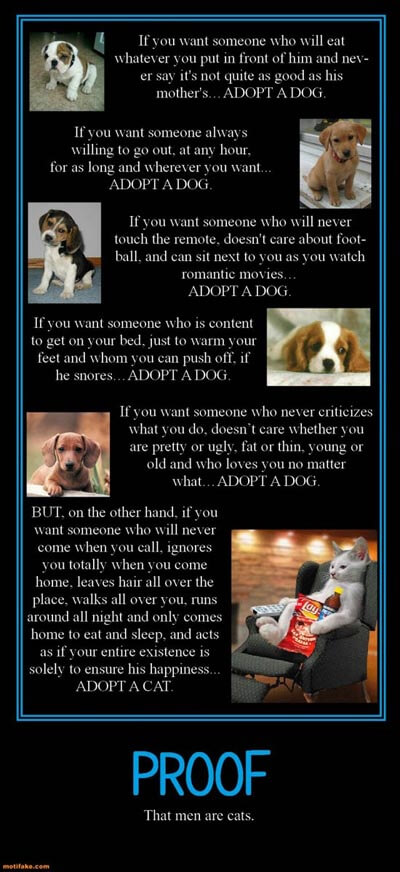
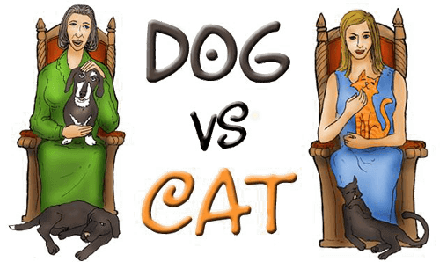
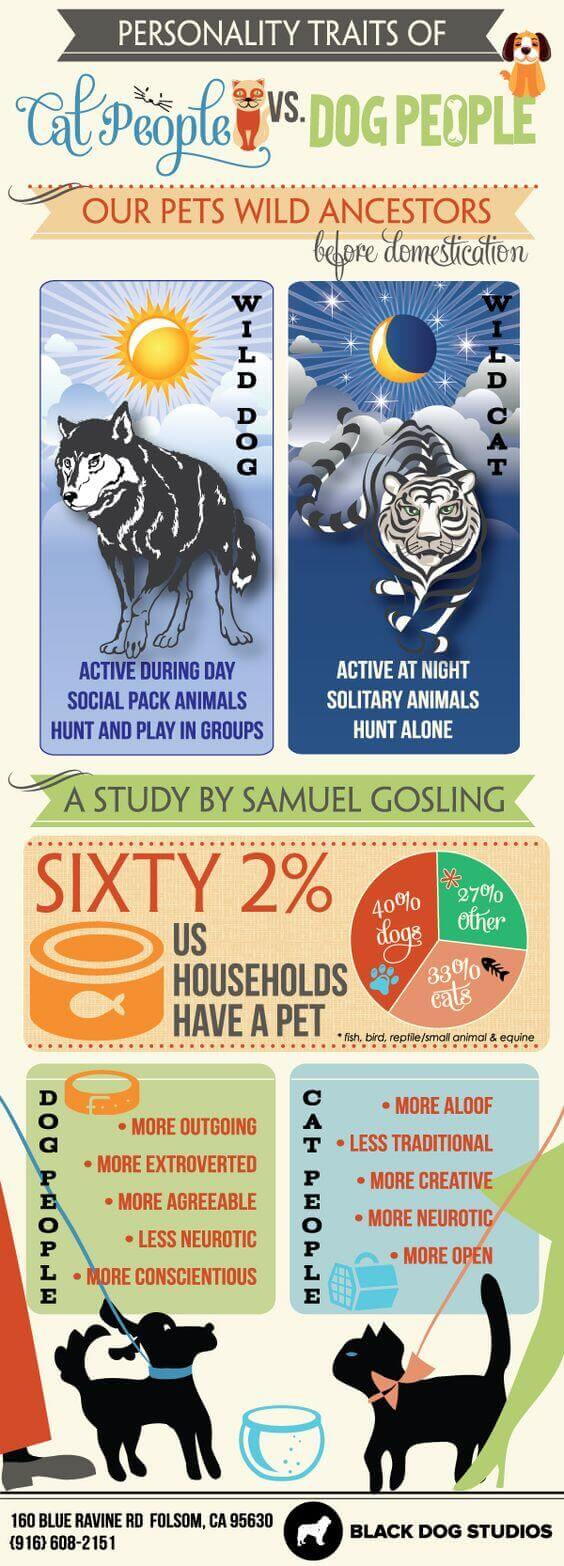

Check famous dog & cat lovers:
FAMOUS DOG LOVERS
FAMOUS CAT LOVERS



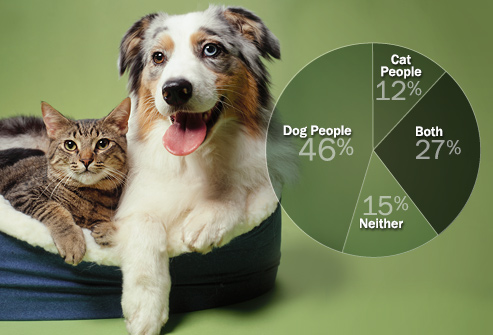
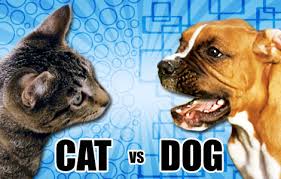
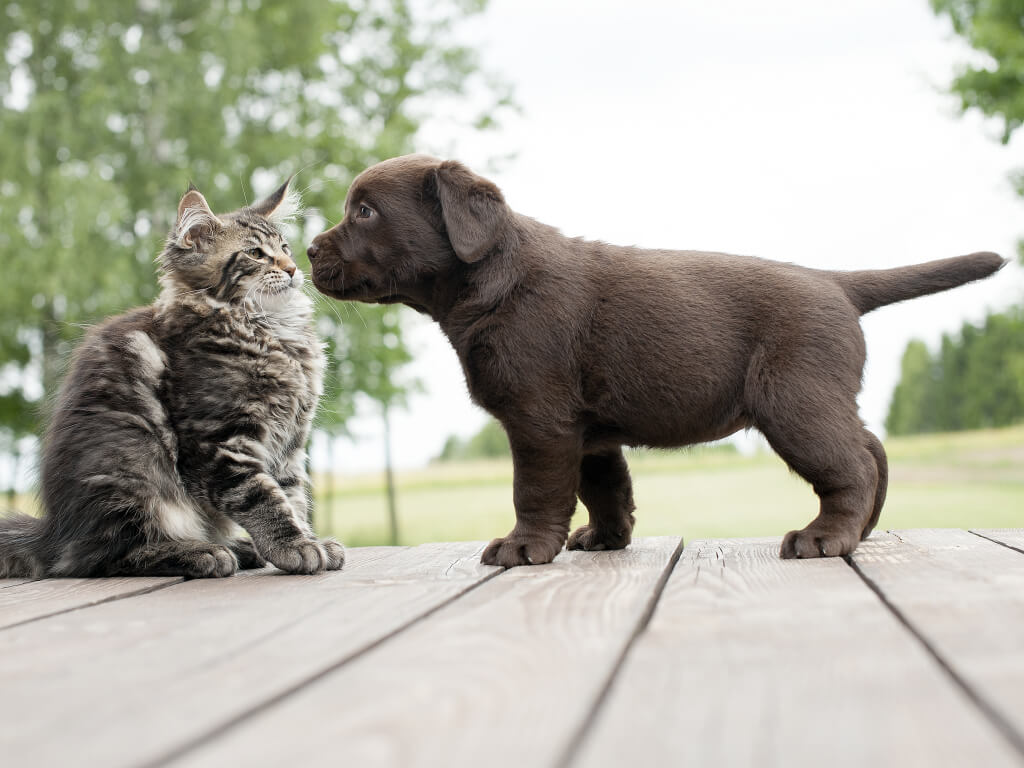
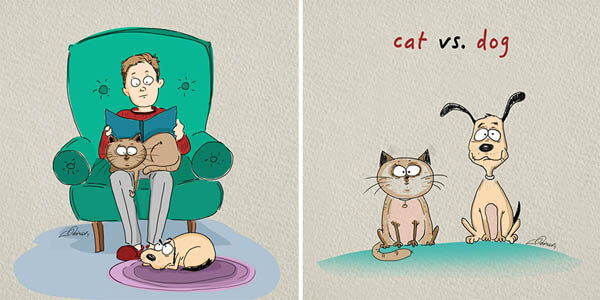
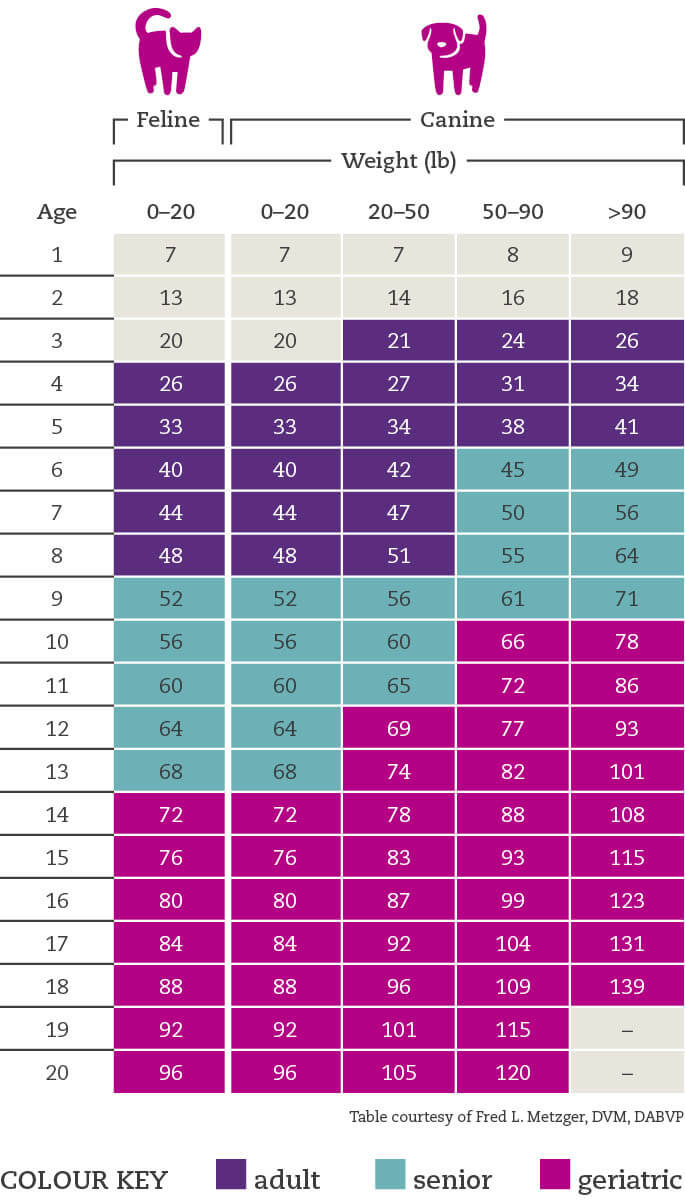
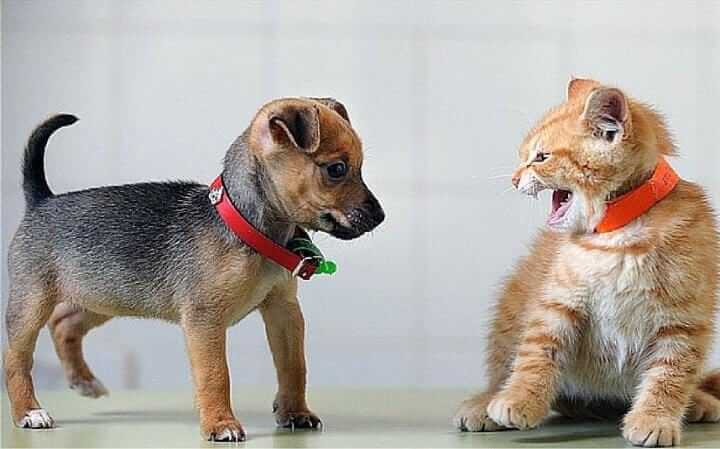
The eternal dispute between dog and cat lovers will probably never end. However, scientists have found out which out of our feline or canine friends love us more. As part of a new BBC2 documentary called "Cats v. Dogs", hosted by animal experts Chris Packham and Liz Bonnin, a neuroscientist has investigated which species prefers humans. We already knew that, like humans, dogs release the "love hormone" oxytocin. This test has never before been done on cats. A couple of small-scale studies have shown that when owners interact with their dogs, the human and their dog appear to release oxytocin. Itэs one of the chemical measures of love in mammals. Humans produce the hormone in our brains when we care about someone. For example, when we see our spouse or child the levels in our bloodstream typically rise by 40-60%.The neuroscientist checked the oxytocin levels in both cats and dogs after playing with their owners. He took saliva samples from 10 cats and 10 dogs on two occasions - 10 minutes before a playtime session with their owners and immediately after and tested both samples for oxytocin. The results show the hormone increased by an average of 57.2% in dogs but only by 12% in cats. This means in theory, dogs love their humans more than cats do. Еhe dog level of 57.2% is a very powerful response. It shows these dogs really care about their owners. It was also a nice surprise to discover that cats produce any at all. At least some of the time, cats seem to bond with their owners. Some think that cats don't actually like their owners at all - this study at least proves that wrong. Cats beat out dogs in one area, however - they are better at surviving. A study of 2,000 fossils has revealed that the felids are much better at surviving than canids. A team of scientists found that cats have played a significant role in making 40 dog species extinct. Cats often out competed dogs for food rations because they are generally more effective hunters. No evidence has been found that dogs have ever wiped out a cat species.
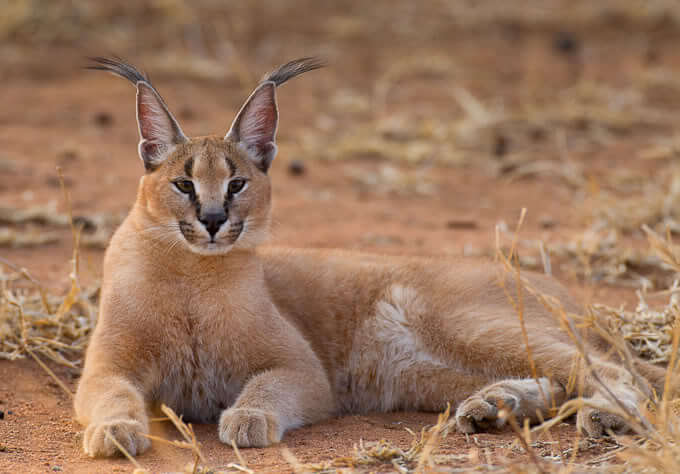
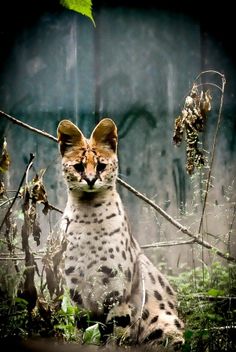
15 RARE WILD
DOG SPECIES
VS
15 RARE
WILD CAT SPECIES
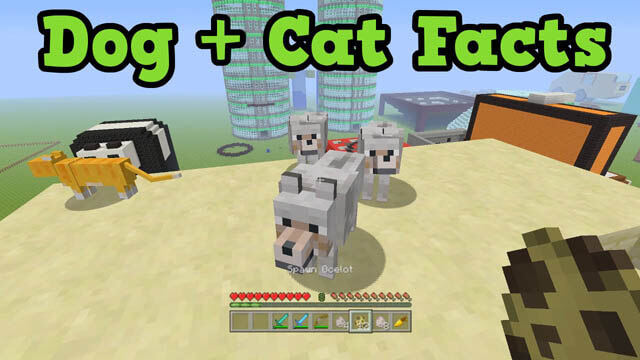

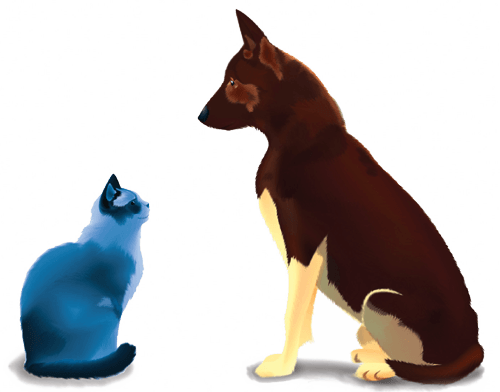
Omnivore vs. Carnivore
Though cats and dogs are the most common household pets in North America, the similarities practically end there. Their needs and preferences for food, water and socialization are quite distinct. Below, Illinois-based cat and dog nutrition expert Linda Case and Dr. Trisha Joyce of New York City Veterinary Specialists reveal some key differences.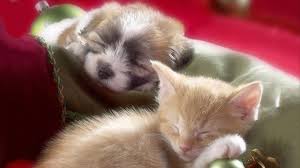
As cats and dogs were becoming domesticated, they developed according to the food sources available to them. "The evolutionary history of the dog suggests a predilection for a diet that is more omnivorous in nature, while the history of the cat indicates that this species has consumed a purely carnivorous diet throughout its evolutionary development," explains Case.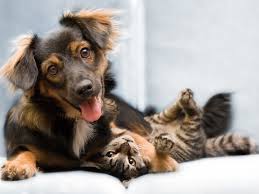
Cats evolved into meat eaters that need a whole lot of protein (about 26 percent of their total caloric intake), but dogs can subsist on a more varied diet (only about 5 percent protein). Joyce says dogs can eat many different foods, but cats would have serious nutritional deficits because they require protein from meat.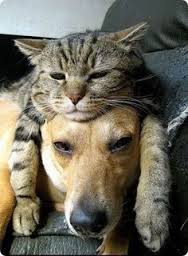
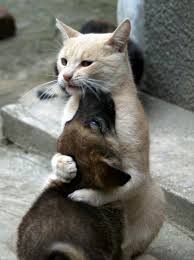
Their taste buds differ as well. While both dogs and cats have a high proportion of taste buds that are sensitive to amino acid flavors (or proteins), only dogs respond to sweet foods. This means, for one, that you don't have to hide that pan of brownies from your cat. "You have to be careful to keep a dog away from chocolate," says Joyce. "It's dangerous for them. Cats can't metabolize it either, but the concern is not the same because they would never eat the massive quantities of it that a dog would."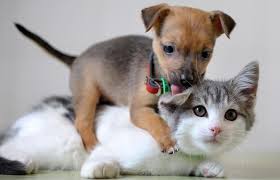
Pack Animal vs Loner
Both dogs and cats become accustomed to eating at specific times, but only dogs seem influenced by the social setting of the meal. "Dogs tend to increase food intake when consuming food in the presence of other dogs in their social group," says Case. "This process is called social facilitation." For most dogs, social facilitation causes a moderate increase in interest concerning food, as well as a tendency to eat faster.
Dogs are so prone to the influence of others that even their owners can impact their food choices. In one study summarized by Case, a group of dogs had the choice between a small and a large portion of kibble. Most chose the large. But when their owners were brought in and the dogs watched as they chose the smaller plate, their own choice changed in the second trial, as they chose the tiny serving. A similar experiment used equal portions in two different bowls. Each dog was consistently more interested in whichever bowl its owner preferred.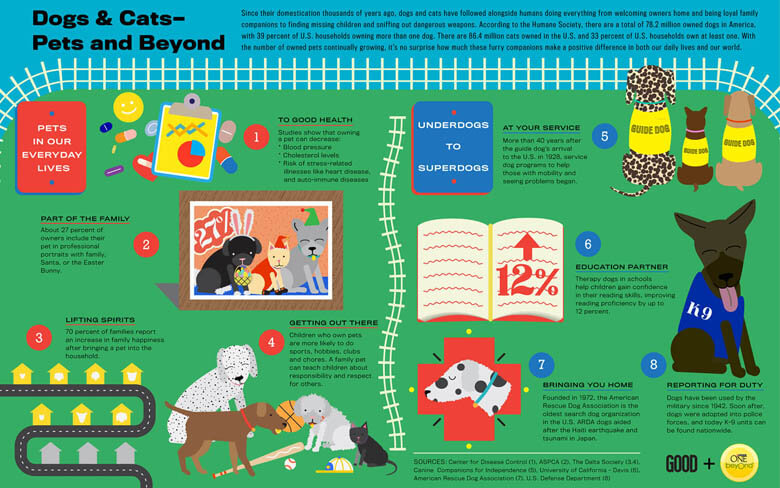
Joyce adds that cats seem to be emotional eaters. "My clients often tell me that their cats go to the food bowl when they're happy, like when the owner arrives home."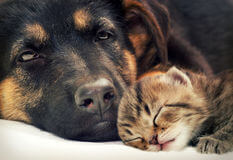
Thirst vs Dry Mouth
While both dogs and cats need an adequate supply of clean water, the definition of "adequate" differs between the two. "Dogs typically consume more water per unit body weight than cats do, and respond more rapidly to mild dehydration by voluntarily increasing their water consumption," says Case.
Cats' relatively weak thirst drive is attributed to their evolution from a desert-dwelling species. As a result of low water consumption, cats produce more concentrated urine than dogs, which helps to conserve the little water they do take in. However, it also leaves them at greater risk for bladder stones, rock-like deposits that can interfere with their ability to urinate, causing symptoms like blood in the urine and passing urine outside of the litter box.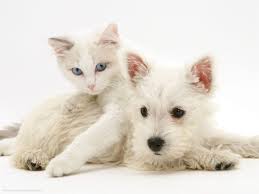
One Meal a Day vs Many
"Cats are natural grazers," says Joyce, noting that it's more common for cats to be on free-feed diets than dogs. The reason for this may be partly a function of anatomy. While the stomach of each animal acts as a reservoir for the body, allowing food to be ingested as a meal rather than continuously throughout the day, a dog's stomach expands more readily. "The proximal section of the stomach is capable of expansion, a function that is assumed to be of greater importance for dogs, which tend to eat large meals at a given time," says Case.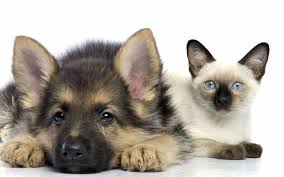
Keeping the above differences in mind, pet owners can rest assured that they are adhering to what nature intended and continues to insist on.
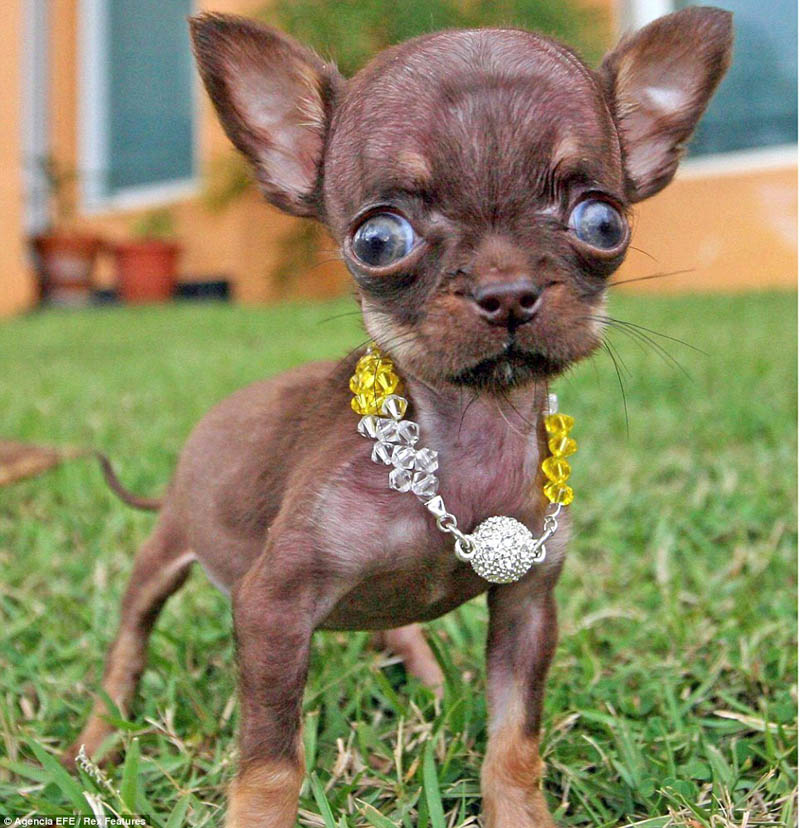
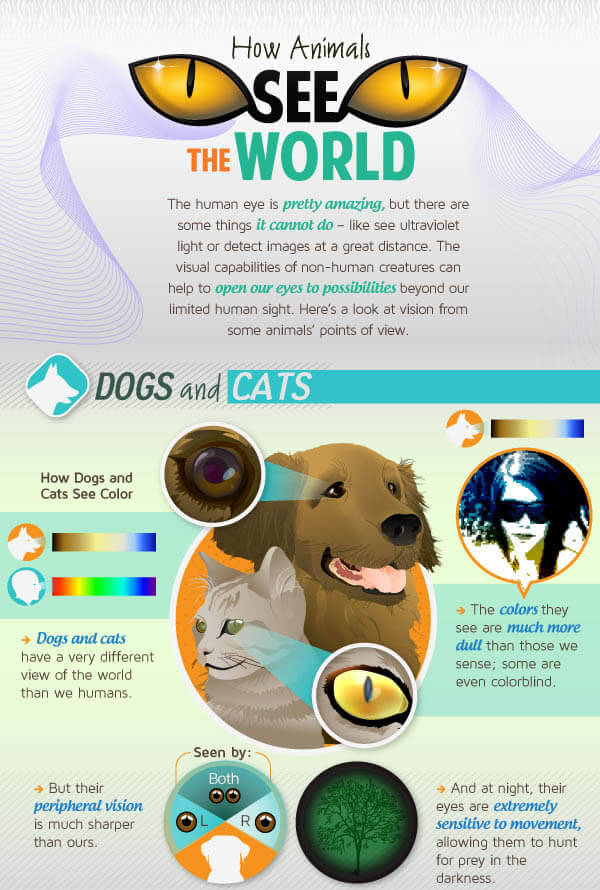
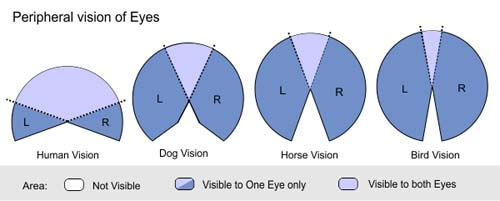
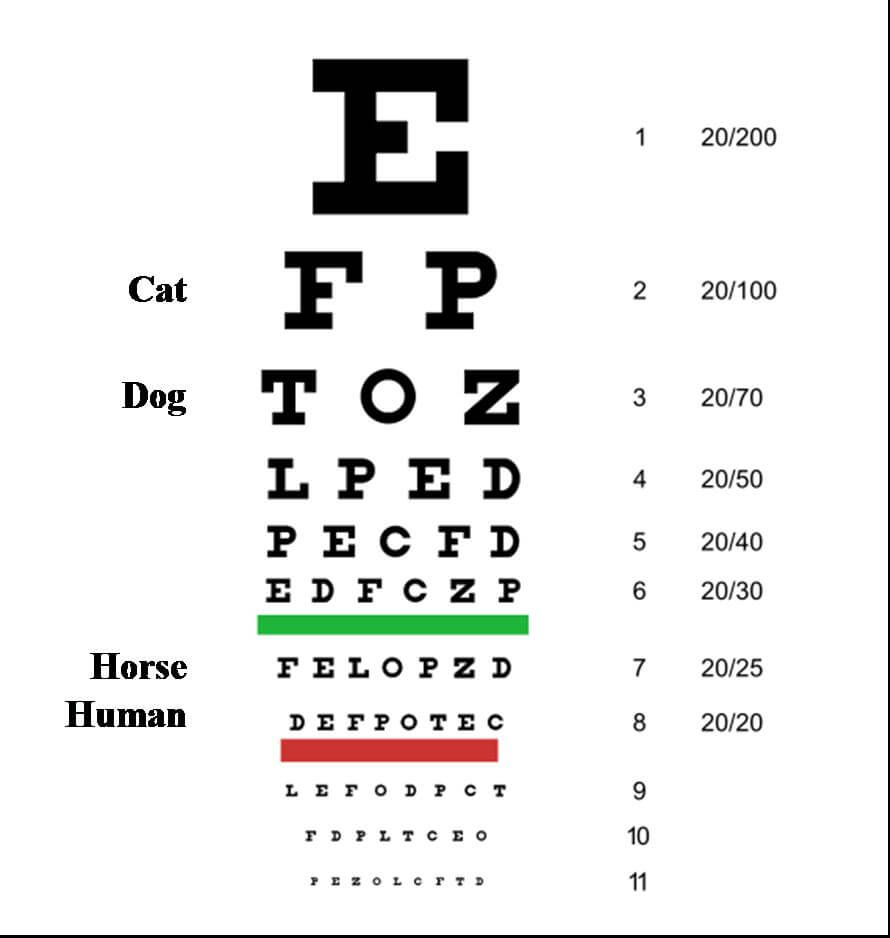
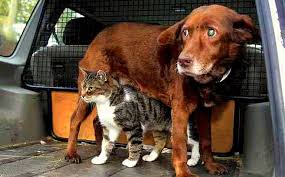
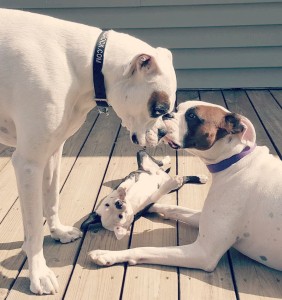
DEAFNESS IN
DOGS vs CATS
READ F.A.Q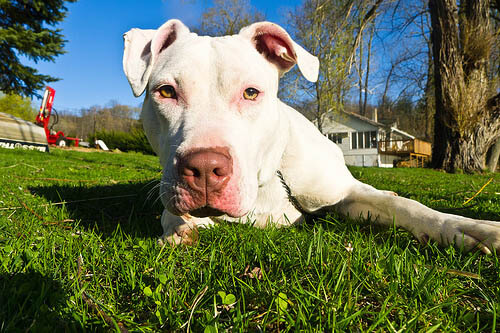
READ ABOUT DEAFNESS IN DOGS
at WWW.PETMD.COM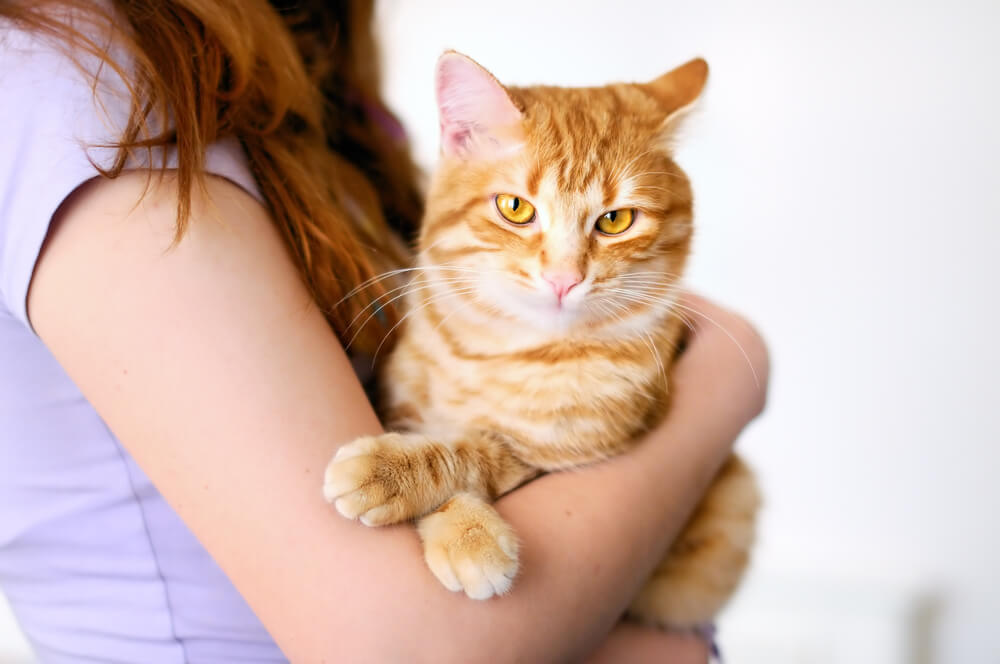
READ ABOUT DEAFNESS
IN CATS
at WWW.PETMD.COM

READ ABOUT
ALBINO DOGS
at WWW.DOGSTER.COM
READ ABOUT
ALBINO CATS
at WWW.CATSTER.COM

We all know you can train a dog but training a cat to do anything must seem very unlikely to most of us. After spending so much time with cats I sometimes think that it is them that teach us. In fact, clicker training can be very effective with cats as this video shows so remarkably. Who wins, the cat or the dog?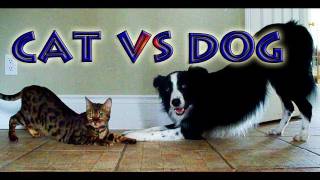
WATCH VIDEO
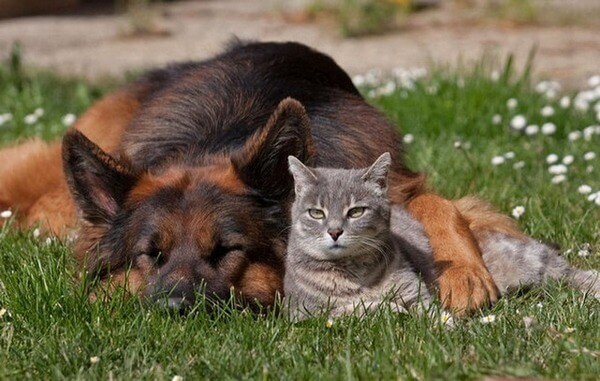
DOG & CAT FOOD
This article proudly presented by
WWW.VET-MEDIC.COM

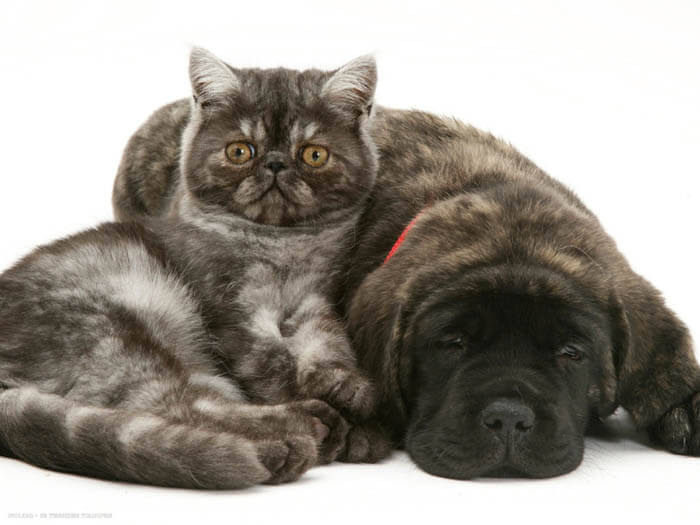
Cat fleas (Ctenocephalides felis) are a different species than dog fleas (Ctenocephalides canis). However, their differences are best distinguished through the use of a microscope.
Despite their name, cat fleas are capable of affecting dogs and an array of other animals as well as humans. The majority of North American flea problems are cat flea infestations. If your pet is exhibiting symptoms of a flea problem, it is likely that they are hosting cat fleas. Dog fleas are most common in Europe, although in rare cases, they appear in North America, as well
Symptoms of flea infestation include excessive itching, red skin and secondary infections. In extreme cases, animals may develop flea allergy dermatitis. A veterinarian can help you decide upon flea remedies for your pet, but contact your local pest control expert to discuss science-based solutions and extermination options for your home.

The most commonly found tracks can sometimes be confusing. How do you tell the difference between the tracks of dogs and cats? Was that track you found on the trail left by a mountain lion or a big dog? There are some clues that will help you tell the difference between dog and cat tracks. Dogs include such species as red and gray foxes, coyotes, wolves and domestic dogs. Cats include mountain lions, bobcats, lynx, and domestic cats. Lynx tracks have some unique features of their own, so are not treated here. What is said here should apply to bobcats, mountain lions and domestic cats. If you look closely, you can sometimes even tell the difference between right and left tracks, as well as front and hind tracks.
Front tracks are usually larger than hind tracks. This is true for both dogs and cats.
The tracks of these two species are frequently confused because dogs are one of the only animals that make tracks of the same approximate size and shape as those of the cougar/mountain lion.
What makes Dog track
A: The claw marks. Dogs usually show claw marks in their tracks. However, it is possible to see claw marks in cat tracks, but this is usually when the animal is running or pouncing.
B: The lack of a third lobe on the hind edge of the heel pad. See cat tracks below for the difference. Although it is visible in some dog tracks, the third lobe is located higher, not aligned with the other two as it is in cats.
C: The shape of the leading edge of the heel pad is a single lobe. See cat tracks for difference.
D: The alignment of the front two toes. They are side-by-side, or very close to it, in dogs tracks. There are exceptions, such as when the animal is making a turn or walking on a slope.
E: The almost triangular shape of the pads of the outer two toes. Take a look at the photo to see this more clearly as my drawing is not the best for indicating this feature.
F: Dogs have a little point where the heel pad turns. Cats share this feature.
What makes Cat track
A: Note that the front two toes are not lined up side-by-side as the dog prints were. The toe that is further forward is analogous to a human middle finger (your longest finger). The alignment of this toe will tell you whether you have a left or right track. This toe is the inner toe of the leading pair.
B: The leading edge of the heel pad has two parts, or lobes.
C: The hind edge of the heel pad has three parts, or lobes. They are aligned with each other.
D: This is the front track. One clue that tells you this is that the edge of the heel pad is relatively straight. See hind track for difference.
E: Cats have a little point where the heel pad turns. Dogs share this feature.
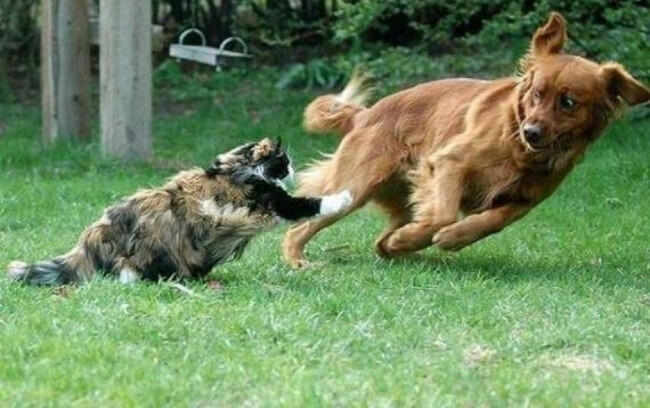
Dogs and cats have a range of interactions,with natural instincts of each species leading towards antagonistic interactions, while individual animals can have non-aggressive relationships with each other, particularly under conditions where humans have socialized non-aggressive behaviors.
The generally aggressive interactions between the species have been noted in cultural expressions.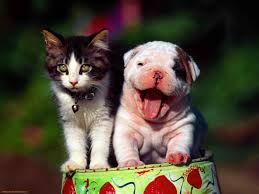
Range of relationships
The signals and behaviors that cats and dogs use to communicate are different and can lead to signals of aggression, fear, dominance, friendship or territoriality being misinterpreted by the other species. Dogs have a natural instinct to chase small prey that flee, an instinct common among cats. Most cats will flee from a dog, while others will take actions such as hissing, arching their backs and swiping at the dog. After being scratched by a cat, some dogs can become fearful of cats.
If appropriately socialized, cats and dogs may have relationships that are not antagonistic,and dogs raised with cats may prefer the presence of cats to other dogs.Even cats and dogs that have gotten along together in the same household may revert to aggressive reactions due to external stimuli, illness, or play that escalates.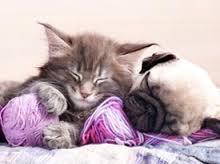
Cultural impact
The phrase "fight like cats and dogs" reflects a natural tendency for the relationship between the two species to be antagonistic. The phrase "to rain cats and dogs" comes from ancient beliefs that cats could make it rain and dogs controlled the wind. Other phrases and proverbs include "The cat is mighty dignified until the dog comes by" and "The cat and dog may kiss, but are none the better friends".
A Russian legend explains the antipathy between dogs and cats by stating that the devil has tricked the dog and cat into thinking the other has its rightful fur.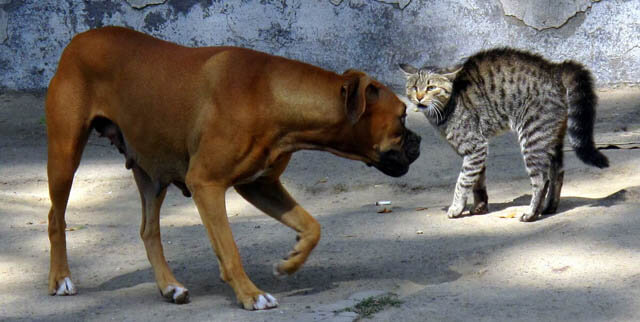
Eugene Field's children's poem, "The Duel" , projects and amplifies the real life antipathy between cats and dogs on to a stuffed gingham dog and calico cat about whom the narrator has been told had an all-night fight during which they "ate each other up." In Fam Ekman's children's book Katten's Shrekk (The Cat's Terror), a cat visits a museum to find that all of the artworks, like Mona Lisa and Venus de Milo, have been replaced by parodies featuring dogs. The only piece not converted is The Scream which "symbolizes the cat's terror in the face of so many dogs."The American animated television series CatDog featured the adventures of the protagonist, CatDog, a genetically altered creature that had the head of a dog on one side of its body and the head of a cat on the other. The episodes frequently played on "cats and dogs being what they are" to incorporate "a lot of running and chasing".

Music absolutely has an effect on pets' moods and this can be used to benefit their mental health. It has not been until recently that humans have begun to learn more about the influence of music on the emotional state of pets and if they have a similar response as people. However, research suggests that yes, animals do react well to certain types of music. Although, their musical preferences might differ from that of their owners. Concert pianist Lisa Spector and psychoacoustics researcher Joshua Leeds believe dogs, for instance, prefer classical music played slower and one octave lower than normal. One significant study, by Dr. Kogan from the Colorado State College of Veterinary Medicine, examined the effects of calming music on dogs in anxiety-provoking environments. The study looked at the behavior of 117 dogs who listened to heavy metal and classical music. It concluded that classical music provided a calming effect while metal caused agitation.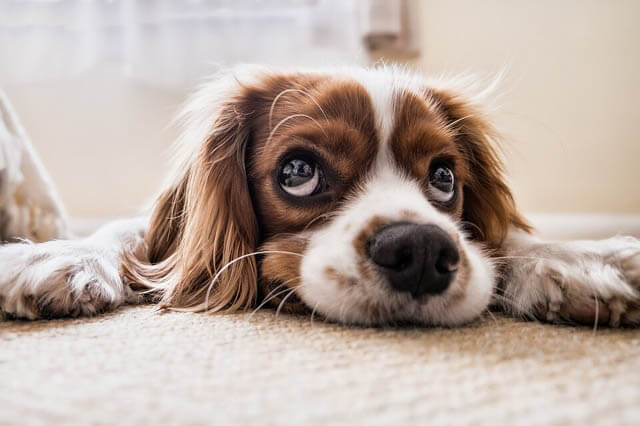
Despite these findings, there is still much to know about the effects of music on animals. Areas of the brain, the auditory cortex and multiple parts of the limbic system, come into play. These areas help regulate emotion. As a pet or human for that matter, listens to classical music, cortisol levels - the stress hormone lower in the blood. This provides the calming effect. While researchers are not certain on the specifics of relaxing music's influence on the brain, they know what the overall effect is on animals. Calming music and other sounds alter physiological processes in the autonomic system. This system in is charge of a pet's fight or flight mode and can cause an animal to panic or calm down. When relaxing, an animal will be less vocal, sleep better and have a slower heart rate.
While there has been some research on dog music, less is known about cat music and the effects of soothing sounds on our feline friends. Some folks speculate it is because they are uninterested in sound and music, but others hypothesize it's because cats have sound preferences that are different from that of dogs and humans. As mentioned earlier, dogs seem quite taken with classical music. Humans on the other hand gravitate toward rhythms similar to that of a mother's heartbeat.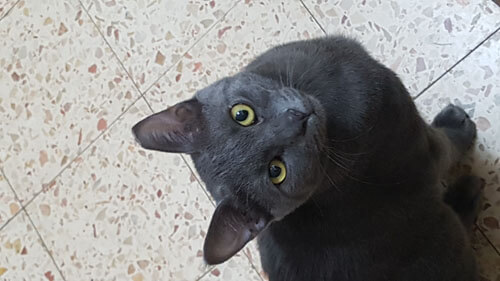
But cats? They like rhythm and sounds that they hear after being born. You might be unsurprised to learn that some of these sounds include purring and bird chirping. Interested in trying out some music therapy on your pets? You might find that classical music helps with your dog's anxiety when you are away from home or when fireworks are going off. For cats, you might want to try a nature sounds recording full of bird chirping. There are plenty of specific dog music and cat music recordings available for purchase online as well.
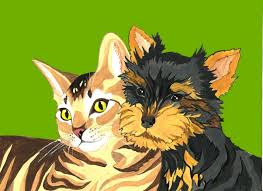
A Showdown at the Blanton Museum
Edward Hopper and his wife, Jo, spent their summers in South Truro, Massachusetts, on the tip of Cape Cod. Their neighbor was novelist John Dos Passos, whose wife bred Siamese cats. According to Francesca Consagra, a senior curator at the University of Texas at Austin's Blanton Museum of Art, one cat in particular, called Perkins, caught Hopper's eye. Perkins, named after editor Maxwell Perkins, became the subject of numerous sketches and studies by Hopper, which carefully depict the docile feline lounging around, stretching, and sleeping.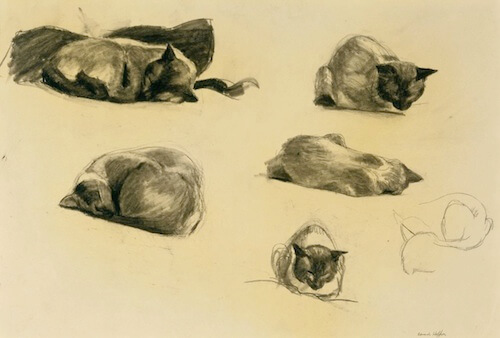
Hopper is one in a long line of artists, dating back to the ancient Egyptians, who have been influenced artistically by their four-legged friends. An exhibition opening this summer at the Blanton explores this 33-century-long fascination through more than 150 cat and dog-inspired paintings, sculptures, drawings, and etchings. Titled "In the Company of Cats and Dogs," the show will feature works by such artists as Pablo Picasso, Vasily Kandinsky, William Wegman, Dieter Roth, Francisco de Goya, and Louise Bourgeois.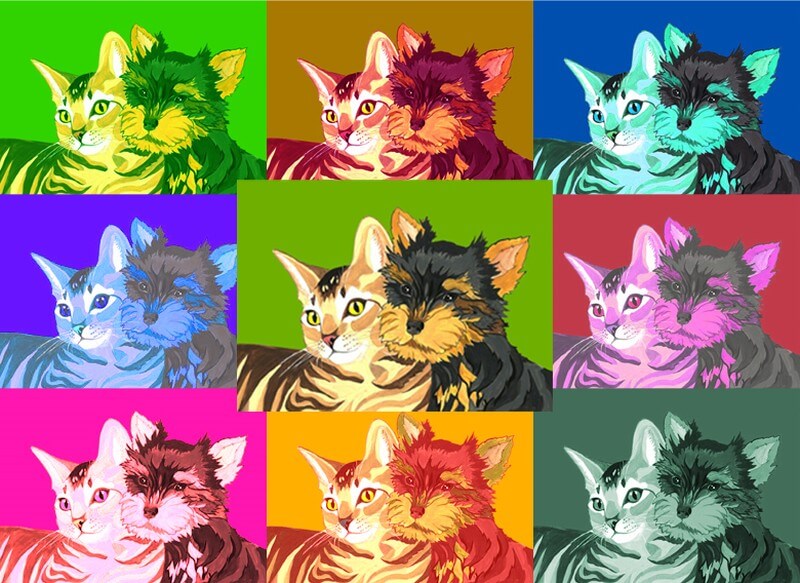
Curated by Consagra and organized with the help of the university's Anthrozoology department, the show will delve into the ever-changing dynamic between humans and their cats and dogs. Consagra will divide the works into nine sections, each highlighting one of the various roles animals have played throughout history. These roles include hunters and herders, human protectors, symbols of morality in literature and art, religious and mythological beings, and, of course, pets.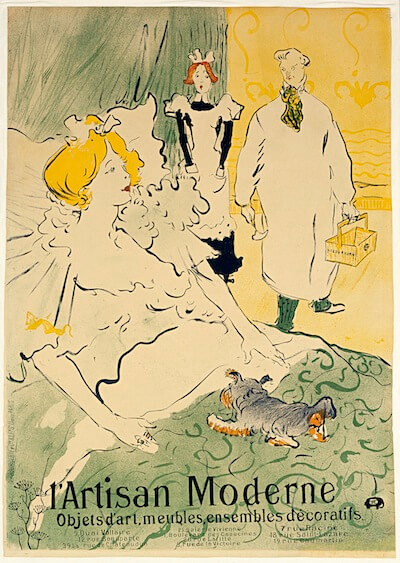
Images of cats and dogs have long represented unsavory traits. Cats have been associated with witchcraft and lasciviousness, while small lap dogs can symbolize laziness or promiscuity. The small dog in Henri de Toulouse-Lautrec's 1895 Poster for "L'Artisan moderne," for example, adds to the risque tone of the scene. The work, which is an advertisement for designer André Marty's home furnishings, riffs on the idea of a doctor making a house call and features an artisan with his toolbox tending to the needs of a bed-ridden woman. The dog's wagging tail and suggestive position on the woman's lap intimate that the nature of the craftsman's visit is more for pleasure than it is for business.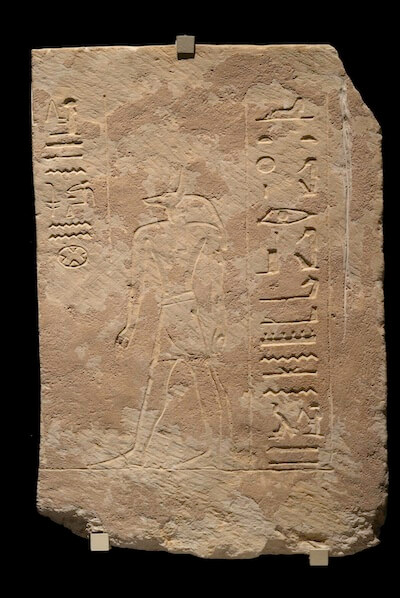
An ancient Egyptian panel from the sarcophagus of the scribe Menna will present viewers with one example of how people have ascribed sacred and mythical powers to animals. Etched in the panel is an image of Anubis, the jackal-headed god associated with mummification and passage into the afterlife. Depictions of Anubis often dressed the walls of burial sites, including the tomb of King Tut and the Temple of Ramses II.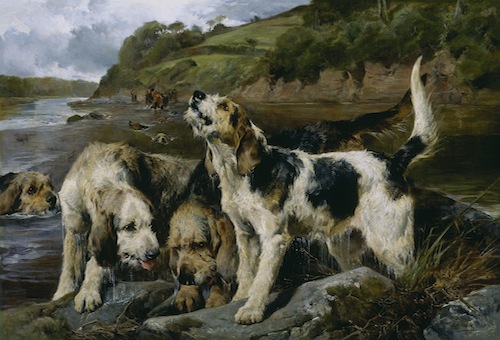
The hunting portion of the show celebrates animals for their keen tracking abilities. In John Sargent Noble's idyllic 1881 canvas Otter Hunting ("On the Scent"), a team of hounds flocks to the scent of its assigned prey. Wet from the swim to their target, the dogs obediently dig to retrieve the otter for their hunting party.
Cats, or "biological mouse traps," as Consagra calls them, will also be represented in this section. In Takahashi Hiroaki's 1931 woodblock print Cat Prowling Around a Staked Tomato Plant, a wide-eyed cat stalks its prey. Ready to pounce, the black and white feline maneuvers through a tomato plant, protecting the crop from unwanted visitors.
Otto Dix's 1968 Cat in Moon Landscape features a cat executing a similar task. Nimbly, the cat weaves its body through the long stems of a garden's pink and purple flowers. Its drawn claws and wide, glowing eyes indicate that it's on the prowl.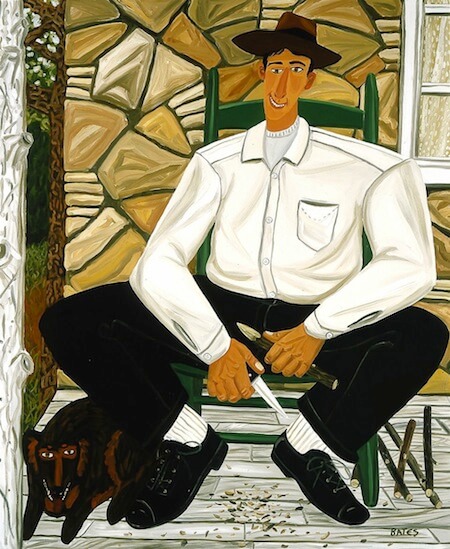
The final room of the show will be devoted to depictions of cats and dogs as domesticated companions. Among these works will be David Bates's soulful 1983 painting The Whittler. Executed in his trademark cartoonish style, the canvas features a smiling craftsman carving a piece of wood, while his faithful dog sits by his side.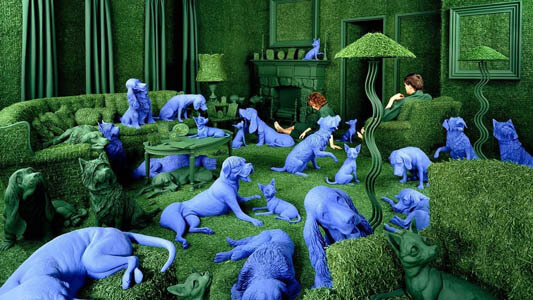
Hopper is one in a long line of artists dating back to the ancient Egyptians who have been influenced artistically by their four-legged friends. An exhibition opening this summer at the Blanton explores this 33-century-long fascination through more than 150 cat and dog-inspired paintings, sculptures, drawings, and etchings. Titled "In the Company of Cats and Dogs," the show will feature works by such artists as Pablo Picasso, Vasily Kandinsky, William Wegman, Dieter Roth, Francisco de Goya, and Louise Bourgeois.
Curated by Consagra and organized with the help of the university,s Anthrozoology department, the show will delve into the ever-changing dynamic between humans and their cats and dogs. Consagra will divide the works into nine sections, each highlighting one of the various roles animals have played throughout history. These roles include hunters and herders, human protectors, symbols of morality in literature and art, religious and mythological beings, and, of course, pet.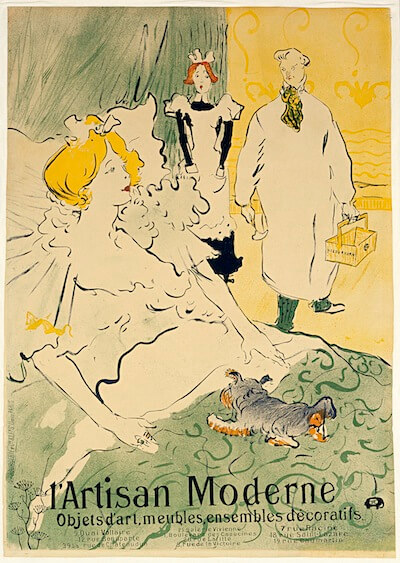
Images of cats and dogs have long represented unsavory traits. Cats have been associated with witchcraft and lasciviousness, while small lap dogs can symbolize laziness or promiscuity. The small dog in Henri de Toulouse-Lautrec's 1895 Poster for "L'Artisan moderne," for example, adds to the risque tone of the scene. The work, which is an advertisement for designer Andre Marty's home furnishings, riffs on the idea of a doctor making a house call and features an artisan with his toolbox tending to the needs of a bed ridden woman. The dog's wagging tail and suggestive position on the woman's lap intimate that the nature of the craftsman's visit is more for pleasure than it is for business.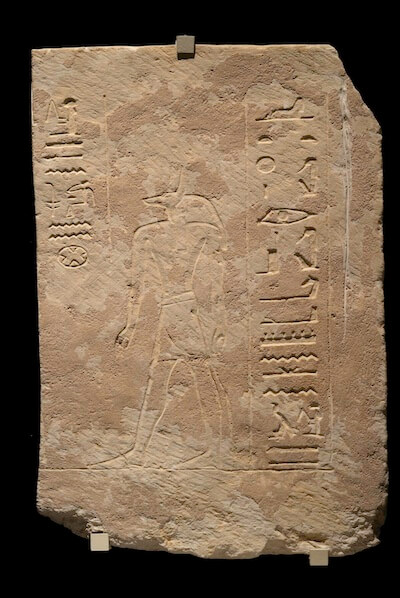
An ancient Egyptian panel from the sarcophagus of the scribe Menna will present viewers with one example of how people have ascribed sacred and mythical powers to animals. Etched in the panel is an image of Anubis, the jackal-headed god associated with mummification and passage into the afterlife. Depictions of Anubis often dressed the walls of burial sites, including the tomb of King Tut and the Temple of Ramses II.
The hunting portion of the show celebrates animals for their keen tracking abilities. In John Sargent Noble's idyllic 1881 canvas Otter Hunting ("On the Scent"), a team of hounds flocks to the scent of its assigned prey. Wet from the swim to their target, the dogs obediently dig to retrieve the otter for their hunting party.
Cats, or "biological mouse traps," as Consagra calls them, will also be represented in this section. In Takahashi Hiroaki's 1931 woodblock print Cat Prowling Around a Staked Tomato Plant, a wide-eyed cat stalks its prey. Ready to pounce, the black and white feline maneuvers through a tomato plant, protecting the crop from unwanted visitors.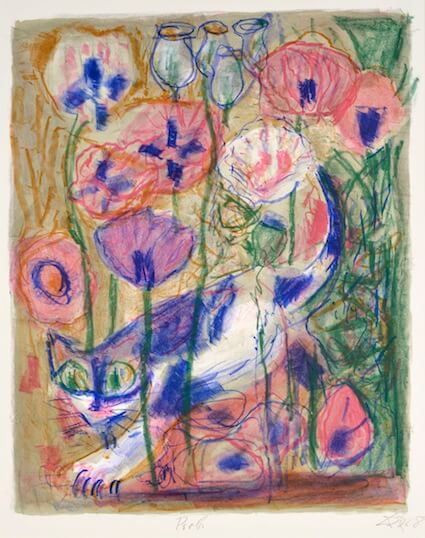
Otto Dix's 1968 Cat in Moon Landscape features a cat executing a similar task. Nimbly, the cat weaves its body through the long stems of a garden's pink and purple flowers. Its drawn claws and wide, glowing eyes indicate that it's on the prowl.
The final room of the show will be devoted to depictions of cats and dogs as domesticated companions. Among these works will be David Bates's soulful 1983 painting The Whittler. Executed in his trademark cartoonish style, the canvas features a smiling craftsman carving a piece of wood, while his faithful dog sits by his side.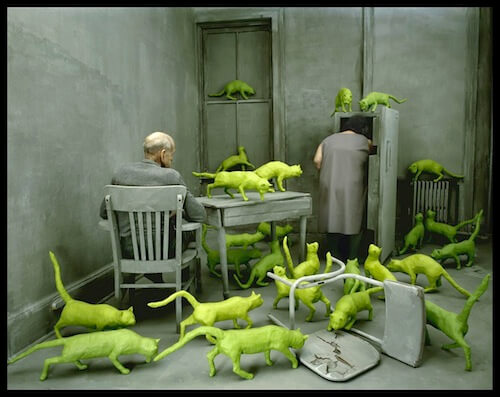
Sandy Skoglund presents an alternate interpretation of pet ownership in her trippy photograph Radioactive Cats. The work depicts an army of futuristic, DayGlo-green cats taking over the sterile, dreary home of an elderly couple. Crawling over the furniture and appliances, the creatures migrate towards the refrigerator, on an apparent mission for food.
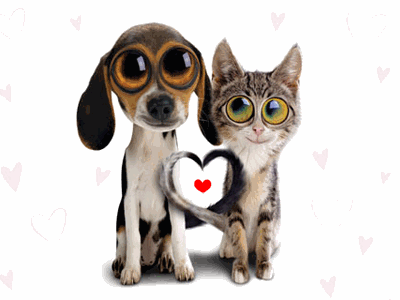
Vision.Cats win this one. Both animals are predators, which means their visual acumen stresses movement over detail. Neither cats nor dogs are going to read the type on road signs, and their color vision isn't as strong as ours, but a quick movement will get noticed even if it's minor. But give the gold to the cats for their ability to see in far less light. When the mousies come out to play at dusk, the cats are ready for them. A twitch of a whisker or a tiny movement in the leaves can be seen in near-darkness.
Smell. Dogs even the score with their sense of smell. There's a reason why you don't see drug-sniffing cats, and it's not just because cats aren't exactly amenable to clocking in for a 9 to 5 shift at the police station. While cats have a better sense of smell than humans do, really, we're pretty worthless in the nose department. The canine sense of smell is nothing short of astonishing. Most dogs have a face that's really nothing but nose, and their ability to detect and distinguish odors is in the range of four times better than a cat's.
Speed. Cats are natural sprinters, coiling and uncoiling their spines to blast off after prey or away from predators. For about the length of a suburban backyard, a cat can outrun and out jump a dog and can get over the fence before a dog can catch him. But that dash is going to take everything the cat has - he needs to rest after. Dogs such as Greyhounds can maintain speeds of 40 mph for a pretty good distance and can catch up to and pass a cat pretty quickly. Have to give this one to the dogs, by a nose.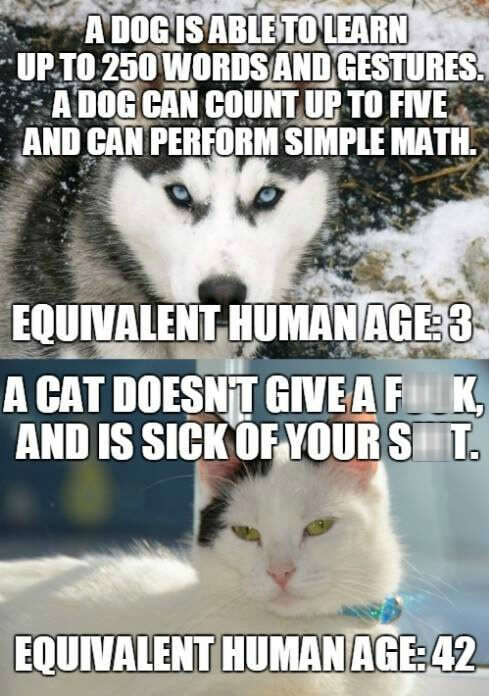
Endurance. Dogs are natural marathoners, and a fit dog such as a working sled dog can cover ground at a trot for hours. The only endurance sport a cat would win is napping, since the overwhelming majority of the feline day planner is filled with a single notation: "Zzzzzzzzzz." That's not a dig on cats, though: When they need to hunt for food they don't waste any time. They find, they kill, they eat and they nap.
Intelligence. Cat lovers can argue very effectively that cats are smart enough to get people to feed and care for them with little more than purring in return. Measured that way, it's hard to argue that dogs are smarter. But then you start listing all the jobs dogs have been trained to do, from smelling malignant tumors to taking down criminals, from finding and fetching birds to running an intricate agility course at top speed. And then there's the matter of language recognition: Many dogs know more than 100 words, and a few know almost twice that many. Cats? If they know more than the words you use to call them for dinner, they're not saying. Winner: dogs.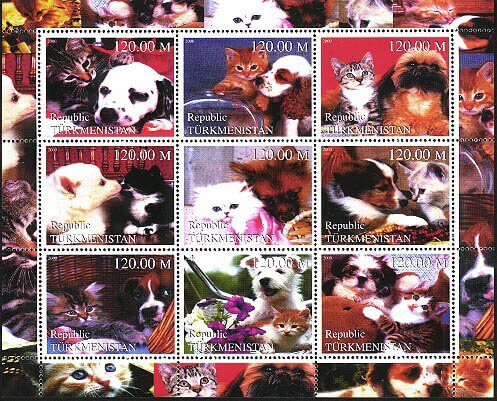
Domestication
Dogs are domesticated, cats domesticated themselves. Through its social behaviour the dog is focused on its master and wants to serve him. The cat moved in with man. The many different breeds of dogs differ much more among themselves than breeds of cats. Cats are what they are, they do not change. Dogs respond to selection.
Dog and Wolf
The dog was domesticated from the (gray) wolf. It is likely that domestication took place approximately 15,000 to 30,000 years ago in East Asia, when man gave up his nomadic existence, settled and became a farmer. At that time wolves started to seek the proximity of man and to eat from the food they wasted. Wolves howl when an enemy approaches, so they also protected the farmers. They tamed the wolf and the wolf adapted to the farmers. During domestication, the facial skull became shorter. In ancient Egypt dogs were often used for hunting. Even species that we no longer know as domesticated nowadays, such as cheetahs and hyenas, were held by the Egyptians. Until 100 years ago dogs had to stay outside, where they slept in doghouses. Especially in the last 200 years an explosive multiplication of breeding varieties has taken place.
Dogs have retained the social characteristics of wolves. They have a social hierarchy, the pack, in which the place of each animal is fixed. Because of that, dogs listen to their masters. And dogs can learn a lot and adapt to many situations.
Cat and Wildcat
The cat was domesticated from the (African) wildcat. Domestication occurred in Asia Minor, about 10,000 years ago. Cats were probably attracted by mice, who did well on the grain of the newly settled farmers. The farmers took kittens as pets in their houses and took care of them. The cats got used to being fed by people and they domesticated themselves. During this process the cat became tamer, but did not change anatomically, nor its behaviour. Feral cats can easily survive in the wild.



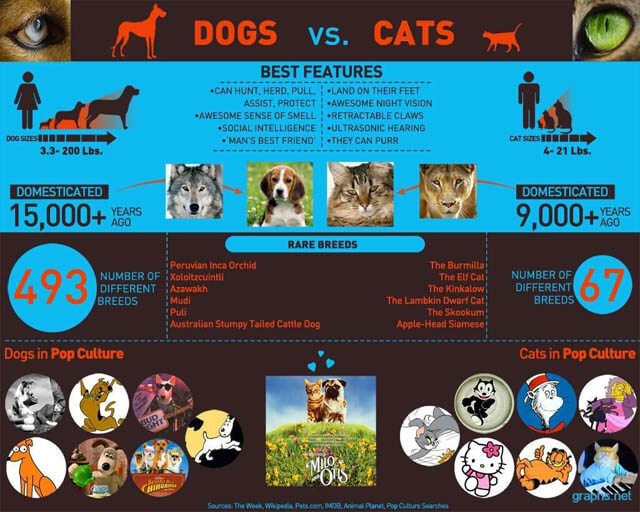



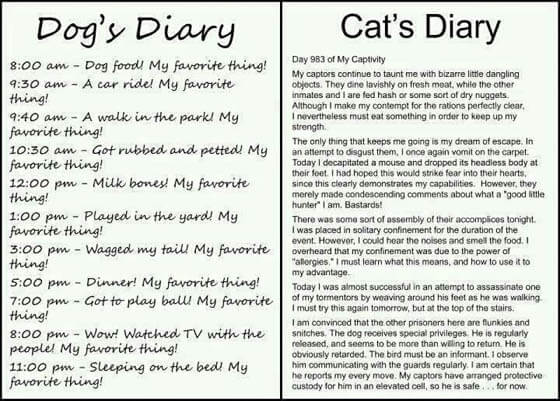


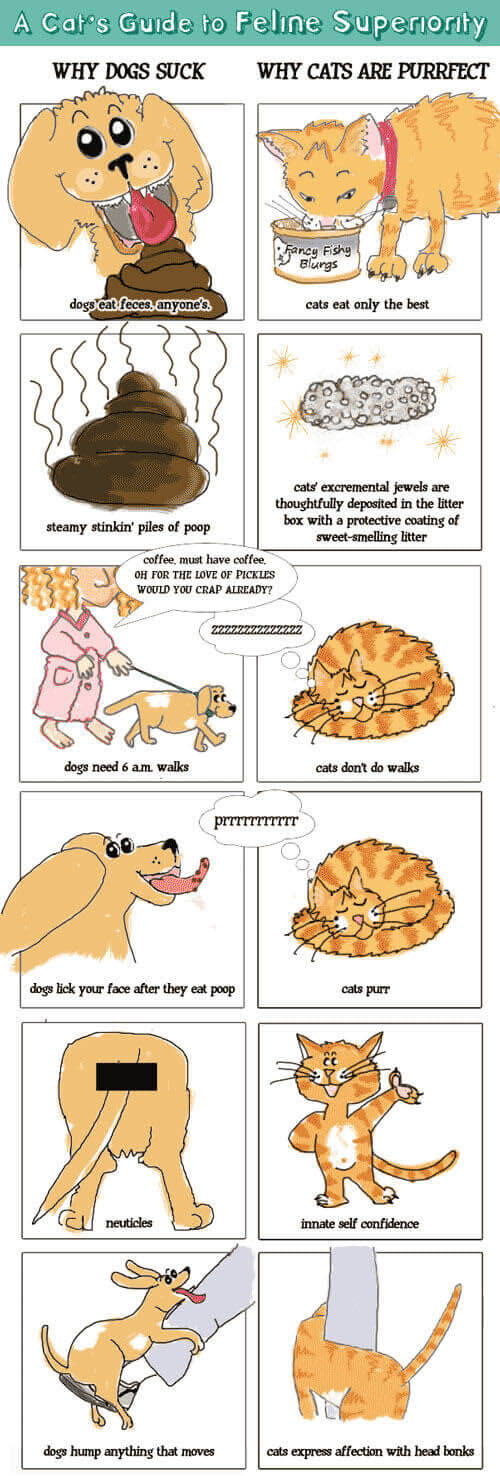

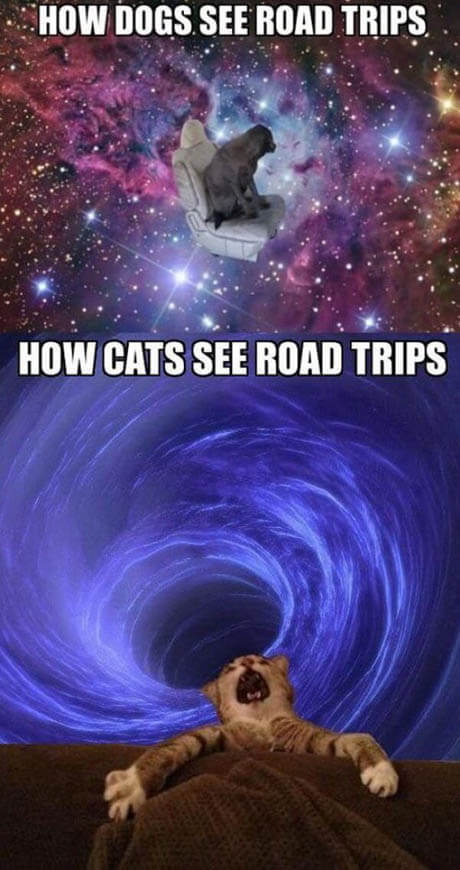


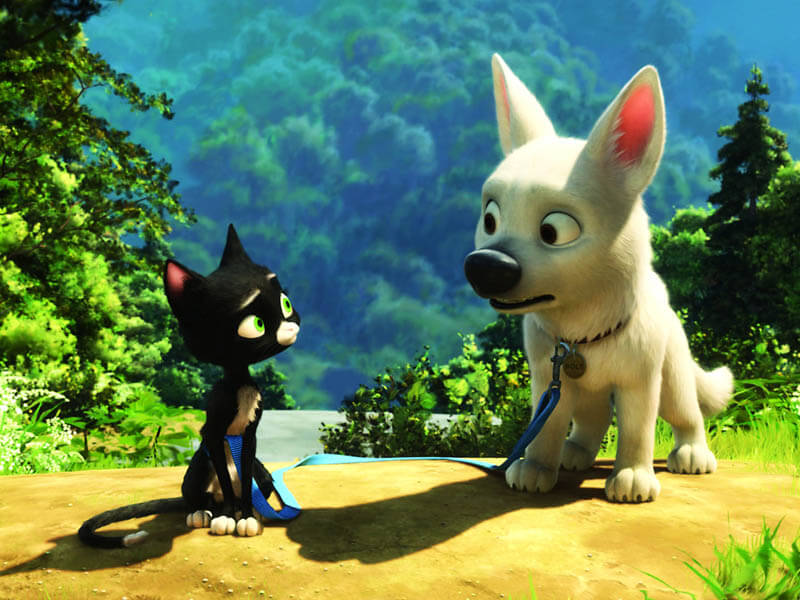



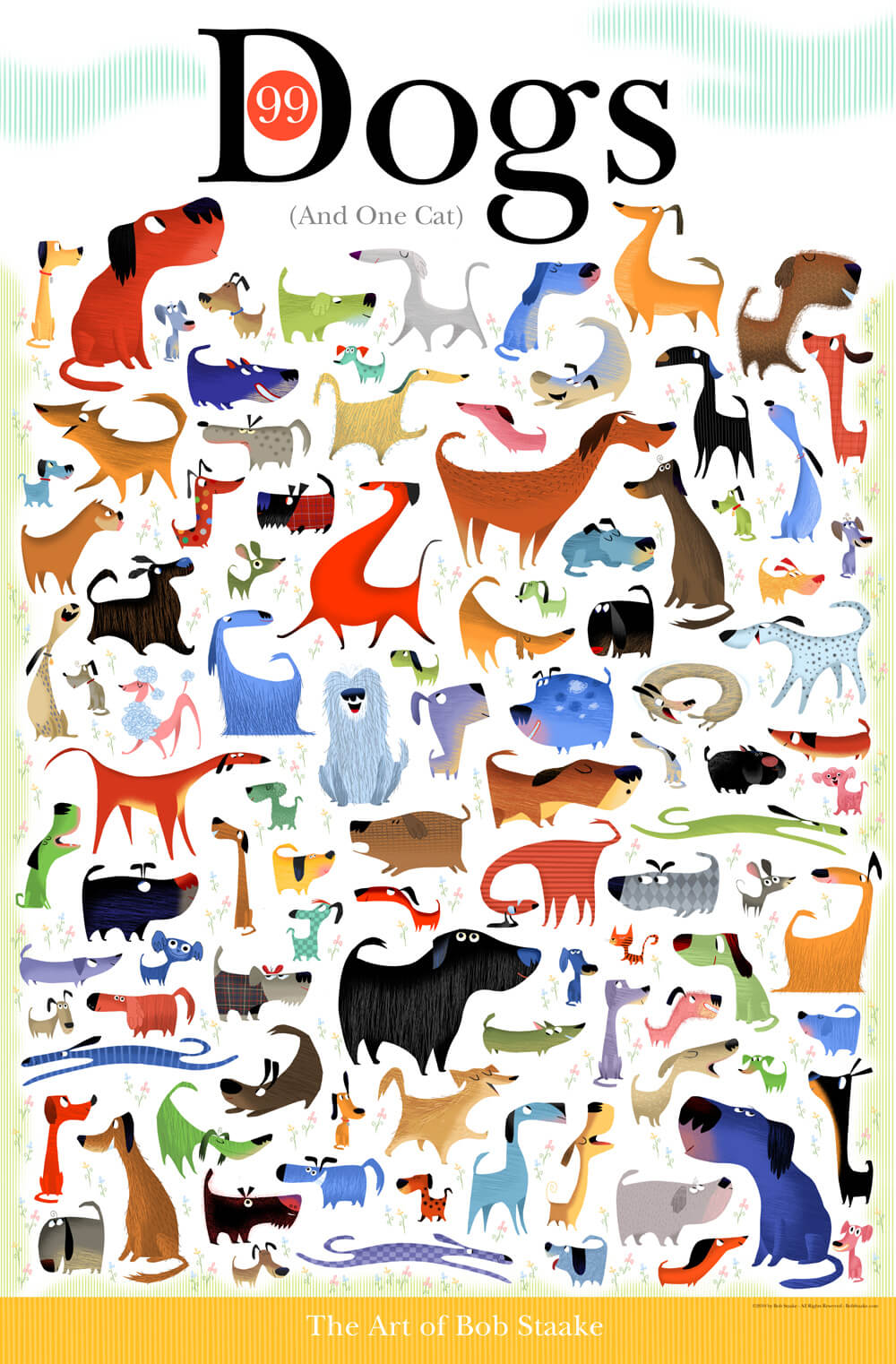
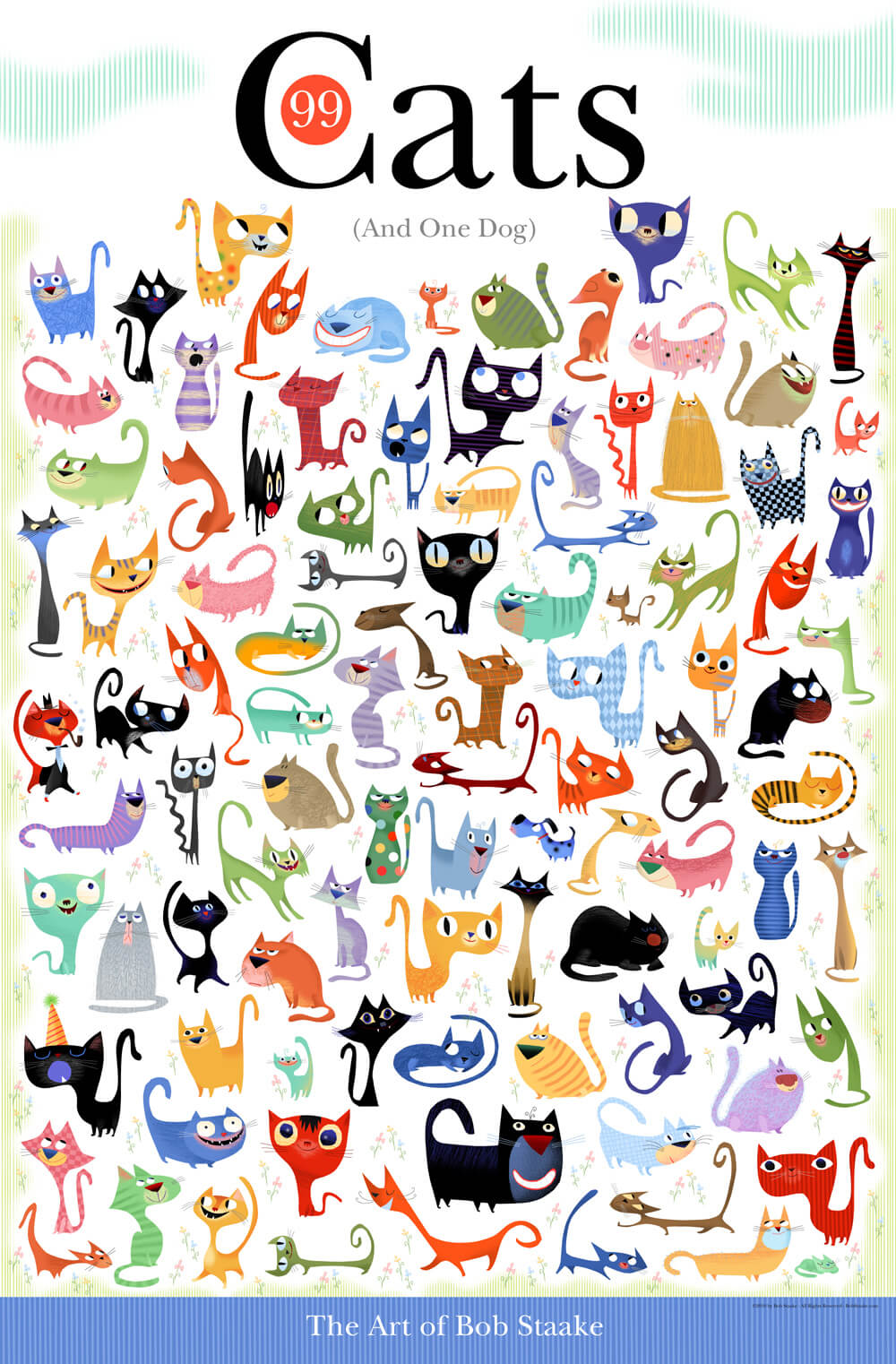
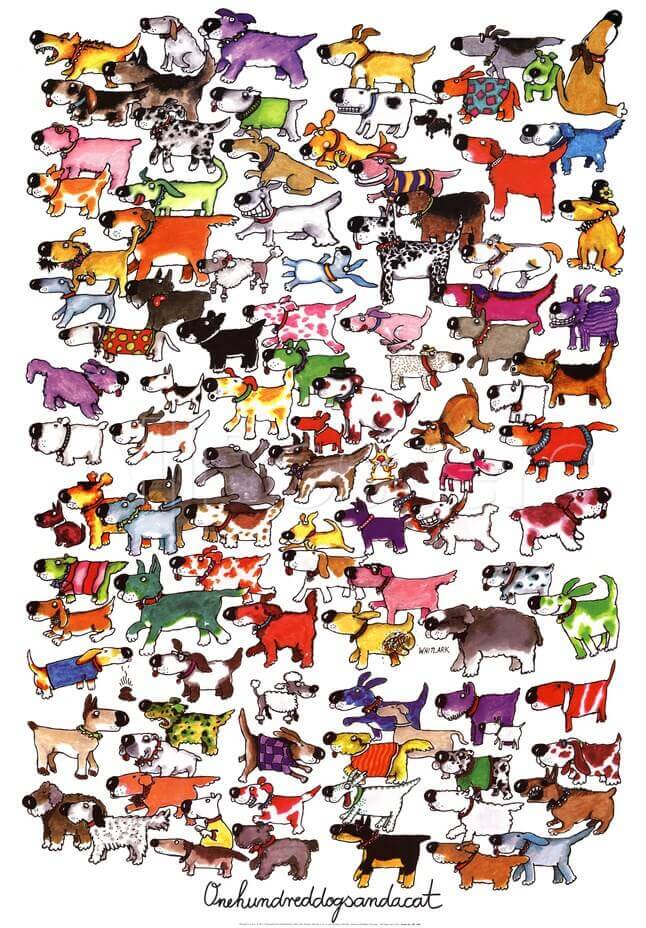
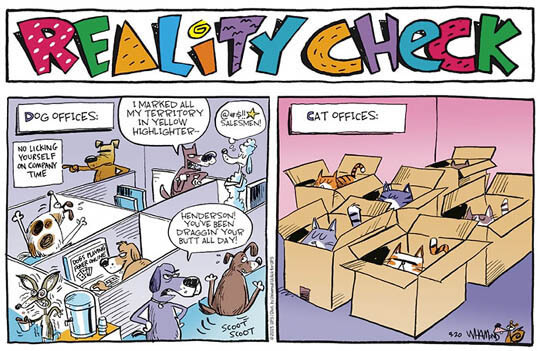
You see, cats and dogs have fundamentally opposite personalities that can naturally lead to very different relationships with their humans. Cats are usually more independent, cunning and do not particularly need your love and affection. On the other hand dogs are more social creatures, playful, friendly and dare we say it, a little dumb at times.